18. WORLD WAR TWO

THE WAR IN EUROPE
CONTENTS
 Opening up the Western Front against Opening up the Western Front against
Hitler
 Stopping the Germans on the Eastern Stopping the Germans on the Eastern
Front
 The slow Allied advance in Italy The slow Allied advance in Italy
 The liberation of France The liberation of France
 The Soviet summer offensive ... and the The Soviet summer offensive ... and the
destruction of Warsaw
 The Germans hold the line in the The Germans hold the line in the
Netherlands ... and attack in Belgium
 The Western Allies push into a fast- The Western Allies push into a fast-
collapsing Germany
The textual material on this webpage is drawn directly from my work
America – The Covenant Nation © 2021, Volume Two, pages 30-39.
A Timeline of Major Events during this period
| 1940s |
The war on the European front
1941 Hitler's offensive in Russia comes to a halt as a harsh Russian winter sets in
1942 Americans join with the British in attacking the Southern German-Italian flank along the Mediterranean coast of North Africa (Oct-Nov)
The Germans, having resumed their action against Russia (Jun) now find
their progress halted at the city of Stalingrad (Nov-Dec) ... as another brutal winter sets in
1943 The surviving – and surrounded – German troops at Stalingrad are forced to surrender (Feb) ...beginning the Russian
counteroffensive against the Germans; a huge battle at Kursk (Jul-Aug) destroys much of the German army
The
British-American Allied troops take Sicily from the Germans and
Italians (Aug) ... at which point the Italians
drop out of the war (Sep) ... having already deposed Mussolini (Jul);
the Germans continue the fight from the mountains in Italy
1944 The Americans decide to do an end run around the Germans with a coastal landing in Anzio (Jan) – but wait too long to
get off the beach ... and find themselves trapped there (until May)
The long-awaited
cross-channel offensive against the Germans takes place at Normandy
(Jun) ... beginning the
German retreat in France; the same day, American troops enter a freed
Rome
Representatives of the Allies or "United Nations" gather at Brreton
Woods (New Hampshire) to plan for the coming post-war economic and financial challenges (Jul)
The Russians
advance against the Germans all the way up to Poland's capital, Warsaw
(Aug) and then halt ... so as to let the Germans finish off the Polish resistance ... thus leaving Poland
defenseless against an expansive Russia; then the Russian resume their
advance (Oct)
Roosevelt is reelected to his fourth presidential term (Nov)
A hoped for Allied swing north into Germany from the Netherlands stalls
(Nov); then the Germans attempt a
counter attack against American troops in Eastern Belgium ... which
also fails (Dec)
1945 Russian and American-British troops now find themselves in a collapsing Germany (Jan) ... with the Russians most
likely to reach Berlin first (located in northeastern Germany)
|
OPENING UP THE WESTERN FRONT AGAINST HITLER |
|
Both Roosevelt and Churchill agreed that although
both countries had a vital interest in defeating the Japanese in Asia,
their priority would be to concentrate on defeating Hitler in Europe.
With Germans at the gates of Moscow and Leningrad (St. Petersburg)
during the winter of 1941-1942, the Russian situation looked desperate.
Stalin immediately began pushing the Americans and British to open up a
front in the West so as to take some of the German pressure off the
Russians. He was also growing suspicious that his new Western Allies
were holding off confronting Hitler directly in the hope that while
they dallied, both Germany and Russia would exhaust themselves in
mutual conflict – a suspicion Stalin held deeply because it was exactly
the strategy he had employed (in reverse) with the Molotov-Ribbentrop
treaty!
The ill-fated Dieppe Raid (August 1942)
The Americans were anxious to conduct a
direct assault on Hitler's Reich with a massive landing on the shores
of France. But an attempt at this in August of 1942 at Dieppe
("Operation Jubilee") resulted in a tragic disaster for the Allied
troops (mostly Canadian) when the Germans simply slaughtered them on
the beaches. That memory would long haunt the Allies, even when two
years later a second attempt was scheduled to take place on the beaches
of Normandy. In the meantime, the Allies' delay in opening up a second
European front – helping relieve some of the pressure on the Russians –
would continue to irritate Stalin deeply during those two years.
The Allied action in North Africa
Instead, the British and Americans
focused their efforts in attacking Hitler’s Reich in its soft
under-belly of North Africa – at the same time reopening the more
direct British path to their forces in Asia by way of the Mediterranean
Sea. The British, under General Bernard Montgomery, would take up the
North African offensive from the East and the Americans (under a
variety of generals) from the West. Montgomery achieved glory with his
grand victory over the troops of the famed German General Erwin Rommel
at El Alamein (November 1942) and then the subsequent roll-back and
capture of German and Italian troops in huge numbers along the Libyan
coast. The Americans, being entirely new in battle, landed also in
November at undefended Morocco, crossed French Algeria (after much
political maneuvering with Vichy France’s Admiral Darlan) and then got
mauled in their first major battle with the Germans in February (1943)
at the Kasserine Pass in western Tunisia. But the Americans recovered
from the humiliation, moved forward and in May finally joined up with
the British at Bizerte and Tunis, as the Germans and Italians (those
that could anyway) made their escape to the nearby island of Sicily.1
1As a result of this victory, the Allies found themselves in possession of a quarter of a million German and Italian prisoners.
Allied disaster at Dieppe (August 1942)
 Bodies of a Canadian soldier and a U.S.Army Ranger lying among damaged landing craft and "Churchill" tanks
of the Calgary Regiment following "Operation Jubilee"
Bodies of a Canadian soldier and a U.S.Army Ranger lying among damaged landing craft and "Churchill" tanks
of the Calgary Regiment following "Operation Jubilee"
Library and Archives Canada
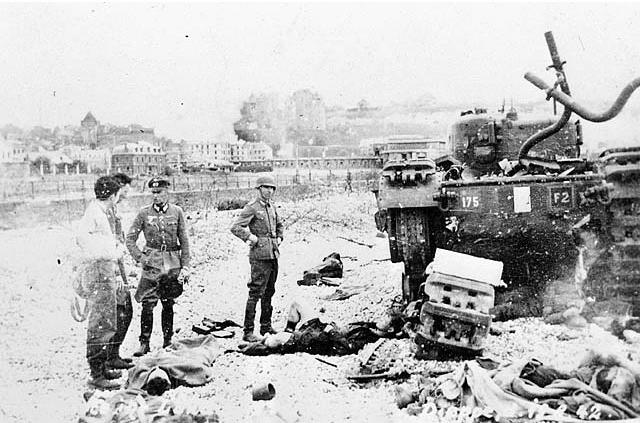 German Officers standing on Dieppe beach
among Canadian dead and wounded
German Officers standing on Dieppe beach
among Canadian dead and wounded
Library and Archives Canada
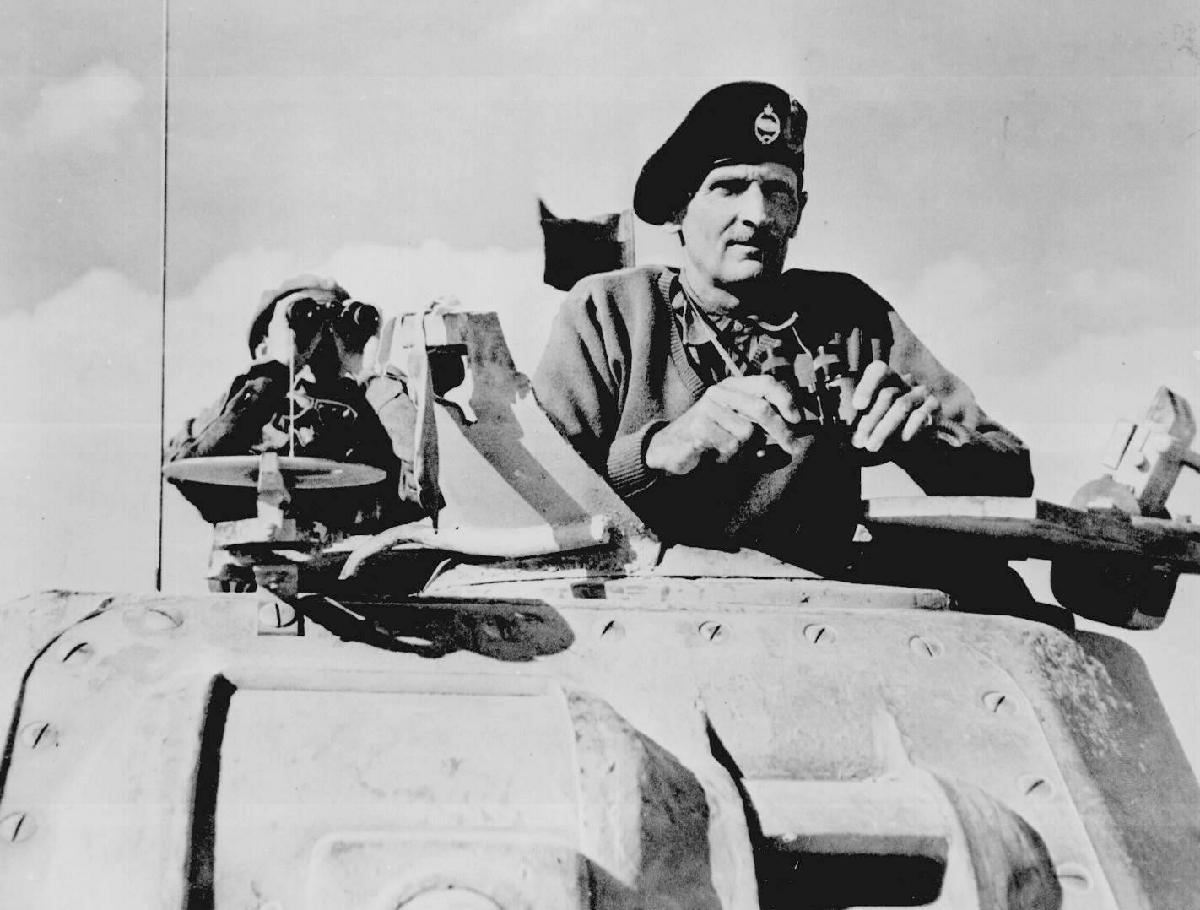
"General Bernard L. Montgomery watches
his tanks move up." North Africa, November 1942.
National Archives
208-PU-138LL-3
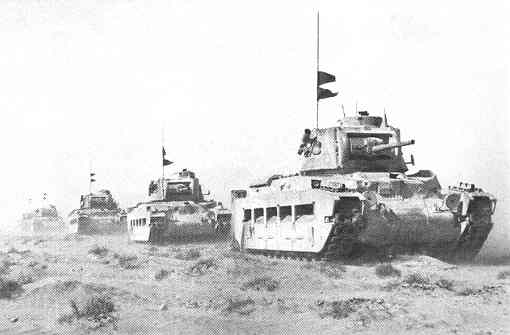 British tanks in
North
Africa
British tanks in
North
Africa
National Archives
|
On the night of October 23rd (1942), the
British 8th Army, commanded by Alexander and led by Montgomery, began their
counterattack at Alamein on the German Afrika Korps led by Rommel.
The British broke through the German center and by November 4th had encircled
huge numbers of German and Italian troops – and had a broken Afrika Korps
falling back rapidly across northern Libya to avoid total
annihilation. |
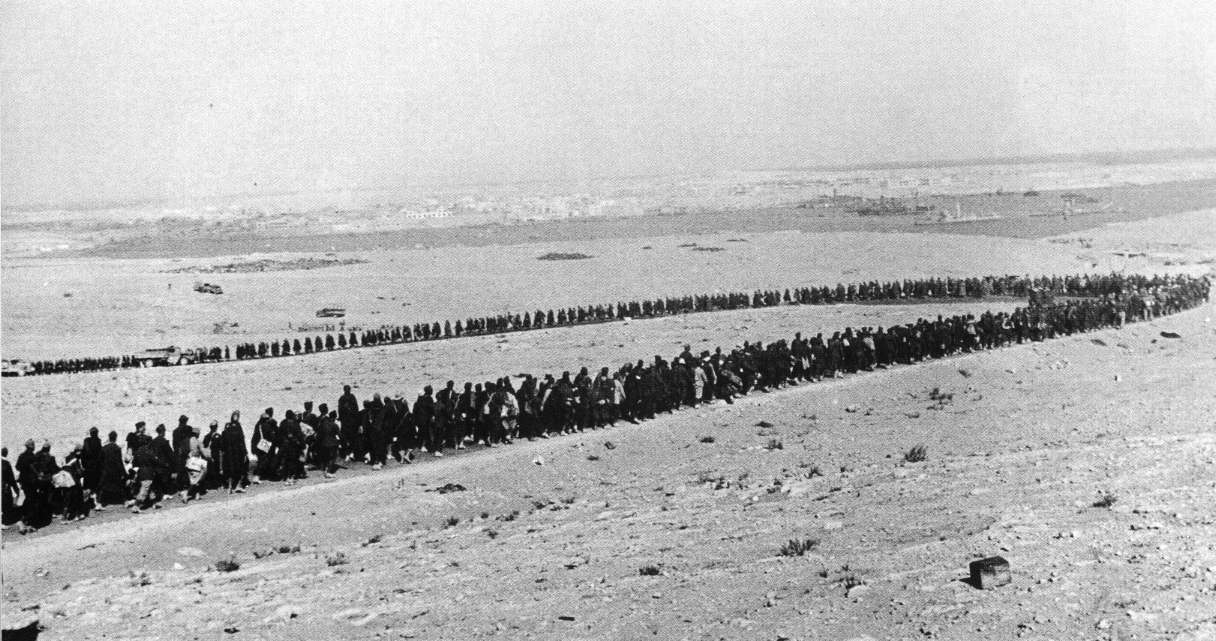
19,000 Italians and
6,000
Germans taken prisoner at the Libyan port of Tobruk
British War
Office
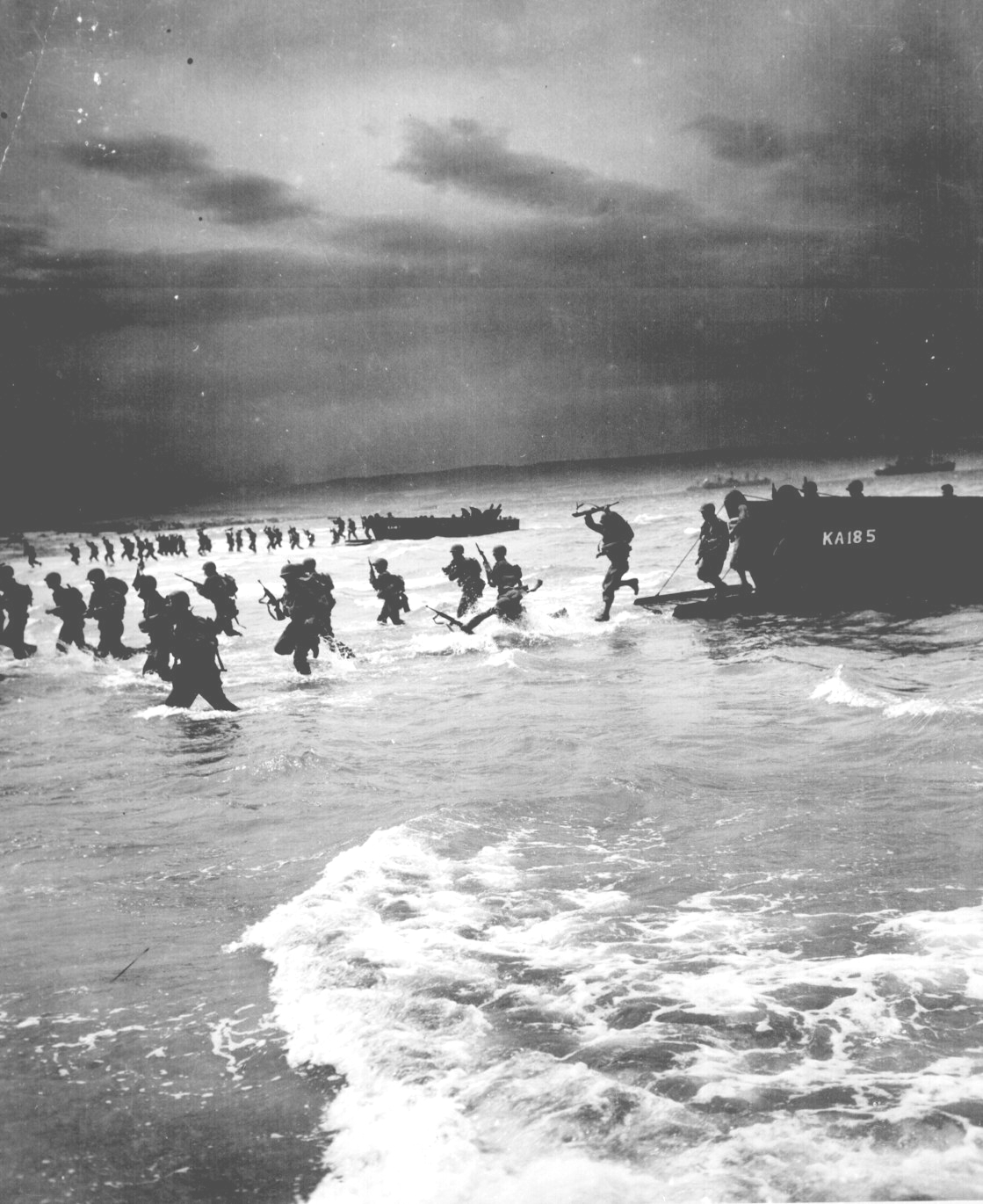
From Coast Guard-manned
"sea-horse"
landing craft, American troops leap forward to storm a
North African beach during
final amphibious maneuvers." James D. Rose, Jr.
National Archives
26-G-2326
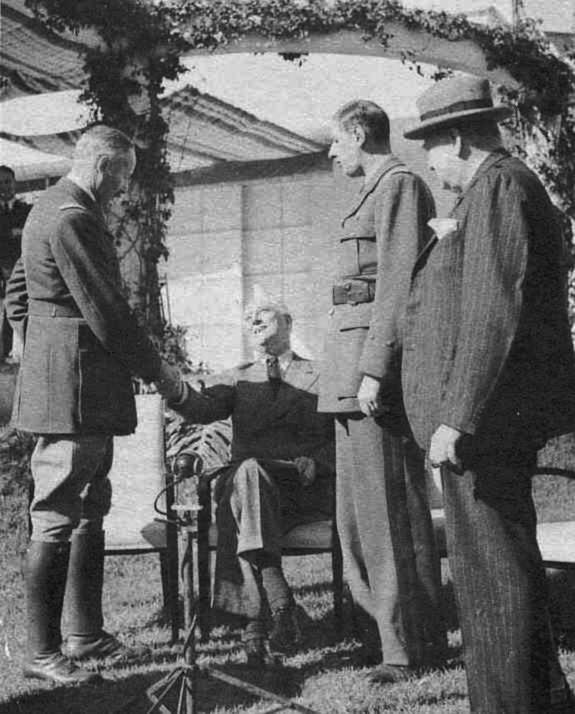
Giraud,
Roosevelt, De Gaulle,
Churchill – Casablanca Conference – January 1943
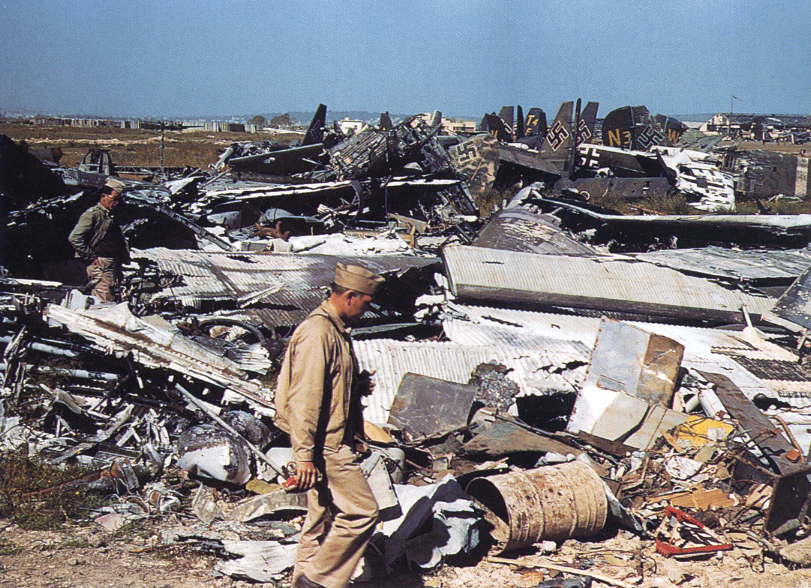
A GI surveying the
wreckage
of German planes at Tunis in May 1943 (at this
point North Africa was now cleared of all Axis
forces)
STOPPING THE GERMANS ON THE EASTERN FRONT |
,p>
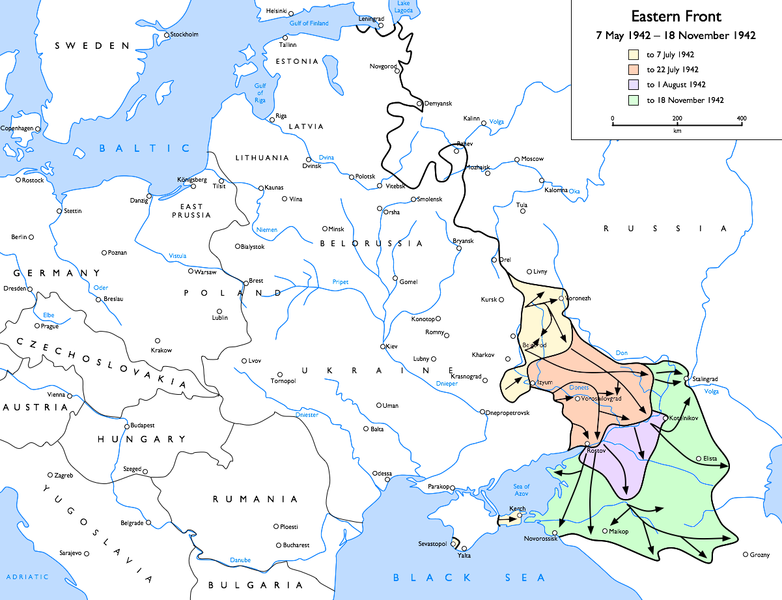
Hitler focusses not on the
capture of Moscow, but on the seizing of the grainlands of the Ukraine and
Southern
Russia and the oil fields at the Caspian Sea. His troops advance all-out effort to hold the city. This will be as far as the
Germans will advance against Russia ... before they begin to slowly fall
back. Meanwhile, the surrounded
city of Leningrad (St. Petersburg) holds out against the Germans
(September 8, 1941 – January 27,
1944)
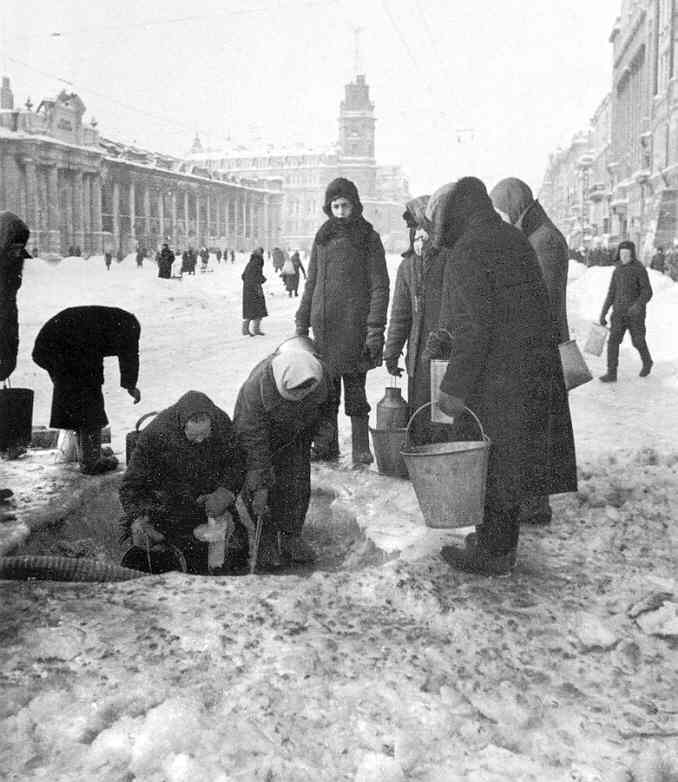
Russians looking
for water
in Leningrad during the German encirclement
Sovfoto/Eastfoto
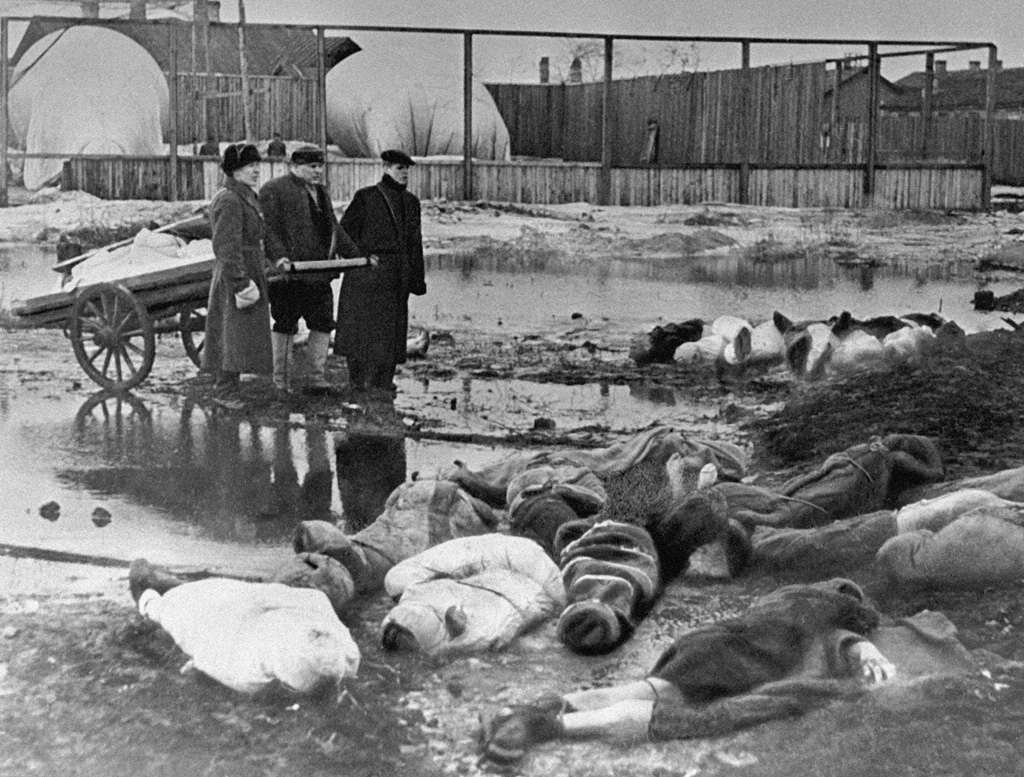
Burying victims
of Leningrad's
siege at the Volkovo cemetery – October
1942
RIA Novosti archive
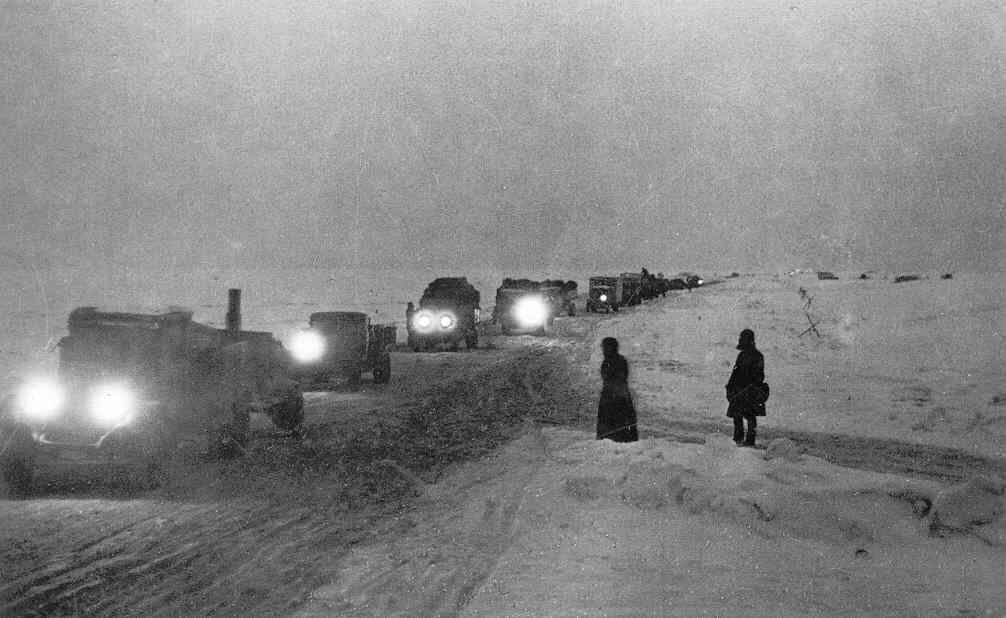
Supplies being
brought into
Leningrad across frozen Lake Ladoga
Sovfoto/Eastfoto
|
In June of 1942, Hitler resumed his effort to head
his troops towards Stalingrad. But the Russians were under orders that
under no circumstances were the Germans to be allowed to take this
Russian stronghold (any Russians attempting a retreat or escape would
be executed on the spot by their senior officers). And the
Russians
indeed held, as murderous as the situation became. But it was
equally
murderous for the Germans, who finally showed up at the outskirts of
Stalingrad in November – just as another Russian winter also showed
up.
By this time however the German supply line to their front lines was
vastly overstretched. And the Russians succeeded in swinging
around
behind the main German force (Hitler’s Sixth Army) and proceeded to
isolate them. But Hitler foolishly refused to allow his Sixth
Army to
pull back from this trap. Total disaster resulted for the Germans.
Now the Germans found themselves in retreat in Russia.
|
The Battle of Stalingrad
-- August 23, 1942 – February 2, 1943
|

|
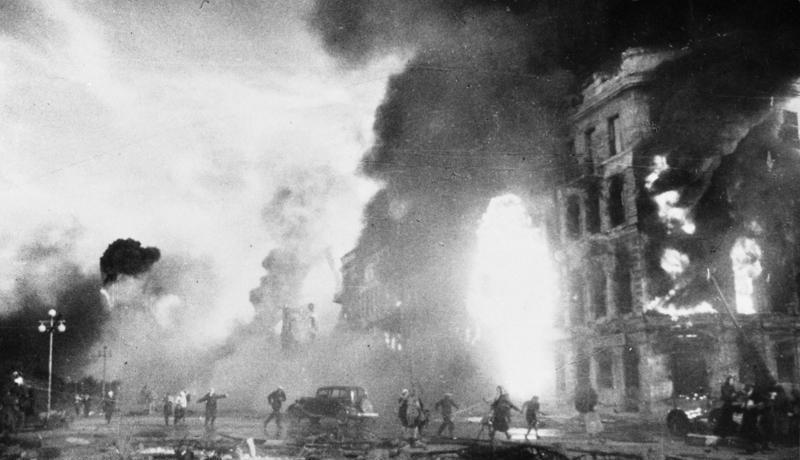 Civilians fleeing the destruction
of Stalingrad
Civilians fleeing the destruction
of Stalingrad
German Federal Archives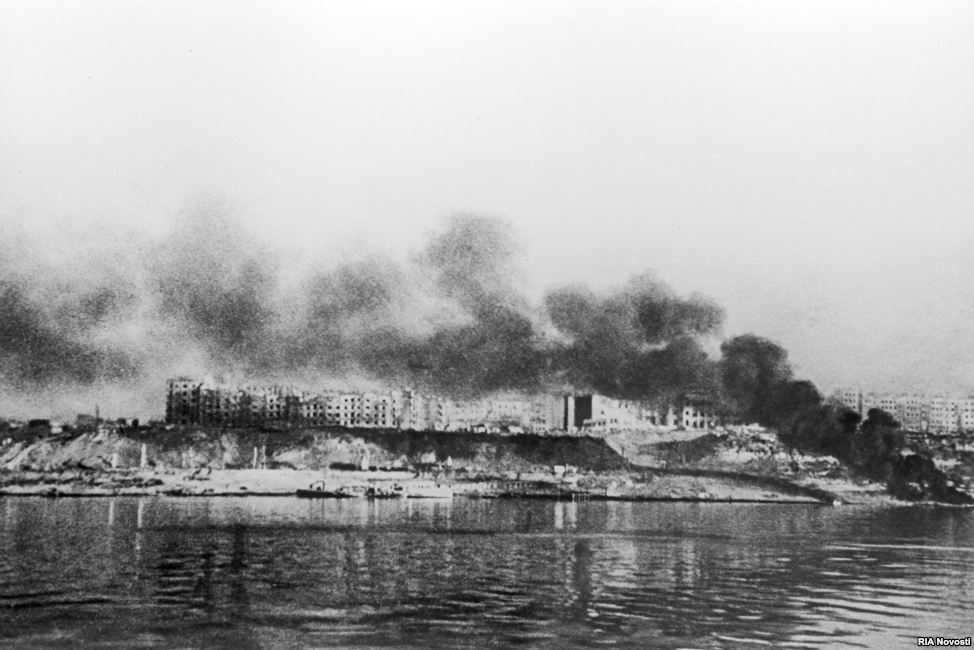
View from the East
bank of
the Volga River of Stalingrad under attack – August
1942
RIA Novosti Archive
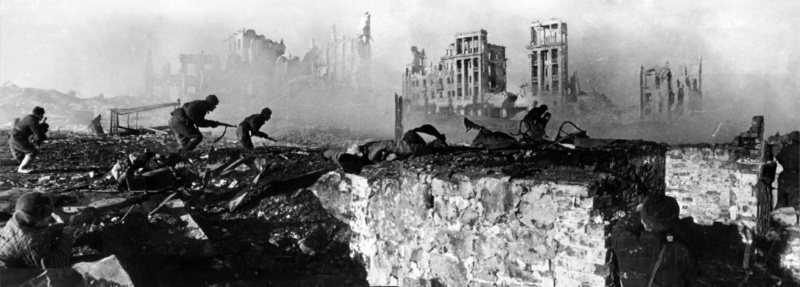 Soviet troops moving
against
the Germans at Stalingrad
Soviet troops moving
against
the Germans at Stalingrad
Sovfoto/Eastfoto
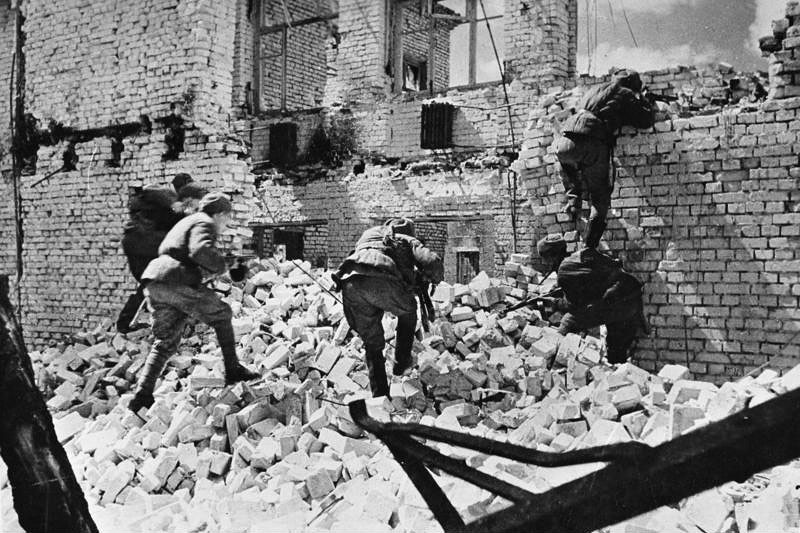
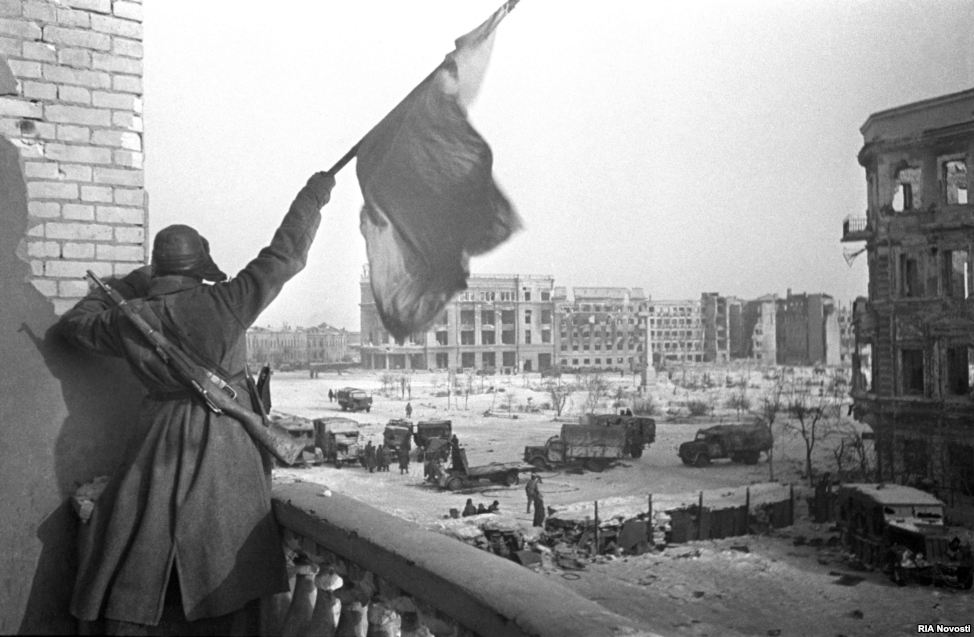
A Soviet soldier
waving the
Red Banner over the central plaza in Stalingrad,
1943
RIA Novosti Archive
Radio Free Europe/Radio
Liberty Germans, done in by
Russia's
harsh winter conditions, surrendering to
Russians
Germans, done in by
Russia's
harsh winter conditions, surrendering to
Russians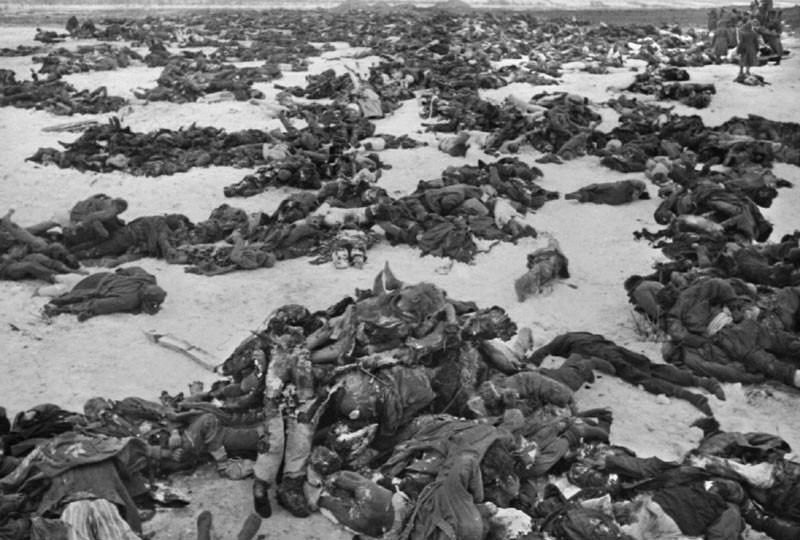
Masses of dead
soldiers at
Stalingrad
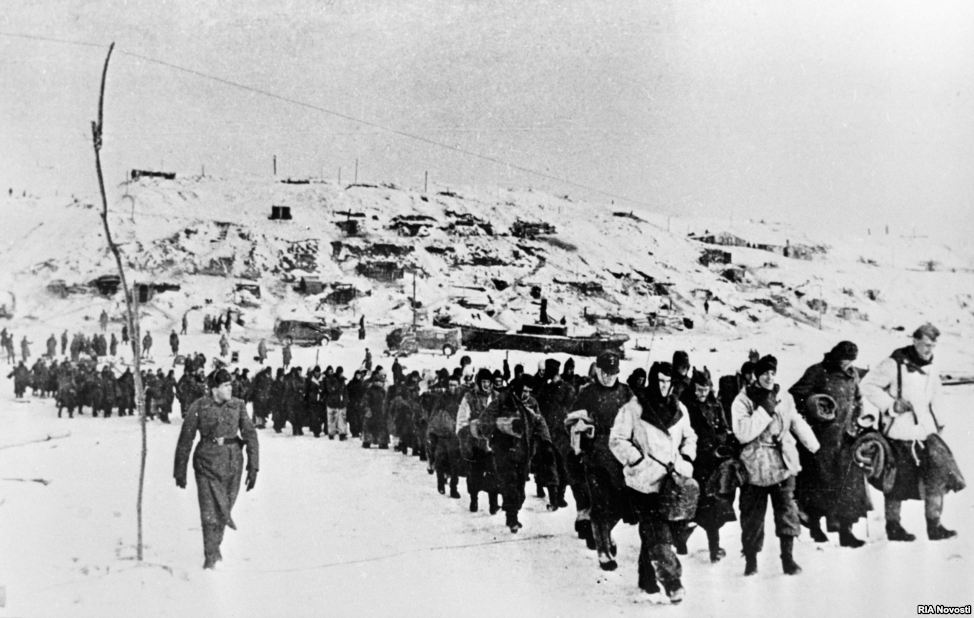
Out of the
100,000 German
soldiers who survived long enough to surrender, only about 6,000 of them
would ever make it back to Germany
RIA Novosti Archive
Radio Free Europe/Radio
Liberty
The Soviets now undertake a huge counter-offensive against the Germans
The Battle of Kursk – July
1943
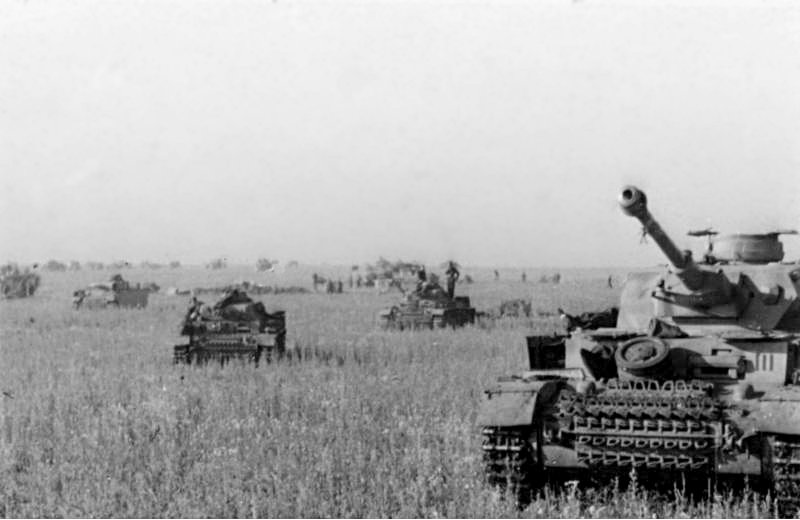
German
tanks at the Battle
of Kursk- summer of 1943
Bundesarchiv
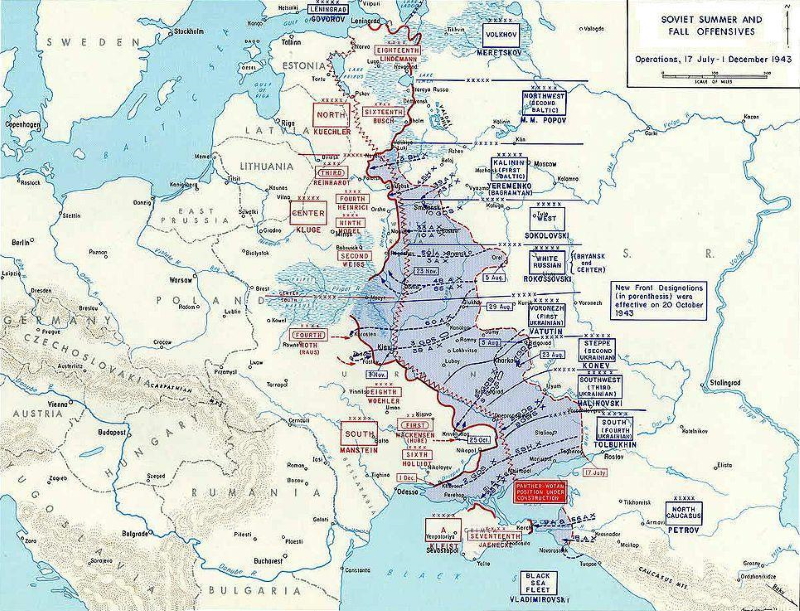
The Soviet
advance in East
Europe – second half of 1943
Wikipedia – "Battle of the
Dnieper"
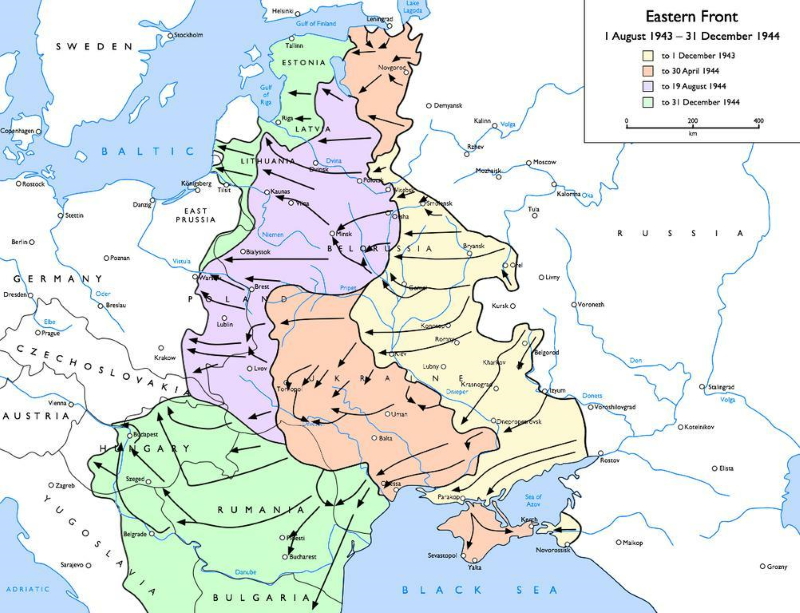
Soviet advances on the
Eastern Front (WWII), August 1, 1943 to December 31, 1944
Wikipedia – "Eastern Front
(World War II)"
The Summit
Conference at Tehran (Iran) – November 28 – December 1, 1943
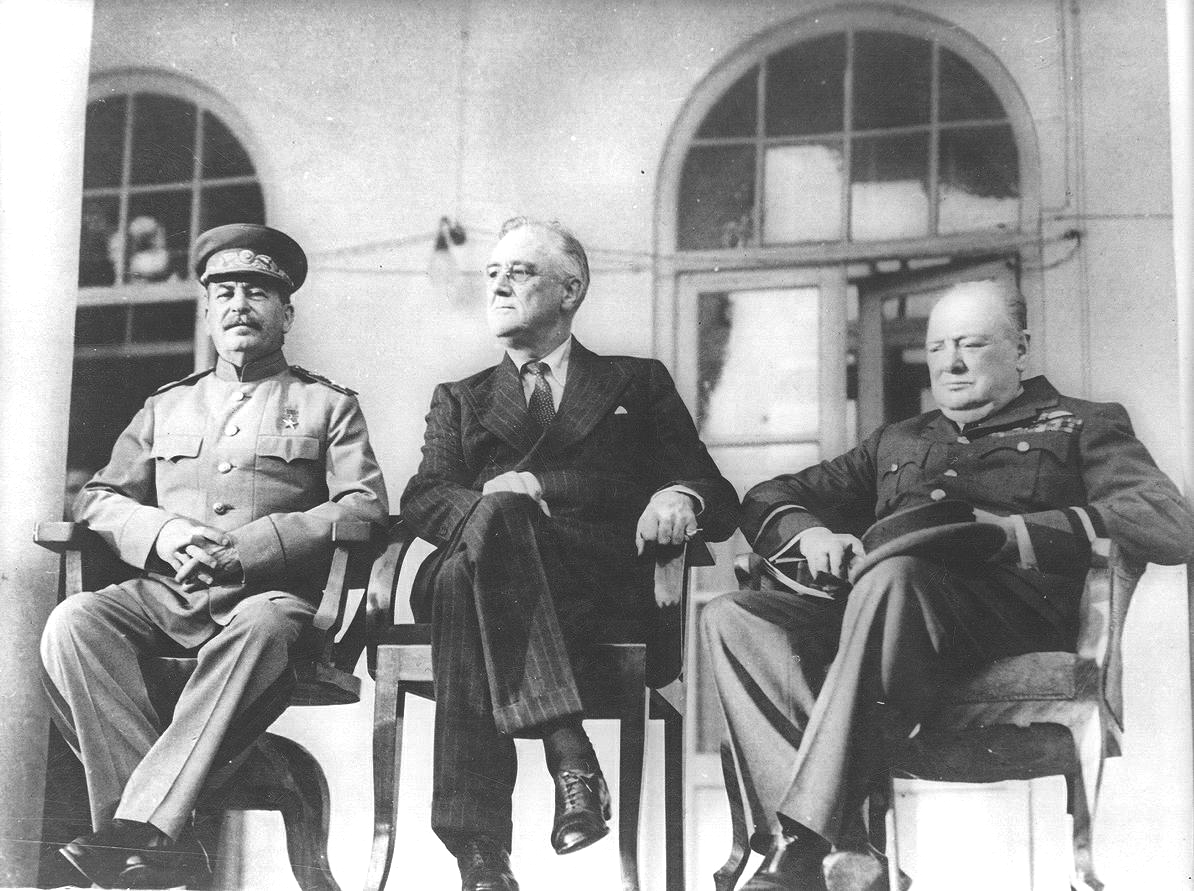
Stalin, Roosevelt
and Churchill
at the Tehran Conference – 1943
THE SLOW ALLIED ADVANCE IN ITALY |
|
The Allied campaign in Sicily and Southern Italy (1943-1944)
The British under Montgomery and the Americans
under General George Patton followed the escaping Germans and Italians
onto the island of Sicily and within a month (July-August) succeeded in
driving the Axis troops from that island as well.2
Once again, numerous Axis troops made
their escape to the nearby Italian peninsula, avoiding the possibility
of being trapped in Sicily. But at this point, the Italian government
was tired of the game, and in July had already dismissed and arrested
Mussolini – and had opened armistice discussions with the Allies,
resulting in the Italians dropping out of the war in September.
For Hitler’s troops there was no such
option – and they dug into the heights of the central mountain chain
that runs the length of the Italian peninsula, determined to give up
not even an inch without a ferocious defense against the Allies now
positioned in Southern Italy. At this point the Allied advance ground
down to a brutally slow pace.
2The
huge egos of both Montgomery and Patton often made it appear that they
were more interested in competing against each other for the glory of
victory in battle than in just simply defeating German and Italian
enemies! This rivalry (and others like it) would be a continuing
problem for General Dwight D. Eisenhower as he attempted to coordinate
the efforts of the various Allied armies under his command.
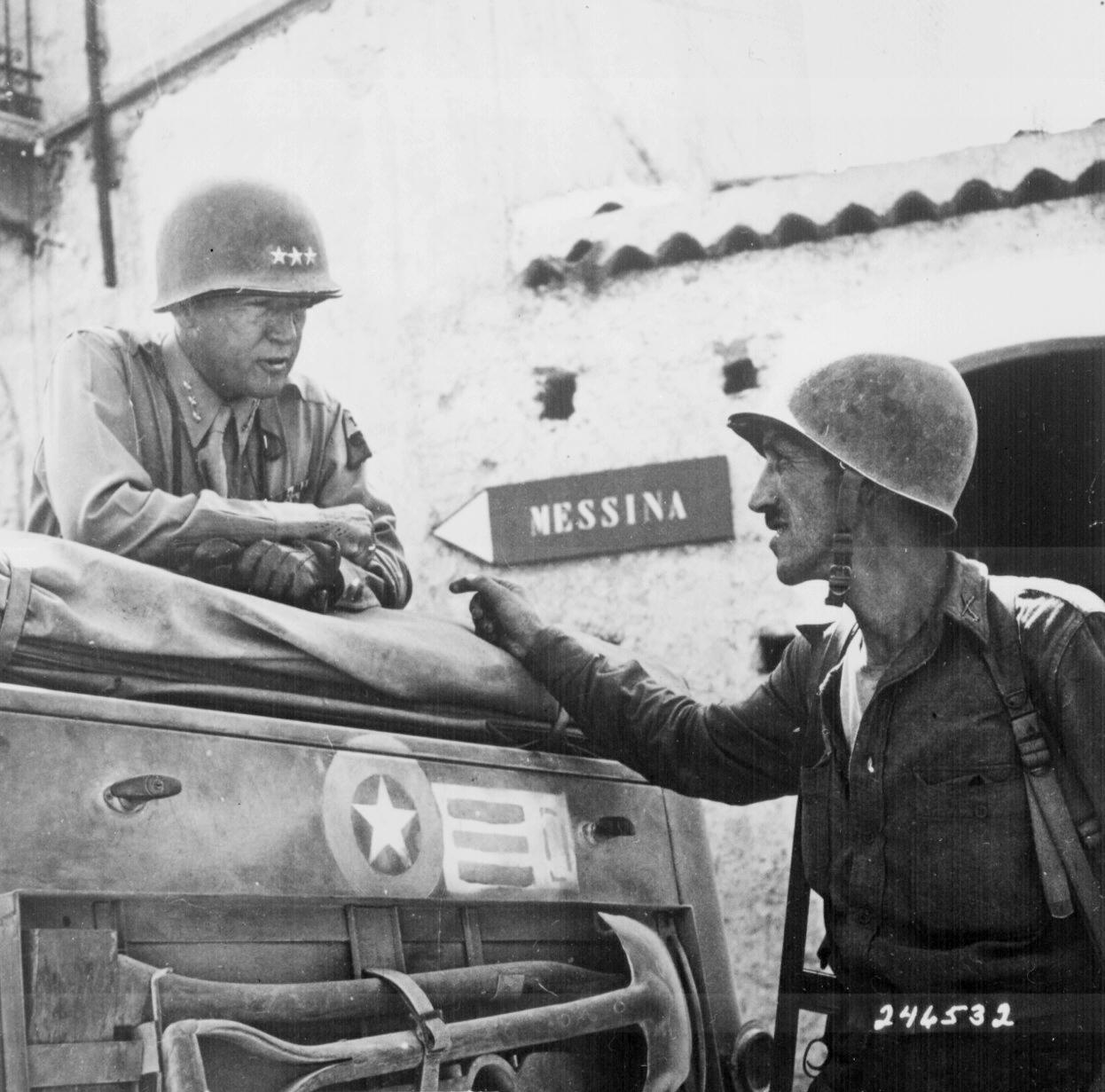
"Lt. Col. Lyle Bernard, CO, 30th Infantry
Regiment, a prominent figure in the second daring amphibious landing
behind enemy lines on Sicily's north coast, discusses military strategy with Lt.
Gen. George S. Patton. Near Brolo." 1943.
National Archives
111-SC-246532
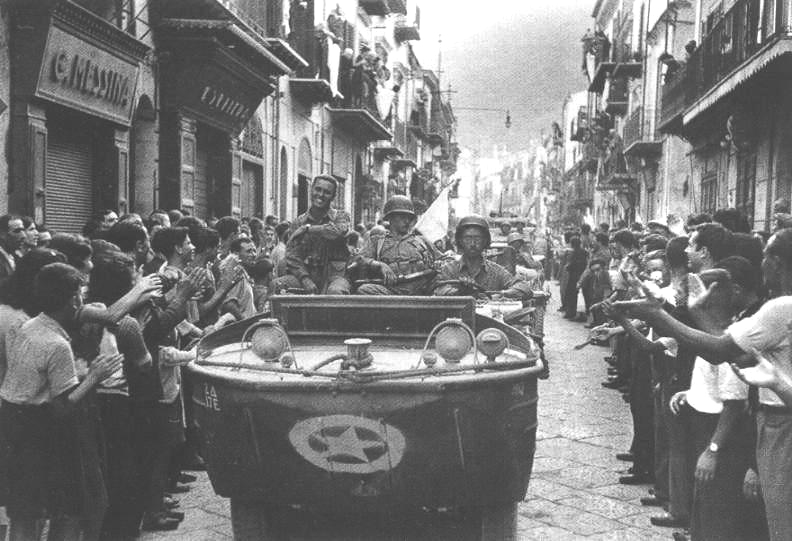
GIs entering Palermo,
Sicily
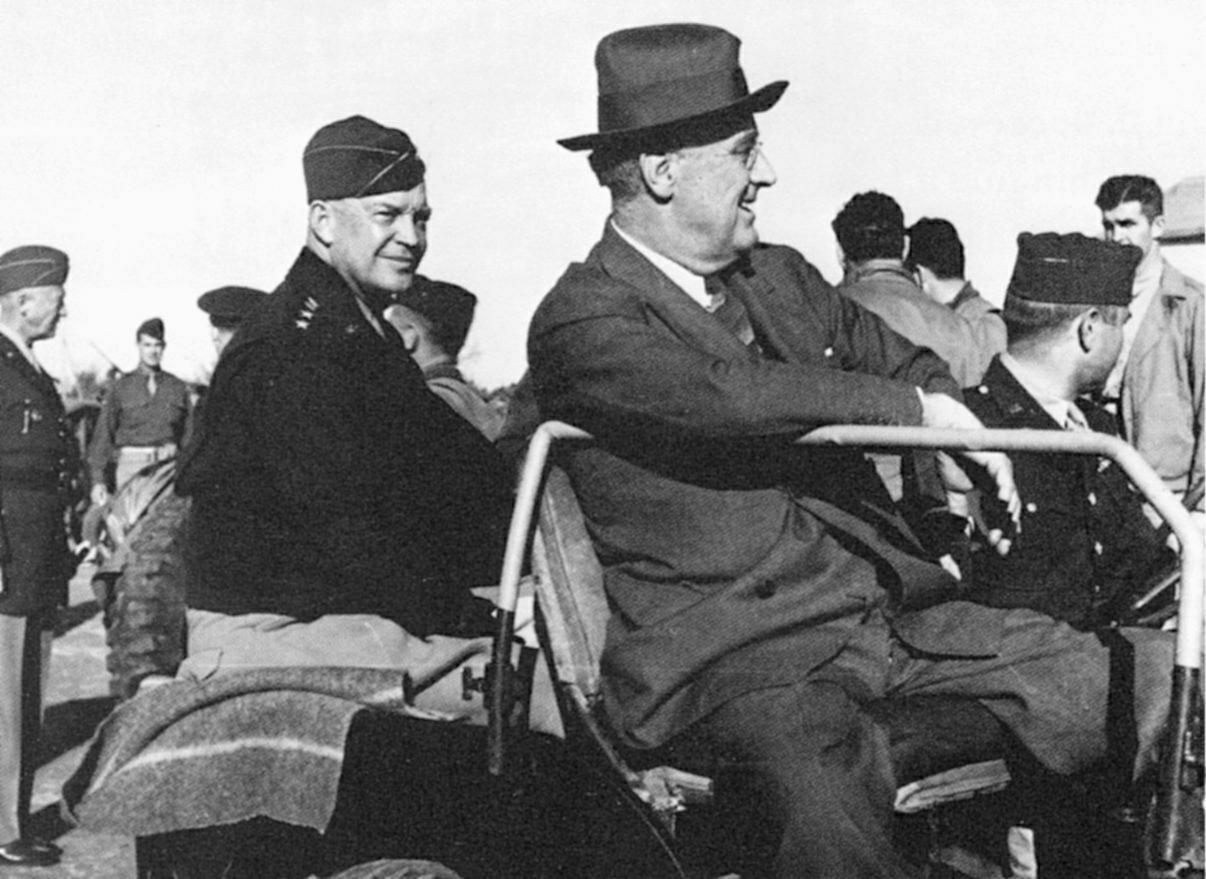
Roosevelt meets
with Eisenhower
in Sicily – 1943
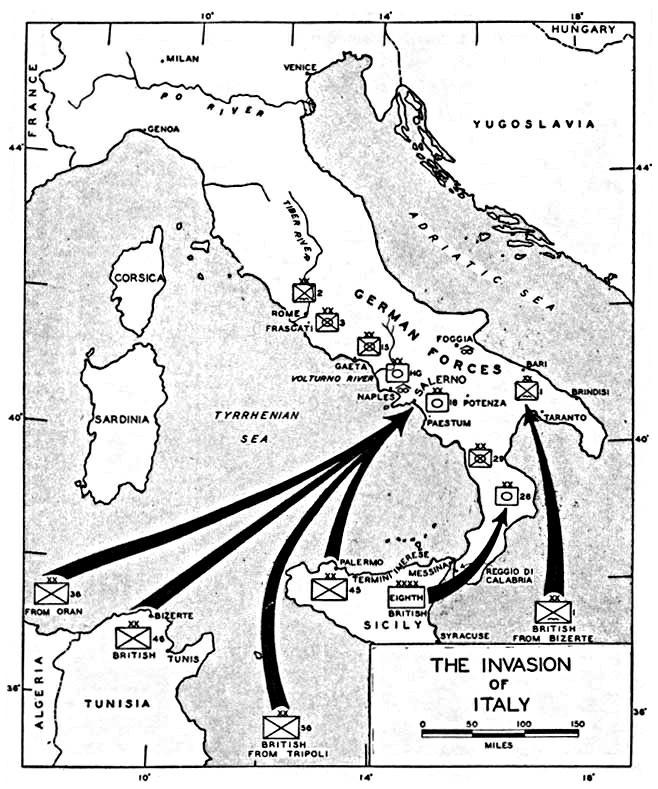
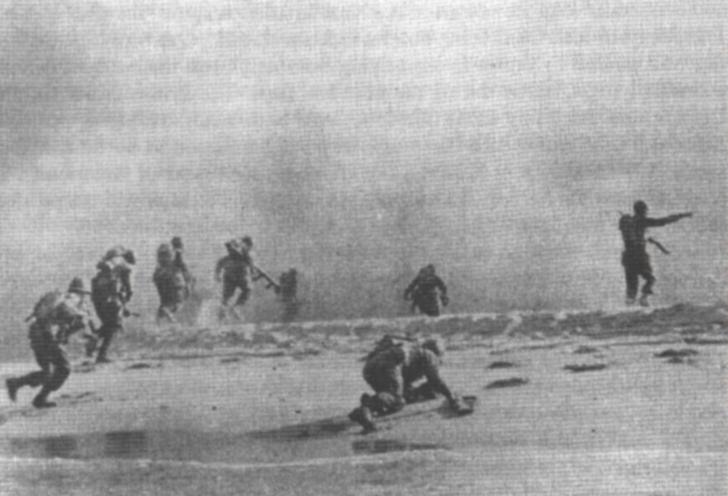
Behind a screen of
smoke,
Thunderbirds hitting the Salerno beachhead, September 1943
Courtesy of the 45th Infantry
Division Archives
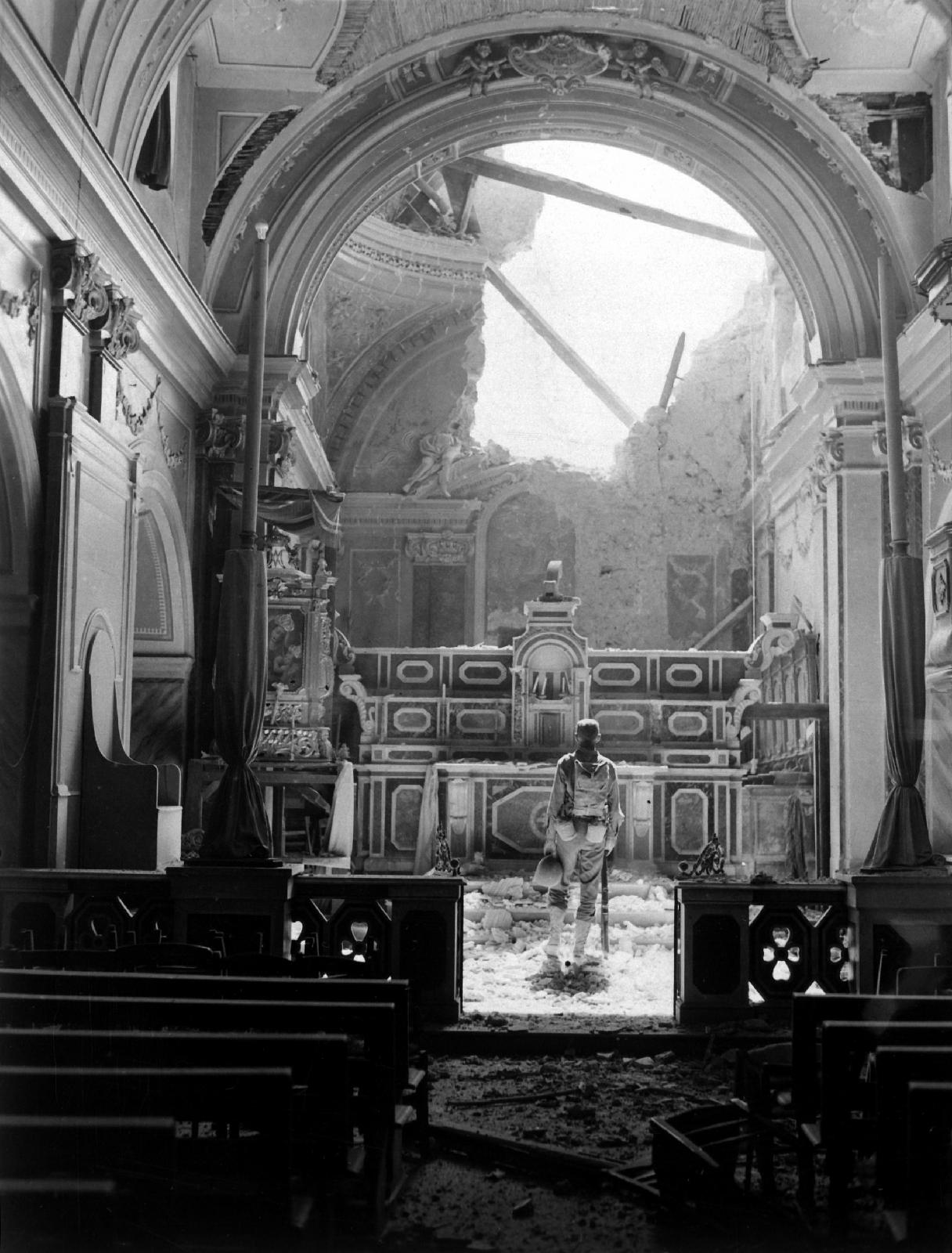
"Pvt. Paul Oglesby, 30th Infantry, standing
in reverence before an altar in a damaged Catholic Church.
Note: pews at left appear undamaged,
while bomb-shattered roof is strewn about the sanctuary.
Acerno, Italy." Benson, September 23,
1943.
National Archives
111-SC-188691
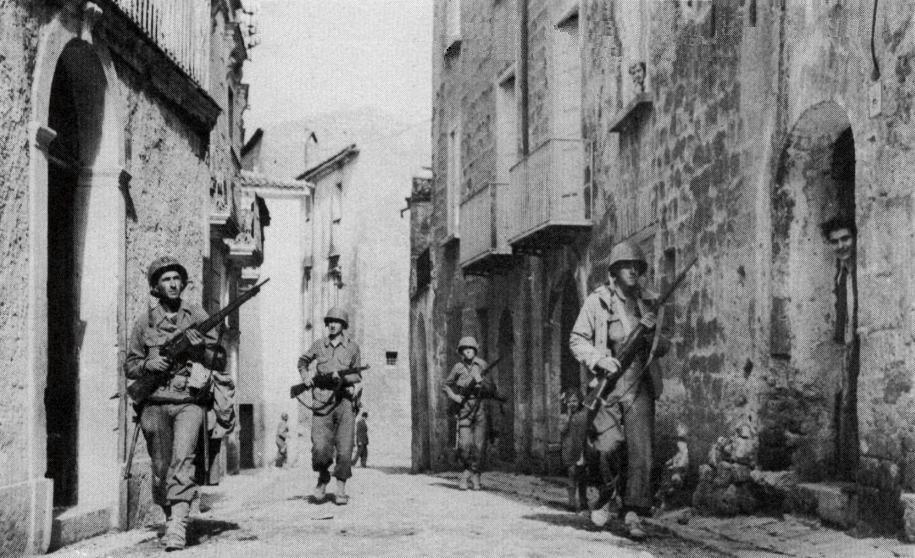
179th Infantry
looking for
snipers in Caiazzo, Italy
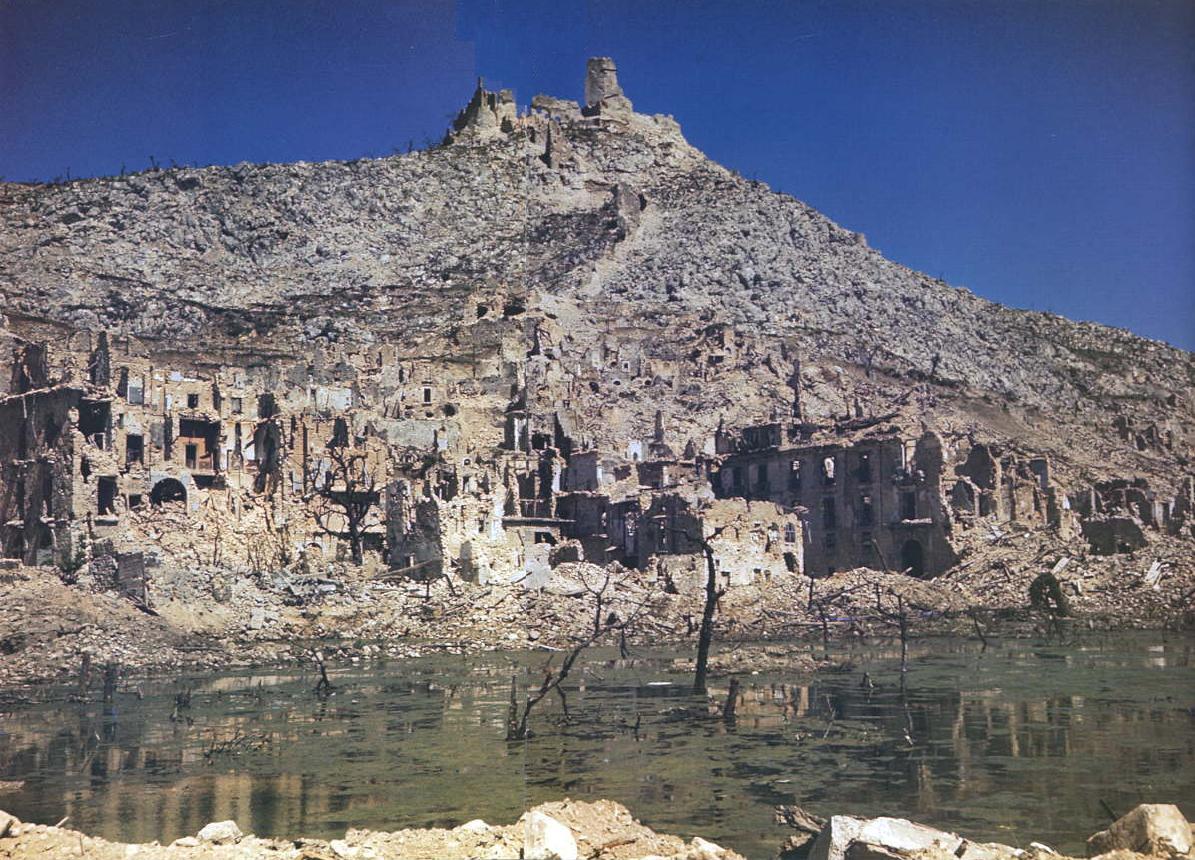
The ancient abbey
and town
of Monte Cassino – destroyed by Allied shelling
|
Thus
the following January (1944) the Americans decided to undertake a
massive landing of their troops behind German lines further north along
the Italian coast at Anzio. It was a superb idea, but disastrously
conducted by General Lucas – who halted his advance from the shore in
order to await additional supplies and reinforcements. But with that
incredibly incompetent decision, all element of surprise was gone and
the Germans meanwhile were able to position themselves overlooking the
American encampment – pouring murderous fire onto these stranded
American troops. It was not until four horrible months later in May
that the Americans were able finally to overcome the German defenses at
Anzio.
|
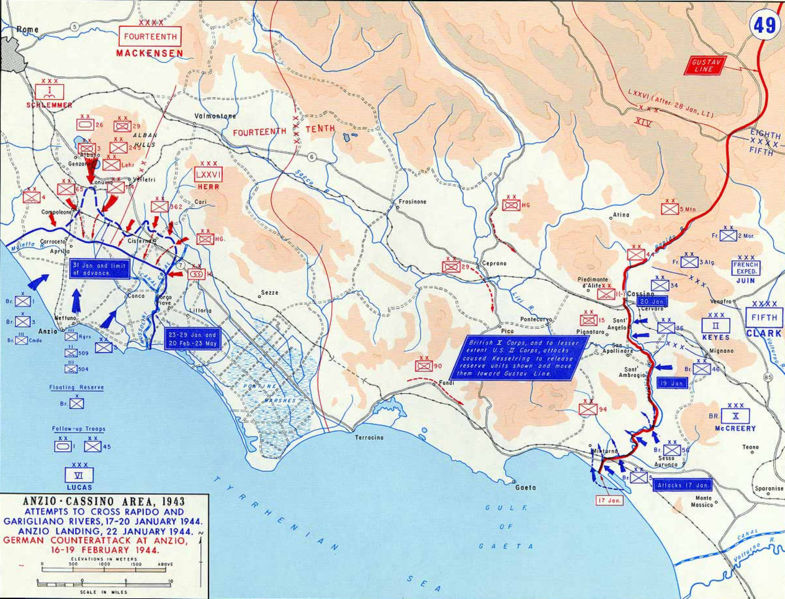
The two lines of Allied advance in Central
Italy – February 1944
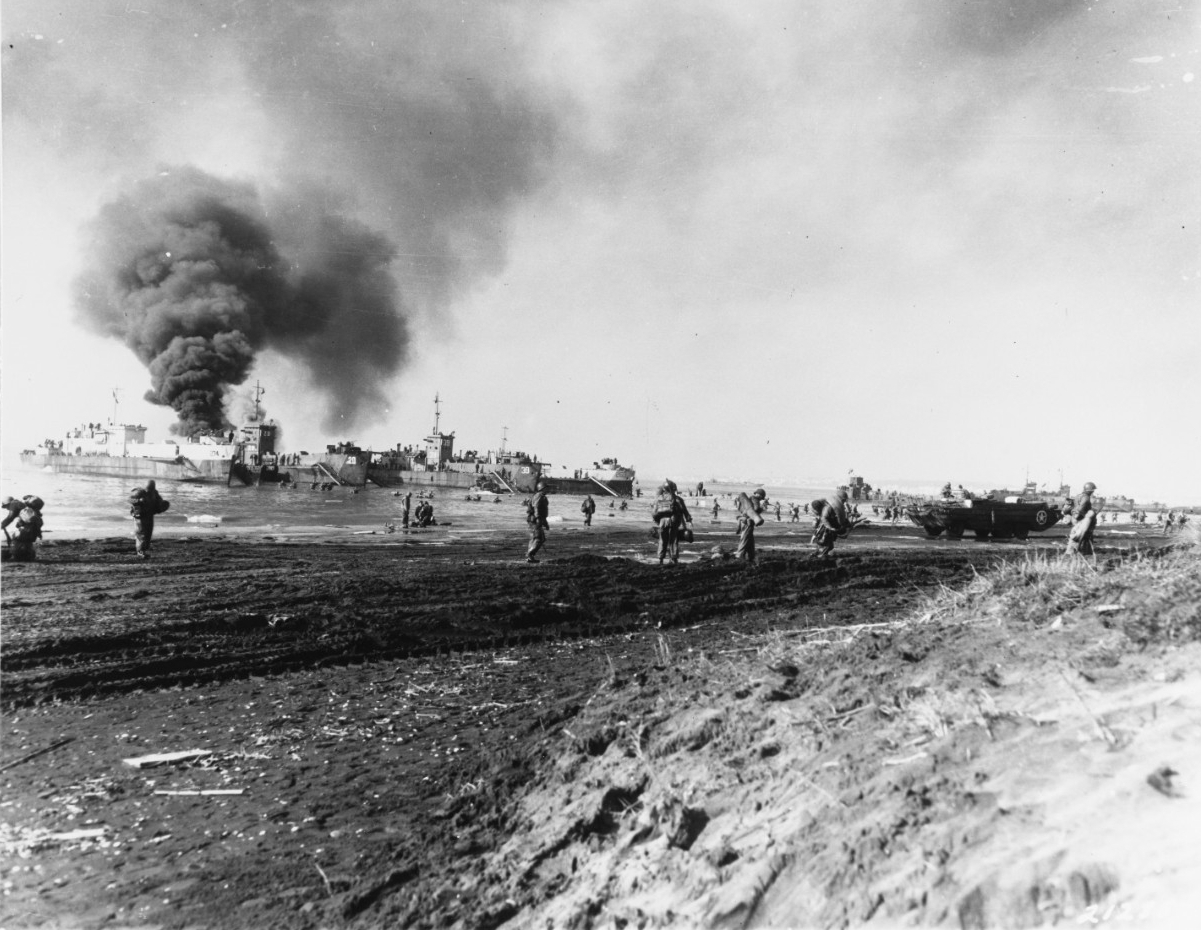
American troops coming ashore at Anzio – January
1944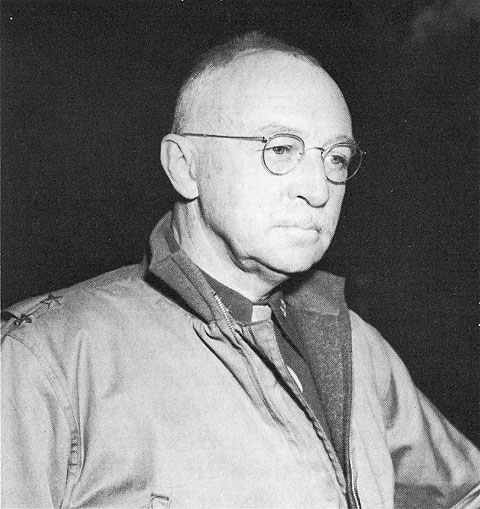 American General John P. Lucas -
American General John P. Lucas -
the overly-cautious commander of Operation Shingle at Anzio
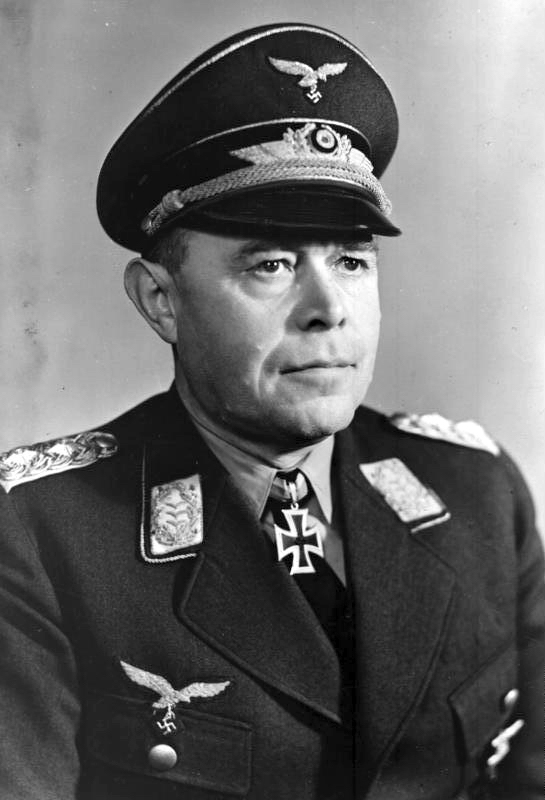 German General Albert Kesselring – who quickly threw up very
strong German defenses at Anzio
German General Albert Kesselring – who quickly threw up very
strong German defenses at Anzio
|
The liberation of Rome (June 1944)
And
then General Mark Clark gave the order to head north to Rome
(liberating the city fairly quickly in early June) … rather than
heading east across the peninsula to cut off a potentially trapped
German army. The Germans thus managed to pull to the north out of this
danger, to continue the fight – in fact all the way up to the end of
the war, when the Germans were still holding huge portions of northern
Italy.
|
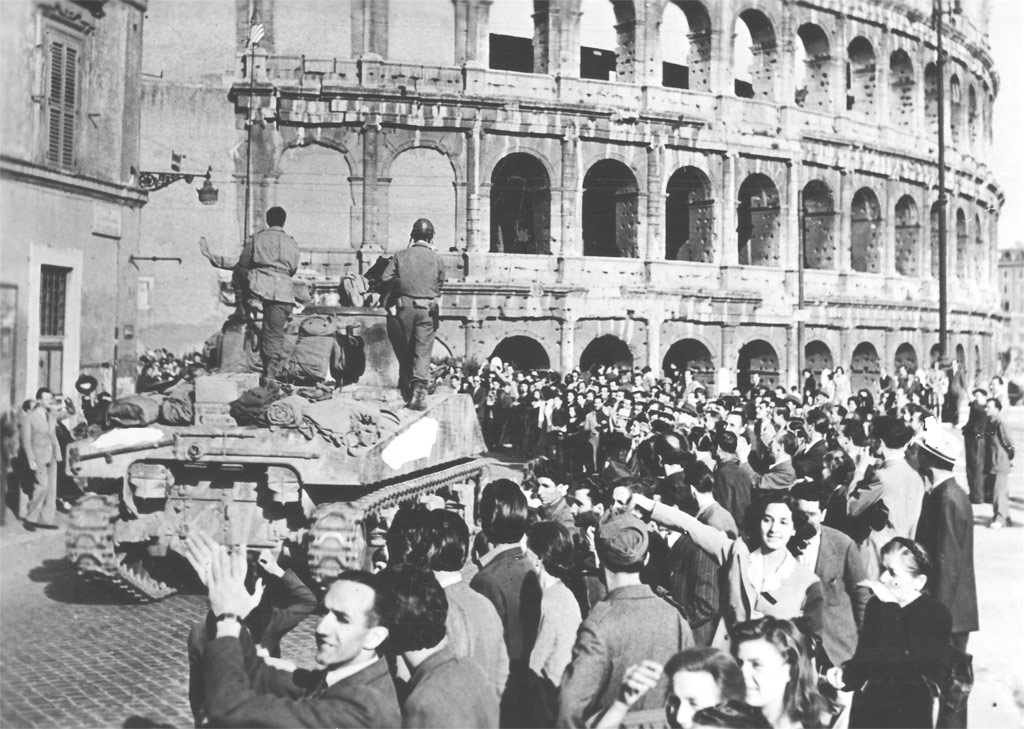
American tank rolls past the Roman
Colosseum – June 1944
General George C. Marshall
Although President Roosevelt was, by the very
designation of the American Constitution, commander in chief of all
branches of the U.S. military, the person whom the president depended
on most to help walk him through virtually all vital military and
diplomatic decisions was the quiet, self-effacing American General
George C. Marshall. In a time of prima donna generals in love with
their egos (for instance, American Generals Patton and MacArthur,
English General Montgomery and French General de Gaulle) Marshall
quietly worked in Washington behind the scenes, coordinating the war
effort between the White House and Congress, somehow also keeping the
egotistical generals working together to advance the Allied war effort.
He was a man of few words, but whose every word was trusted by all, for
he was widely recognized as a man of great integrity.
Perhaps most illustrative of his
character was the moment when it was time to designate a general to
lead the massive Allied crossing of the English Channel on D-Day, to
begin the liberation of Western Europe, a command that would put the
name of the general who led the effort on record forever as one of the
greatest generals of all time (and probably a strong candidate for the
U.S. presidency some day). Everyone knew that this distinct honor
belonged to the highly capable, hard-working General Marshall.
Roosevelt knew this too, but felt that he would be lost in the swirl of
Washington and Allied politics with Marshall in Europe and not at his
side. It was up to Roosevelt to pick the general who would receive this
great honor. But instead he called on Marshall to pick the one who
would lead the D-Day operation. Roosevelt confessed that the honor
belonged to Marshall, but begged him to stay in Washington where the
president, and the country, still needed him badly. So, Marshall took a
piece of paper, and on it wrote the name of his close friend,
Eisenhower, and passed it to the president indicating that Eisenhower
would be the one to lead the assault.
Eisenhower was surprised to receive the
honor, but performed well, and stepped into history as the war's most
memorable general, and on the basis of that fame eventually did become
president of the United States. Marshall gave up that honor, in order
to continue to serve the country rather than his own personal career. There was a truly great man!
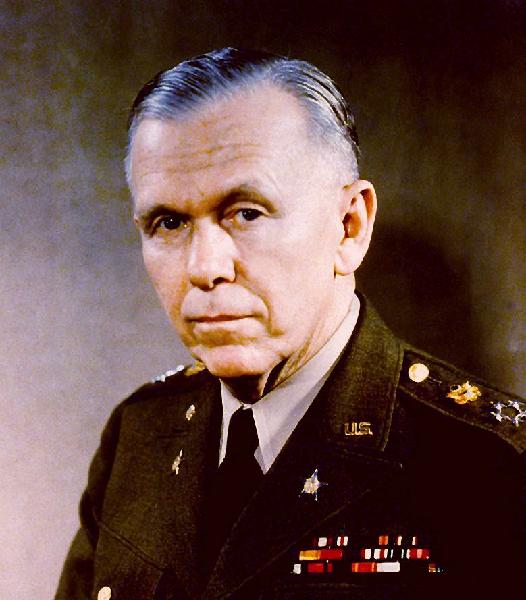 The mastermind behind the
building up of the US military:
The mastermind behind the
building up of the US military:
Gen. George C. Marshall, Army Chief
of Staff General George C. Marshall -
Time magazine's 'Man of the Year' -
1943
General George C. Marshall -
Time magazine's 'Man of the Year' -
1943
The Normandy landing begins the Battle of France (June 1944)
The Allies hoped to weaken the German line of
defense along the Atlantic Wall by convincing the Germans that the
crossing would occur way to the North of the area actually selected for
the landing. They thus created in the area just above the narrowest
point in the English Channel (just across from French Calais) a huge
phony army of dummy tanks and trucks and false radio communications –
ones that they were hoping German intelligence was analyzing. The fact
that Patton was appointed head of this phony army was thought
(correctly) to be the most convincing part of the ploy (Hitler and the
Germans were convinced that Patton was the Allies' best general). And
indeed, Hitler was certain that the channel crossing of the Allies
would be happening at Calais. But in fact the Allied intentions were to
head their troops not east from England – but instead to a section of
the Normandy shoreline directly south of England … at a substantial
distance from Calais. The point of invasion was a highly-kept secret
all the way up until the time it was actually launched.
Training for the channel crossing
(Operation Overlord) took place over many months. But as the summer of
1944 approached, General Eisenhower knew it was time to move if they
were to cross France and reach Germany before winter set in. But bad
weather delayed the first date chosen for the crossing. Then a very
brief break in very bad weather finally gave Eisenhower the conditions
he needed before the tides began to change and the crossing would have
to be delayed by weeks. Because of that bad weather however the Germans
were not expecting any action from the Allies. In fact, Rommel took
those days off to head back to Germany for a visit to his wife.
Thus in the early hours of June the
6th, 160,000 American, British, Canadian and French troops went ashore
along a fifty-mile strip of the coast of southern Normandy. The
Normandy landing area was divided into five sectors: Utah (American),
Omaha (American), Gold (British), Juno (Canadian) and Sword (British
and some French). Omaha Beach and the Pointe de Hoc landing of Rangers
(next to Omaha Beach) were the sectors with the highest Allied
casualties because this area was defended by strong German emplacements
atop very tall cliffs. Juno was almost as bad, due to the German
network of bunkers along the seawall. Utah Beach produced the lightest
Allied casualties. The Airborne divisions dropped behind German lines
also suffered very high casualty rates.
 Eisenhower
addressing troops
prior to the Normandy invasion
Eisenhower
addressing troops
prior to the Normandy invasion
U.S. Army
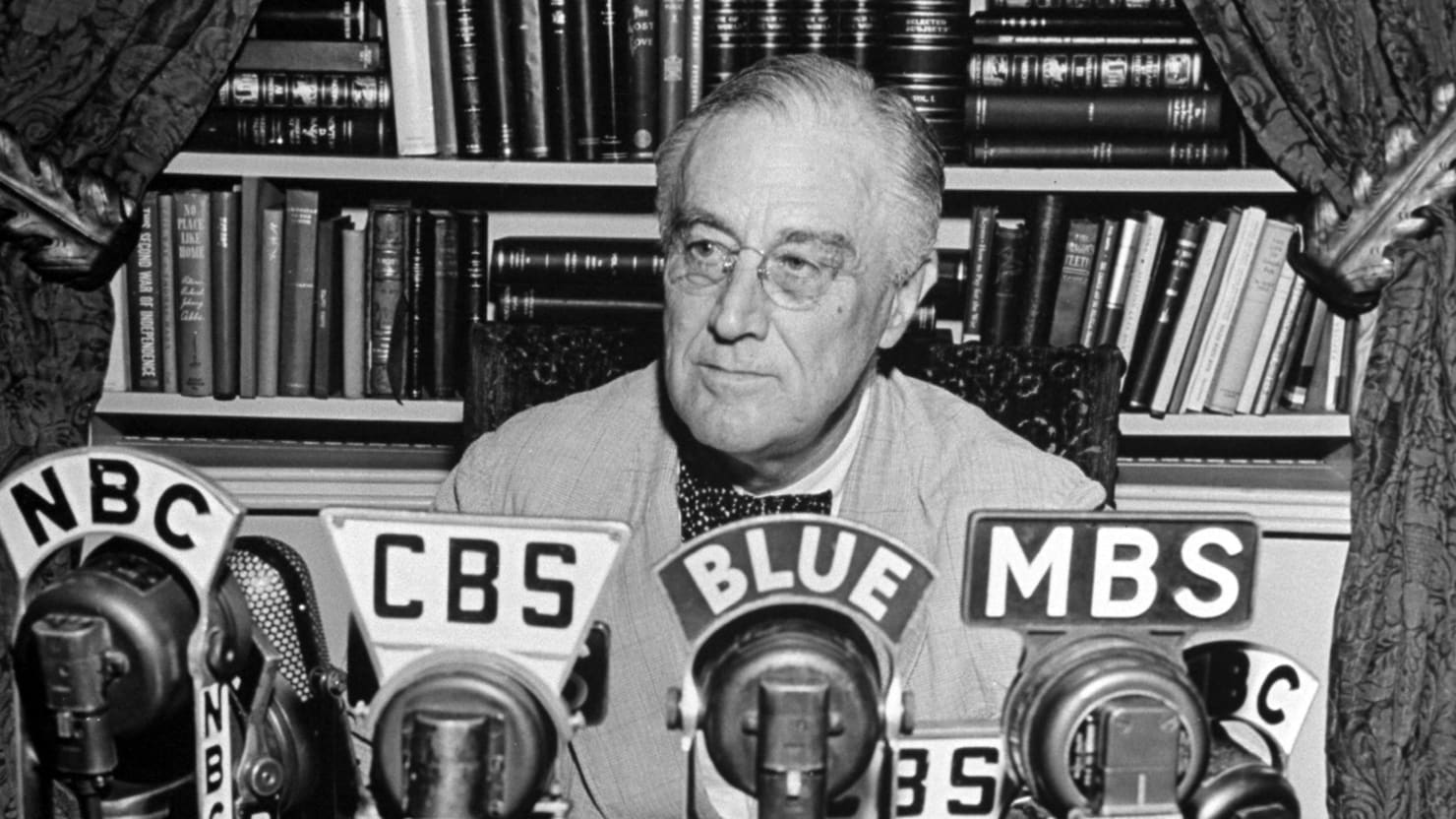
FDR offering a D-Day prayer the day of the Normandy landing (June 6th 1944)
|
That night Roosevelt went on the radio to call the American nation to prayer:
My fellow Americans: Last
night, when I spoke with you about the fall of Rome, I knew at that
moment that troops of the United States and our allies were crossing
the Channel in another and greater operation. It has come to pass with
success thus far.
And so, in this poignant hour, I ask you to join with me in prayer:
Almighty God:
Our sons, pride of our Nation, this day have set upon a mighty
endeavor, a struggle to preserve our Republic, our religion, and our
civilization, and to set free a suffering humanity.
Lead them straight and true; give strength to their arms, stoutness to their hearts, steadfastness in their faith.
. . .
Some will never return. Embrace these, Father, and receive them, Thy heroic servants, into Thy kingdom.
And for us at
home fathers, mothers, children, wives, sisters, and brothers of brave
men overseas whose thoughts and prayers are ever with them help us,
Almighty God, to rededicate ourselves in renewed faith in Thee in this
hour of great sacrifice.
. . .
With Thy blessing, we shall prevail over the unholy forces of our enemy. Help us
to conquer the apostles of greed and racial arrogancies. Lead us to the
saving of our country, and with our sister Nations into a world unity
that will spell a sure peace a peace invulnerable to the schemings of
unworthy men. And a peace that will let all of men live in freedom,
reaping the just rewards of their honest toil.
Thy will be done, Almighty God. Amen
|
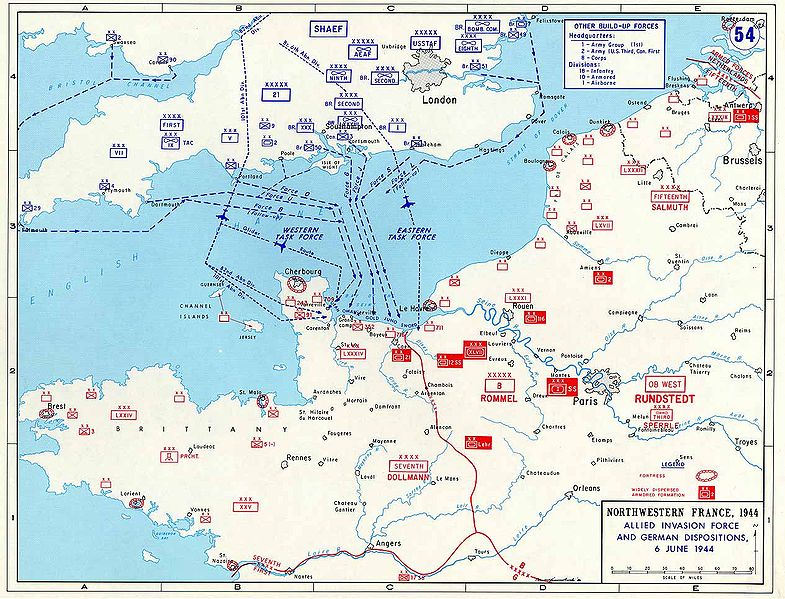
Allied invasion
plans and
German positions in Normandy on D-Day (June 6, 1944)
U.S. Department of
Defense
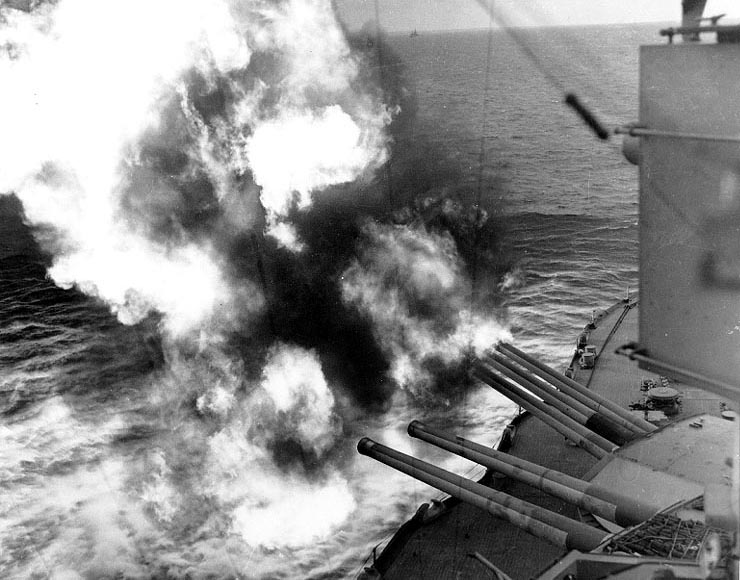 Forward 14"/45 guns
of USS
Nevada (BB-36) fire on positions ashore, during the landings on "Utah"
Beach, 6 June
1944.
Forward 14"/45 guns
of USS
Nevada (BB-36) fire on positions ashore, during the landings on "Utah"
Beach, 6 June
1944.
National
Archives
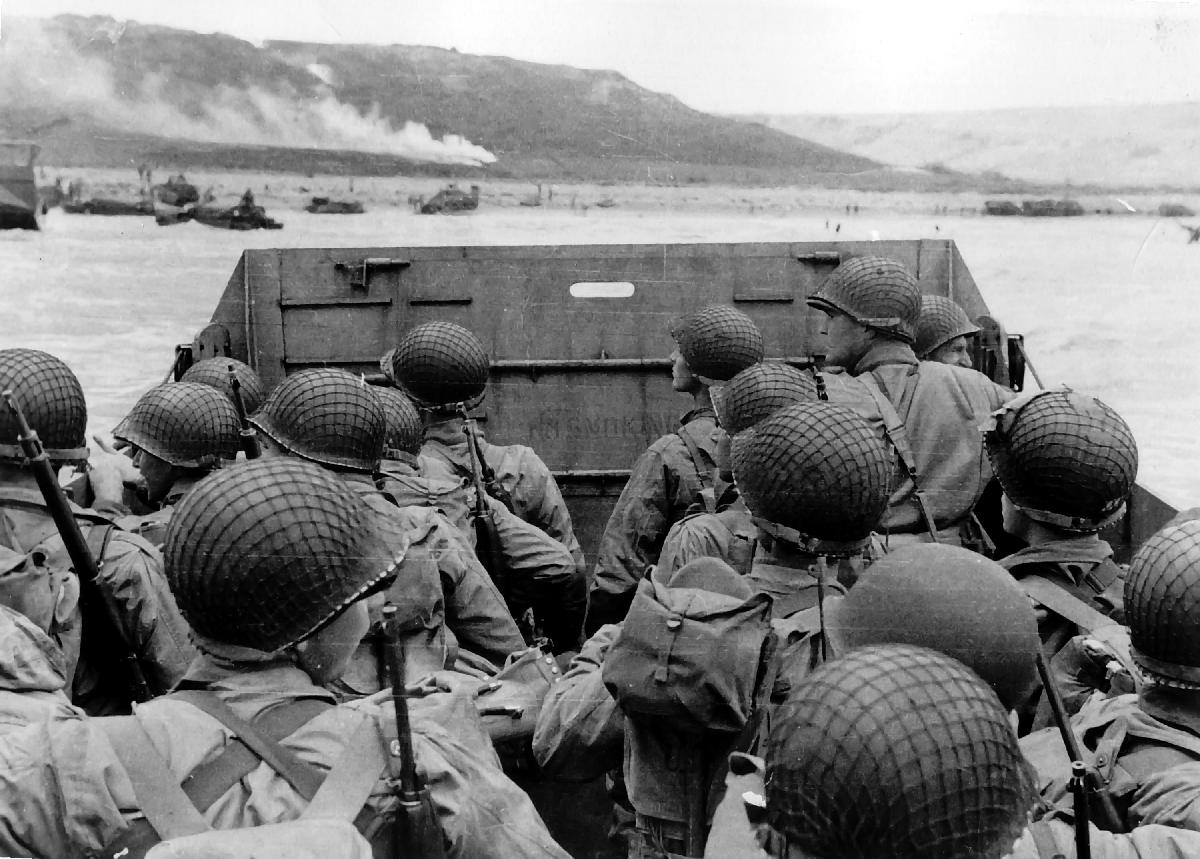
Approaching Omaha Beach. Troops in an LCVP ('Higgins boat')
landing craft approaching "Omaha" Beach on "D-Day", 6 June 1944.
Note helmet netting, faint "No Smoking"
sign on the LCVP's ramp, and M1903 rifles and M1 carbines carried by some
of these men.
US Army Signal Corp – National
Archives
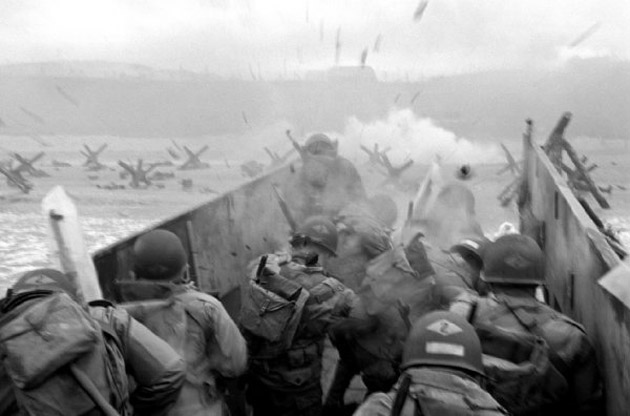 Soldiers taking direct hits from a German
machine gunner as the ramp drops down for unloading.
Soldiers taking direct hits from a German
machine gunner as the ramp drops down for unloading.
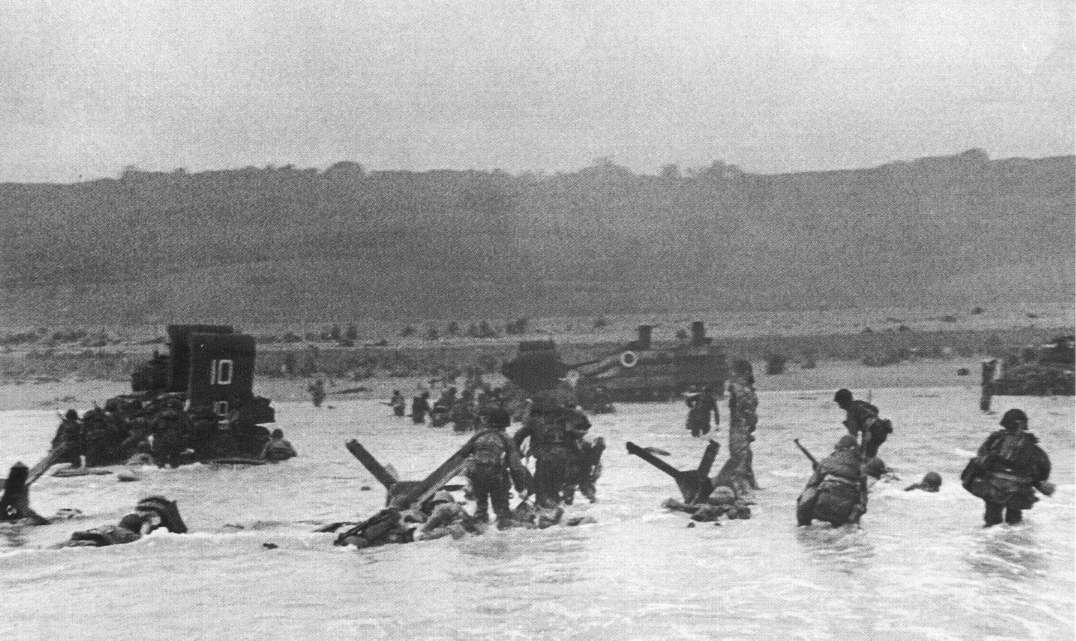
Normandy landing -
D-Day (June 6, 1944)

Members of an
American landing
party lend helping hands to other members of their organization. Their landing craft was
sunk by enemy action off the coast of France. These survivors reached Omaha Beach by using a life raft. Photographer: Weintraub, 6 June
1944
Department of
Defense
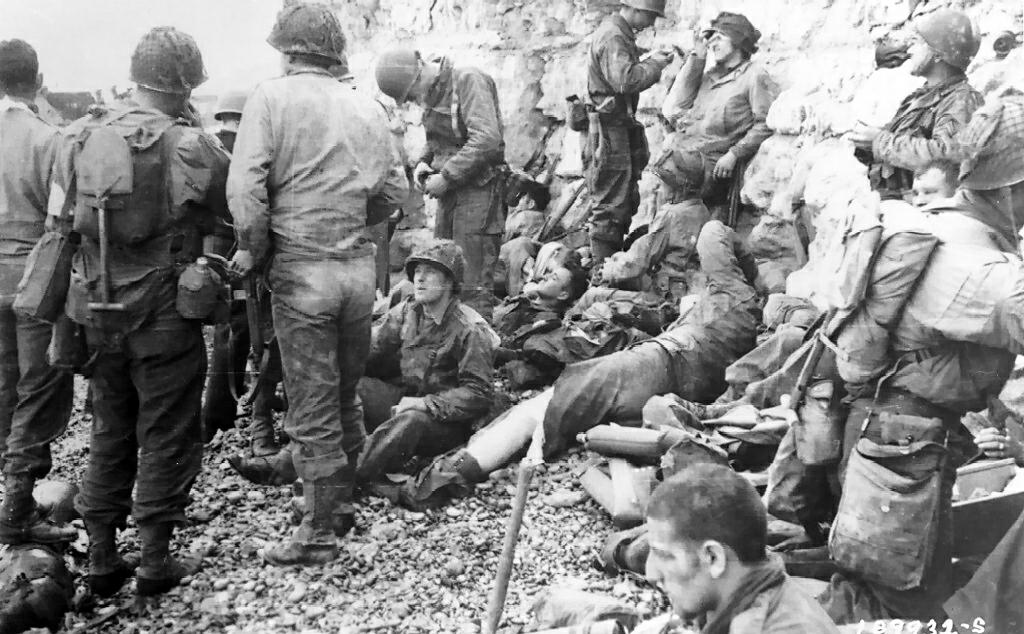
American assault troops of
the 3d Battalion, 16th Infantry Regiment, 1st U.S. Infantry Division which landed in the first two waves,
sheltering at the foot of the chalk cliffs. The cliffs indicate
this was
in the area of Fox Red sector. Having gained the comparative safety
offered by the chalk cliff at their backs, they take a "breather" before
moving onto the continent at
Colville-Sur-Mer, Omaha
Beach, in Normandy, France. Medics who landed with the men
treat
them for minor injuries. 8 Jun 1944.
U.S. Army
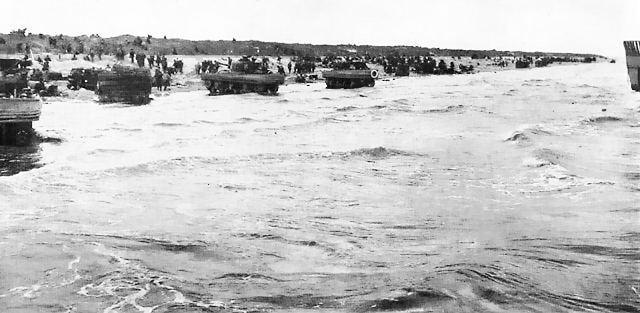 Going ashore on Utah Beach,
D-Day – 1944. Assault elements of Force U, including
DD tanks, were still on the beaches when this photo was taken shortly after
H Hour. The amphibious tanks await the blowing of breaches in the sea wall.
Going ashore on Utah Beach,
D-Day – 1944. Assault elements of Force U, including
DD tanks, were still on the beaches when this photo was taken shortly after
H Hour. The amphibious tanks await the blowing of breaches in the sea wall.
U.S. Army
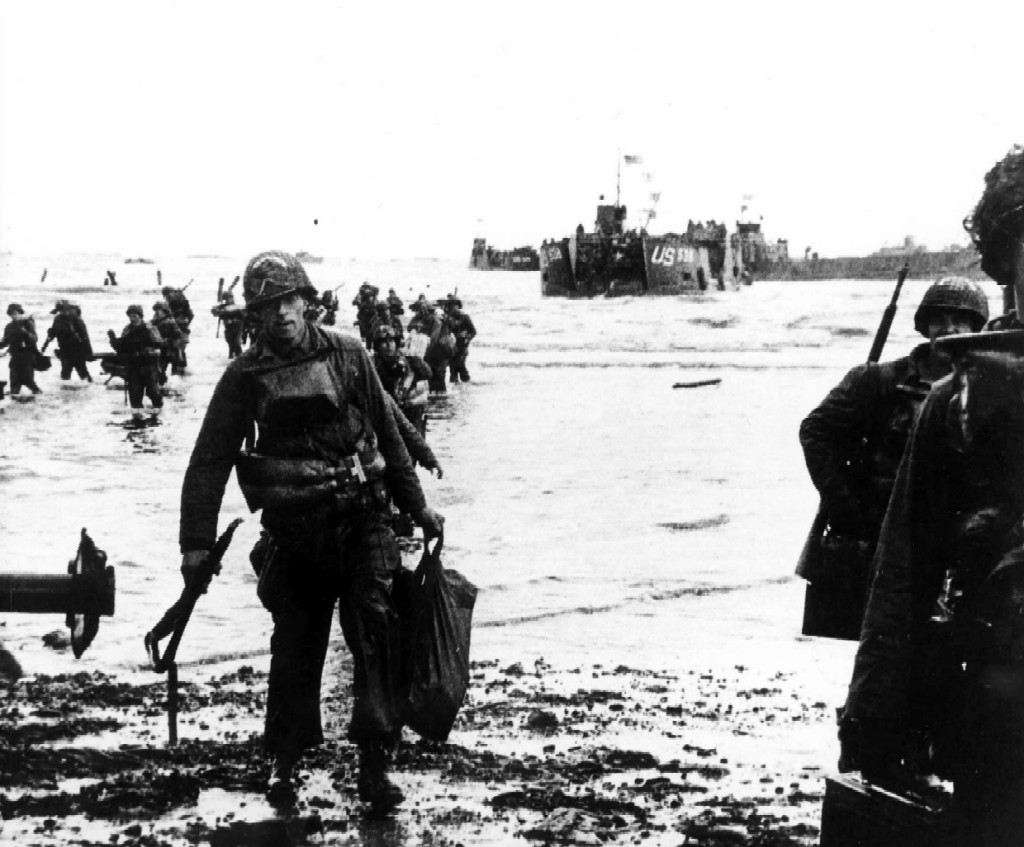
Going ashore on Utah Beach,
D-Day – 1944. Carrying a full equipment, American
assault troops move onto Utah Beach on the northern coast of France. Landing
craft, in the background, jams the harbor. 6 June 1944.
U.S. Army
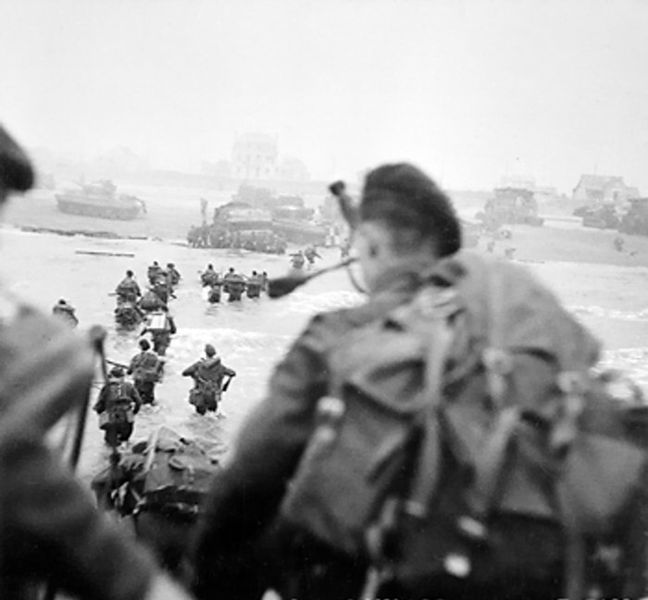
British troops going ashore
at Sword Beach, D-Day – 1944
The British 2nd Army: Commandos
of 1st Special Service Brigade landing from an LCI(S) (Landing Craft Infantry
Small) on "Queen Red" Beach, SWORD Area, at la Breche, at approximately
8.40 am, 6 June. The brigade commander, Brigadier the Lord Lovat DSO MC, can be seen striding through the water to the right of the column of men.
The figure nearest the camera is the brigade's bagpiper, Piper Bill Millin.
Imperial War Museum,
London
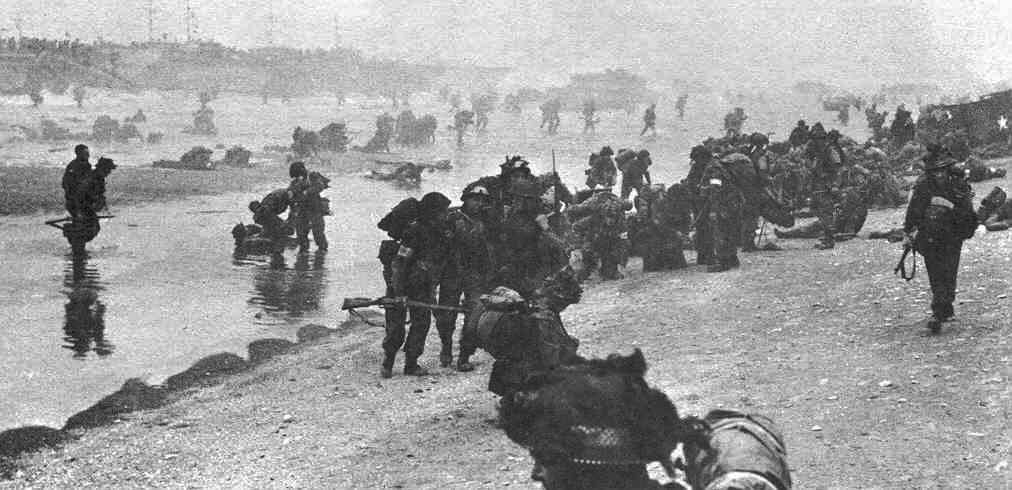
British troops advancing
toward Caen, D-Day – 1944
Imperial War Museum,
London
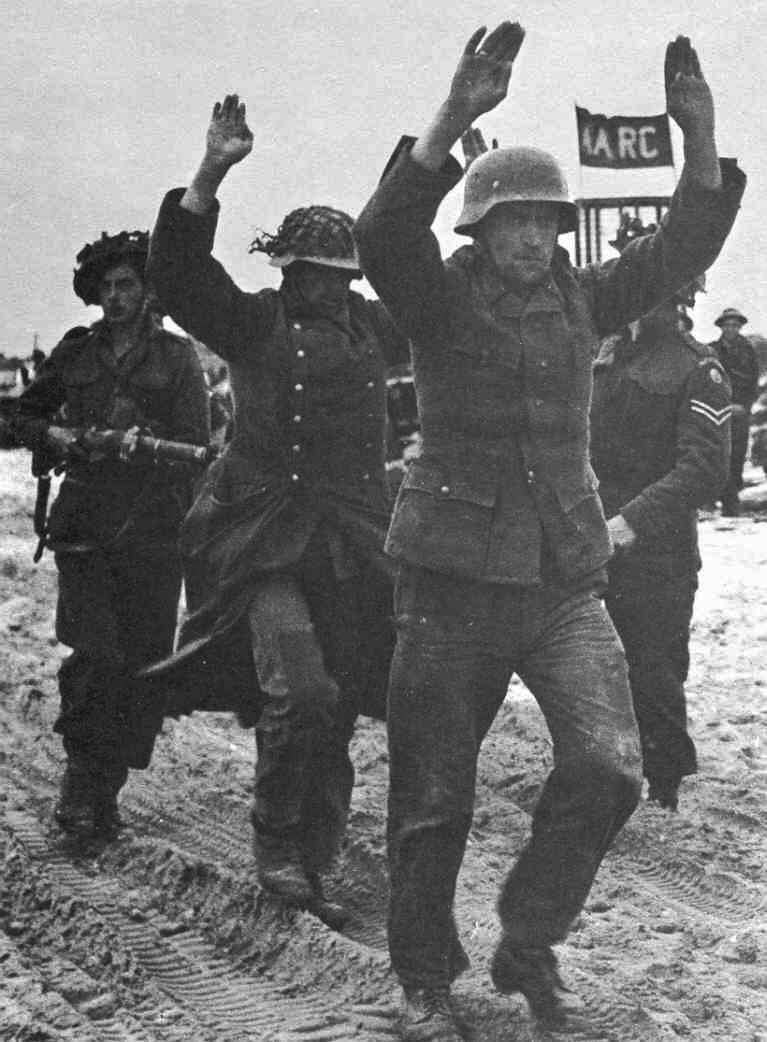
British soldier and
captured
Germans, D-Day – 1944
Imperial War Museum,
London
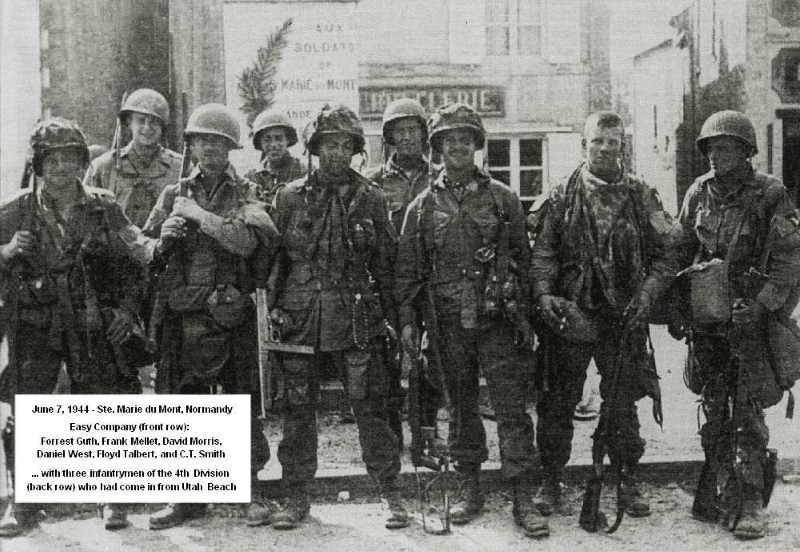
Paratroopers of Easy
Company,
506th Regiment of the 101st Airborne Division after having seized Ste.
Marie du Mont from the Germans (June 7,
1944)
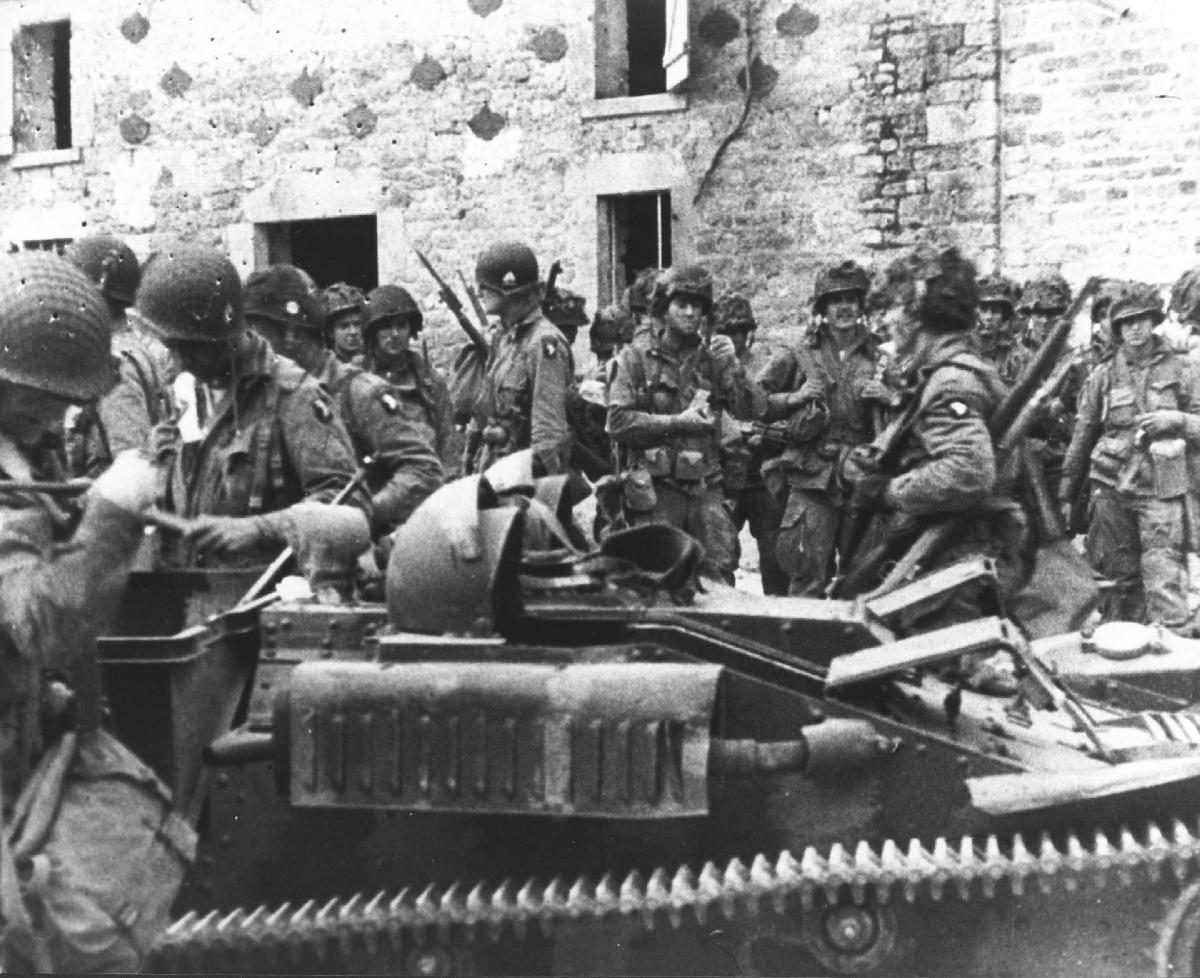
A group of
paratroopers in
a French village at St. Marcouf, Utah Beach, France. From here they will move
on into the continent, accomplishing their assigned objectives. 8 June
1944.
U.S. Department of
Defense
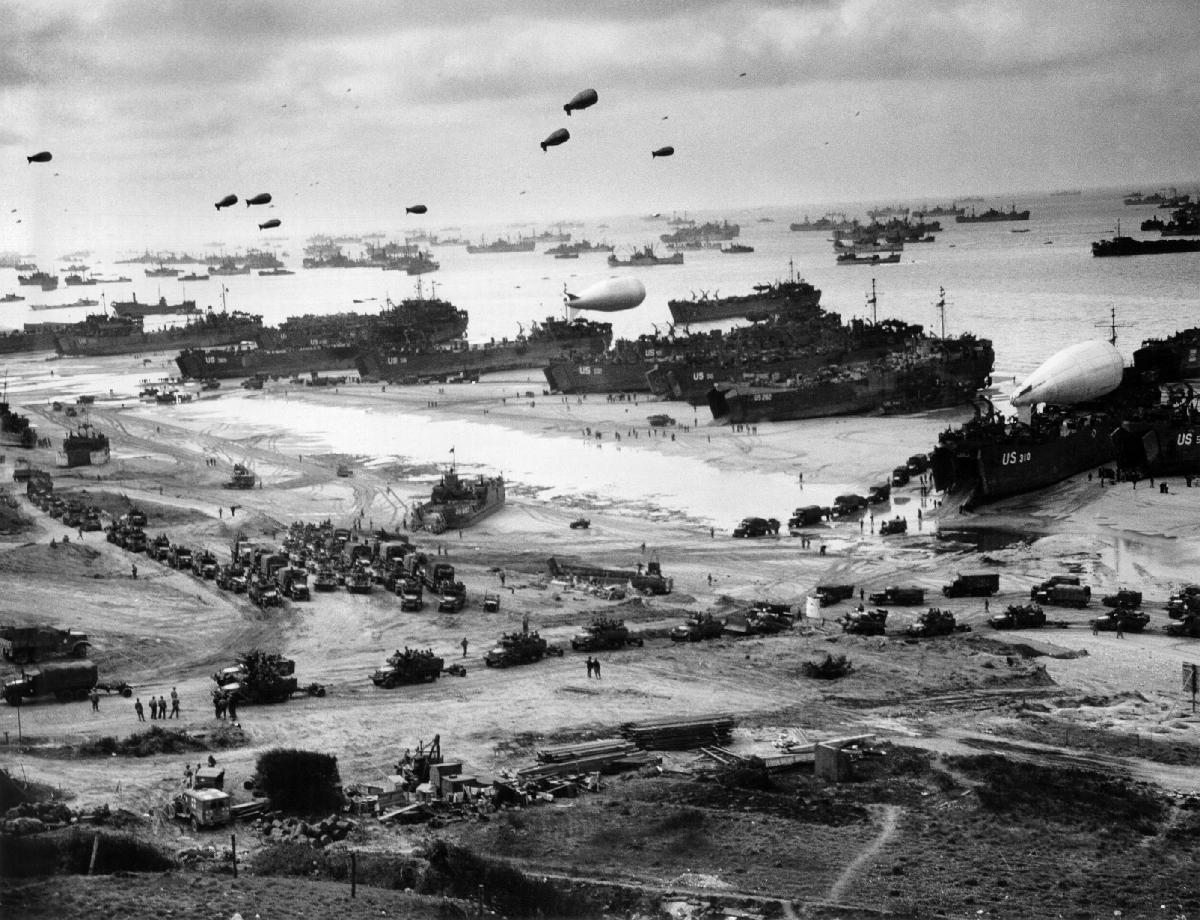
Landing ships putting
cargo ashore on Omaha Beach, at low tide during the first days of the operation,
mid-June, 1944. Among identifiable ships present are LST-532 (in the center
of the view); USS LST-262 (3rd LST from right); USS LST-310 (2nd LST from
right); USS LST-533 (partially visible at far right); and USS LST-524.
Note barrage balloons overhead and Army "half-track" convoy forming up
on the beach. The LST-262 was one of 10 Coast Guard-manned LSTs that participated
in the invasion of Normandy, France.
United States Coast Guard
Collection
|
The advance again Hitler's forces in France
The landing ultimately proved to be a success.
Hitler at first refused to reposition his troops gathered further north
at Calais, considering the Allied landing to be merely a feint designed
to draw troops away from Calais so as to make Patton's invasion easier
(there was, of course, no such Patton invasion). For days Hitler
hesitated before he finally came to the realization that this was the
massive assault that the Germans had long been expecting. But by that
time the Allies were well planted in Normandy and moving inland fairly
quickly.
Several problems however complicated the Allied advance. The British
were expected to liberate the city of Caen almost immediately. Their
landing had been largely unopposed, but in reaching the outskirts of
Caen the Germans showed themselves prepared to put up a major fight.
Consequently, this key hinge point took two months to bring under
Allied control. Also the farms of Normandy were outlined not by fences
but by huge, thick centuries-old hedges that gave the Germans great
defensive opportunities and made progress of the Allied tanks and
infantry almost impossible, until an immense steel fork was created to
be placed on the front of the tanks, allowing them simply to plow
through the hedges. With that innovation, the advance against the
Germans proceeded much more quickly.
At one point a huge German army was
nearly surrounded by the advancing Allies. But failure to close quickly
a gap in the circle allowed most of the Germans to escape and
reorganize further east against the Allied advance. Nonetheless, the
Germans were tiring and running out of men and supplies. At this point
(August) the Allied move across France towards Germany was advancing
quickly.
In the meantime, a number of Allied
troops in Italy under the command of General Truscott were redirected
in mid-August to undertake an invasion of France along the southern,
Mediterranean coast. Here they were joined by large numbers of members
of the French Resistance, and opposed by greatly weakened German
forces. Within the span of a month, Allies had liberated the entire
region, opening key Mediterranean ports for supply of the Allied effort
in the north against the main German defense. This was a vital victory,
which however, in the context of the huge attention focused on
activities going on further north in France, was barely acknowledged at
the time (or sadly, even since then as well).
The decision to liberate Paris
rather than head directly to a Rhine crossing
At first the objective of the Allies as
they headed east across France was to get to the Rhine as quickly as
possible, cross it and then head across a weakened Germany towards
Berlin, possibly ending the war by Christmas. But key political factors
had to be taken into account, especially given the political confusion
the French found themselves in. Eisenhower did not trust the French
Communists, who after having sat out the war during its early and vital
days (under instructions of Hitler’s ally at the time, Stalin) and then
had joined the French Resistance only when Hitler attacked Russia. Then
the Communists attempted to pose themselves as the true heroes of the
Resistance, with the goal in mind of taking control of a post-war
France. The original members of the Resistance were very nervous about
the Communist role in the Resistance and de Gaulle was adamantly
opposed to them. Thus it appeared that there would be a huge political
fight for France – fought naturally at the heartland of French life,
Paris. It was imperative that the Allied Armies, not some Communist
element of the French Resistance, should be awarded the task of
liberating this key symbol of French life and culture.
Then there was perhaps the matter of what
the Germans might do to Paris itself simply in retribution. When Hitler
sent Major General Dietrich von Choltitz to Paris to take charge of the
German defense of the city, concern about his ultimate intentions
naturally arose, for he was the ruthless Prussian commander who had
been greatly responsible for the thorough destruction of both Rotterdam
in Holland and Sebastopol in Russia. The Allies did not know that he
had instructions from Hitler to completely demolish Paris (leave not
one Paris church, bridge, monument or landmark standing) rather than
surrender the city intact – but they rather suspected something like
that was bound to happen, given Hitler's move to send von Choltitz
there.
And thus the Allied armies turned toward
Paris, fairly quickly taking control of the city (despite German
snipers still holding out here and there in the city) – and letting de
Gaulle lead the victory parade down the Champs Elys es boulevard as if
it had been his Free French army that had performed the liberation. In
any case … no, Choltitz did not blow up Paris as ordered – although
when he later put forth the claim that he had refused Hitler's orders
for humanitarian reasons, questions arose as to whether this was indeed
the case – or that the speed of Paris's delivery prevented him from
such a treacherous act. Perhaps it was some combination of both. The
world will never know.
In the end, the cost of the decision to
delay the Rhine crossing in order to liberate Paris was very, very
high. This gave Hitler time to reorganize his troops in the West, to
end British General Montgomery's hope to quickly cross the Rhine in the
North in Holland before the Germans could react (and thus open a very
direct and lightly-defended path to Berlin), even to give the Germans
the time to organize enough for one last push to throw the Allied
effort back to the Atlantic (a combination of V-2 bombs and the German
winter offensive known in the West as the "Battle of the Bulge"), and
worst of all, to give him that much more time to try to complete the
eradication of the entire European Jewish community with his "Final
Solution." Thus a lot of lives were lost elsewhere because of the
decision to redirect the Allied war effort toward Paris.
In short, a precious, precious price was
paid to spare a precious, precious Paris (and France from the grip of
Communism), a hard but momentous decision.
|
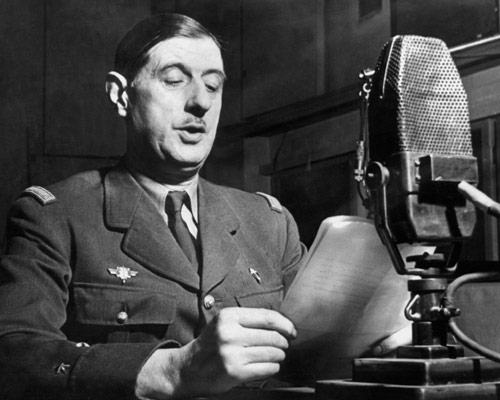 Charles de
Gaulle on BBC
radio during the war
Charles de
Gaulle on BBC
radio during the war
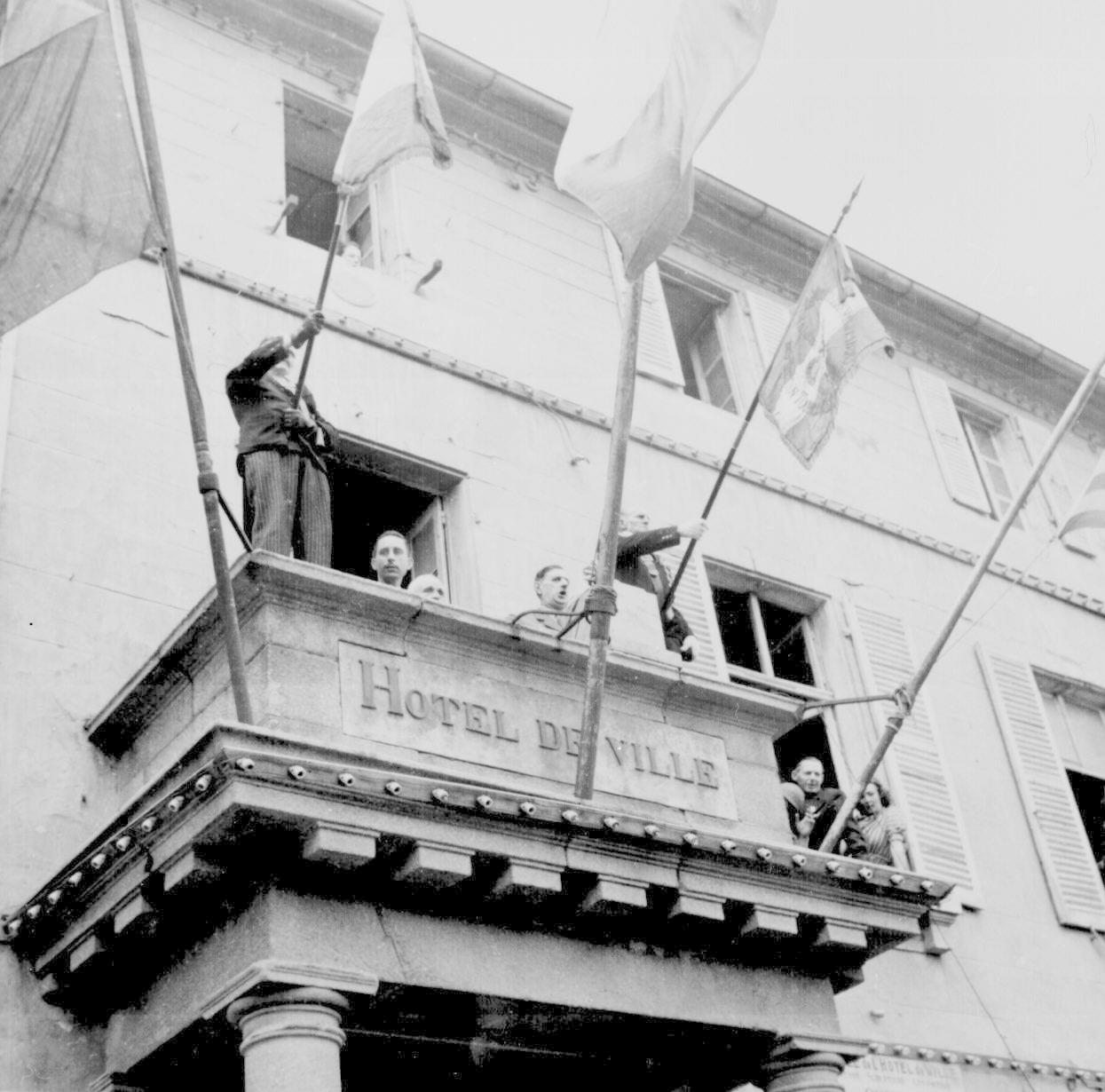 "General Charles
de Gaulle
speaks to the people of Cherbourg from the balcony of the City
Hall during his visit to the
French port city on August 20." 1944.
"General Charles
de Gaulle
speaks to the people of Cherbourg from the balcony of the City
Hall during his visit to the
French port city on August 20." 1944.
National Archives
208-MFI-5H-1
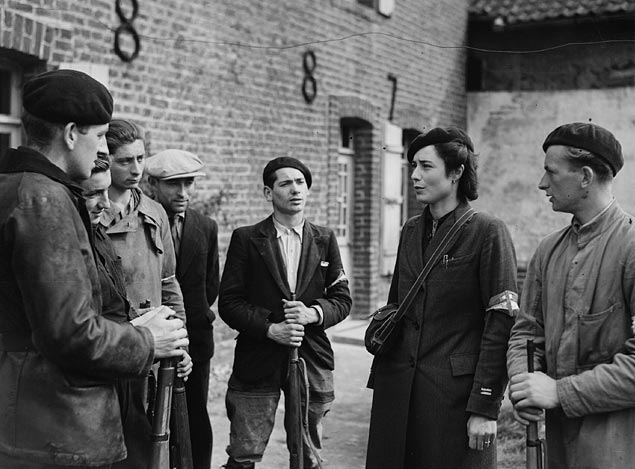 Members of the
Maquis
(French Resistance) in La Tresorerie – Boulogne, France, 14
September
1944
Members of the
Maquis
(French Resistance) in La Tresorerie – Boulogne, France, 14
September
1944
Library and Archives
Canada
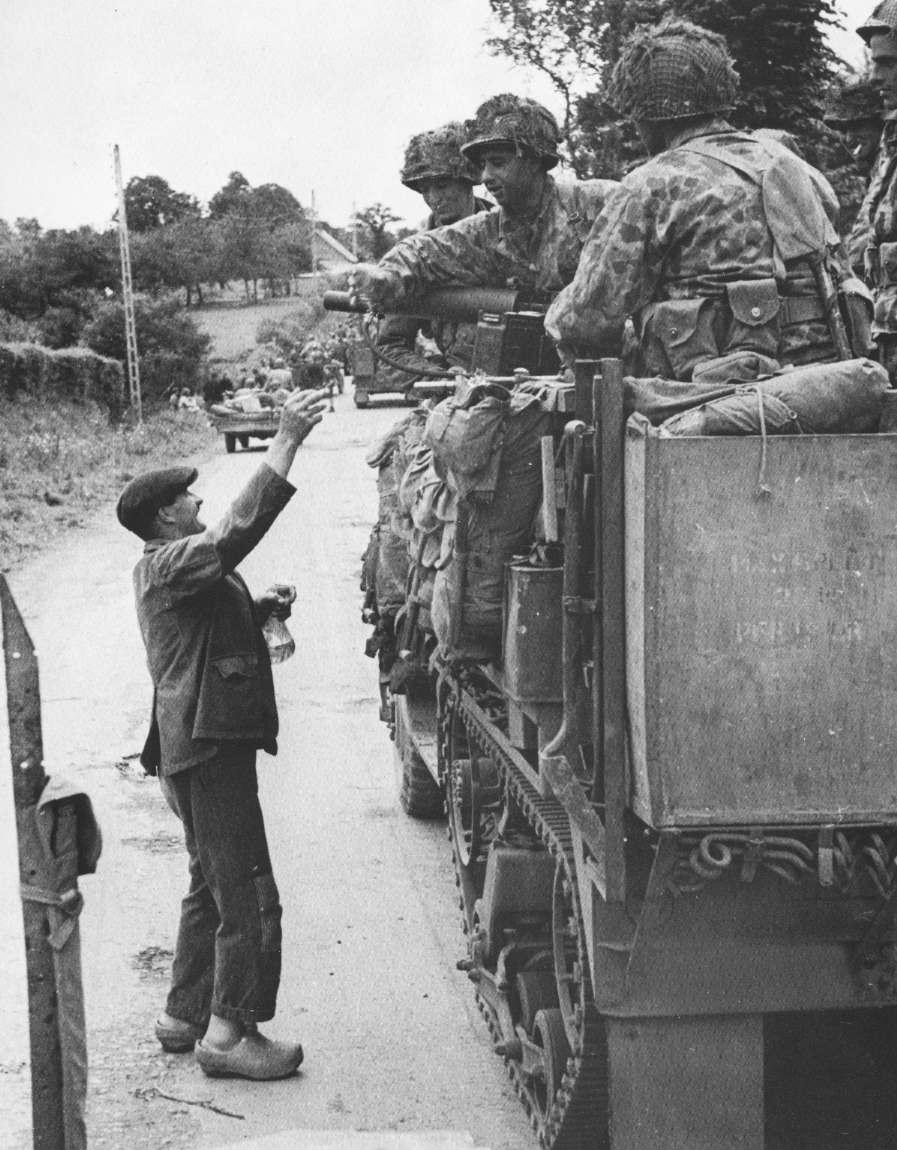 A Frenchman
offering a drink
to GIs on their way to Paris
A Frenchman
offering a drink
to GIs on their way to Paris
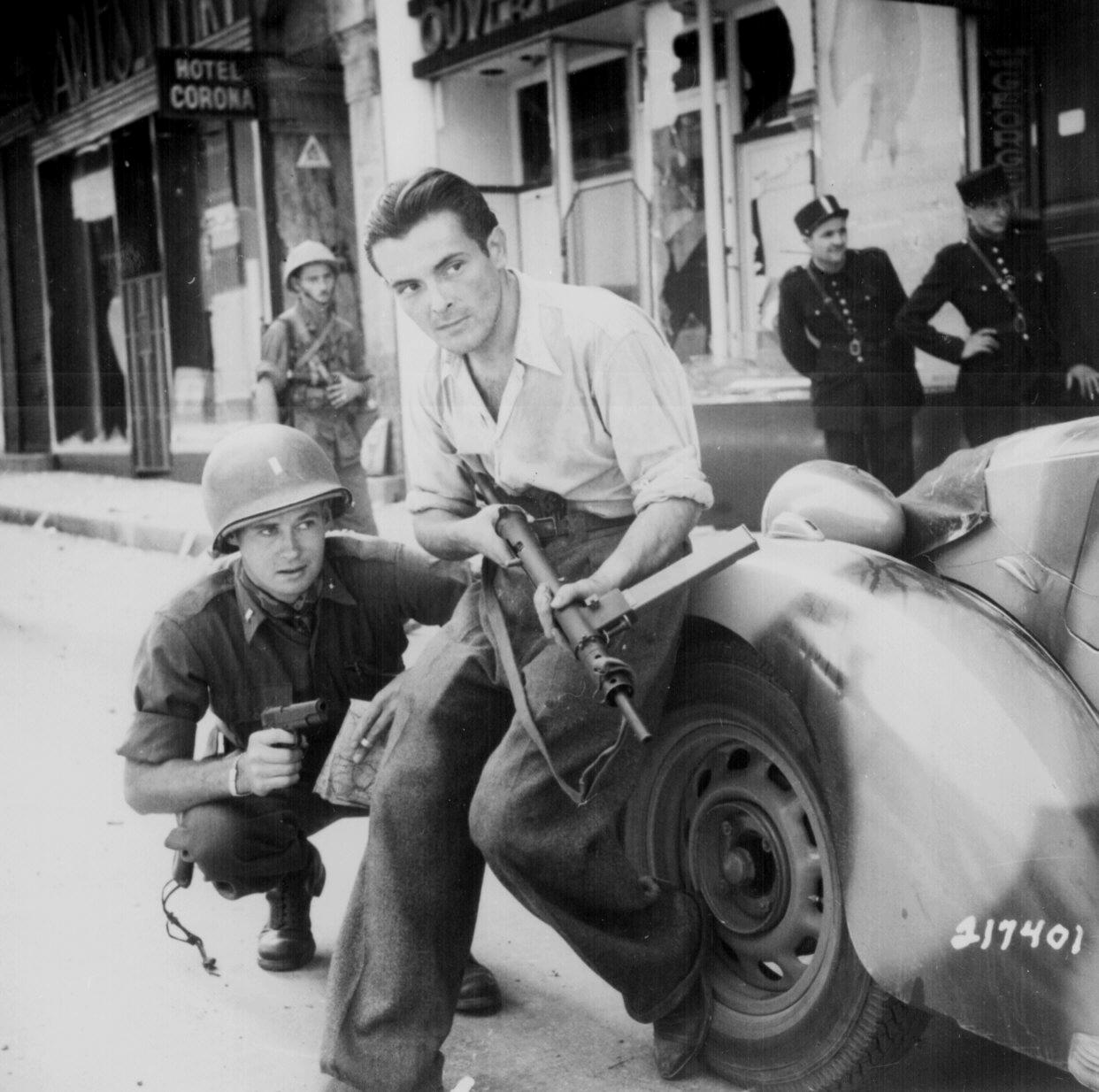 An American
officer and a
French partisan crouch behind an auto during a street
fight
in a French city. 1944.
An American
officer and a
French partisan crouch behind an auto during a street
fight
in a French city. 1944.
National Archives
111-SC-217401
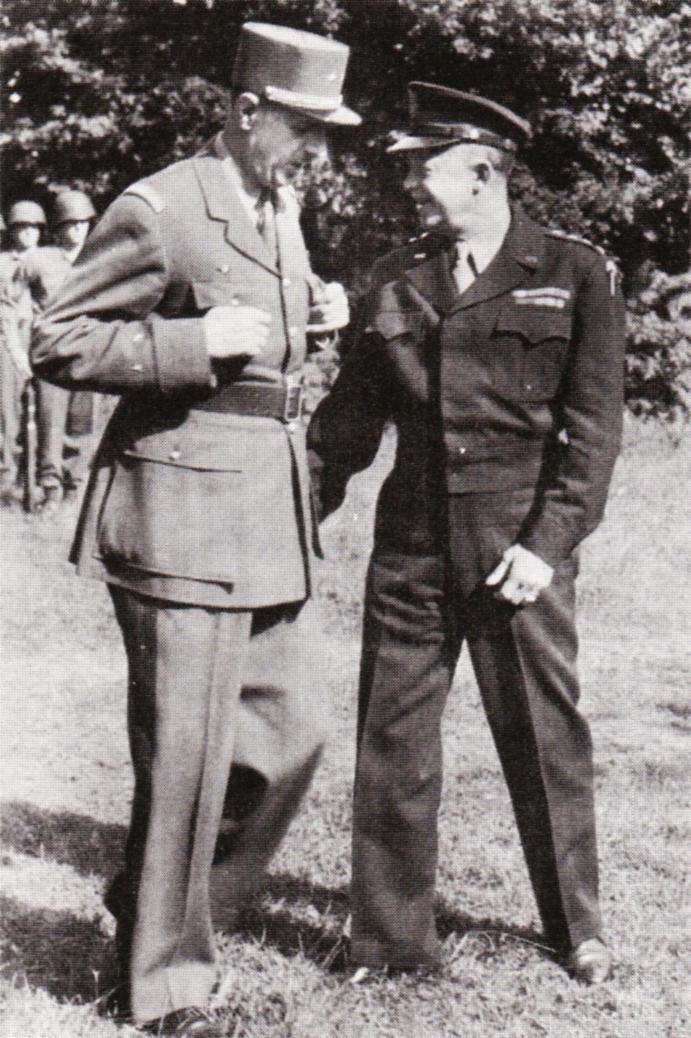 De Gaulle and
Eisenhower
conferring
De Gaulle and
Eisenhower
conferring
National
Archives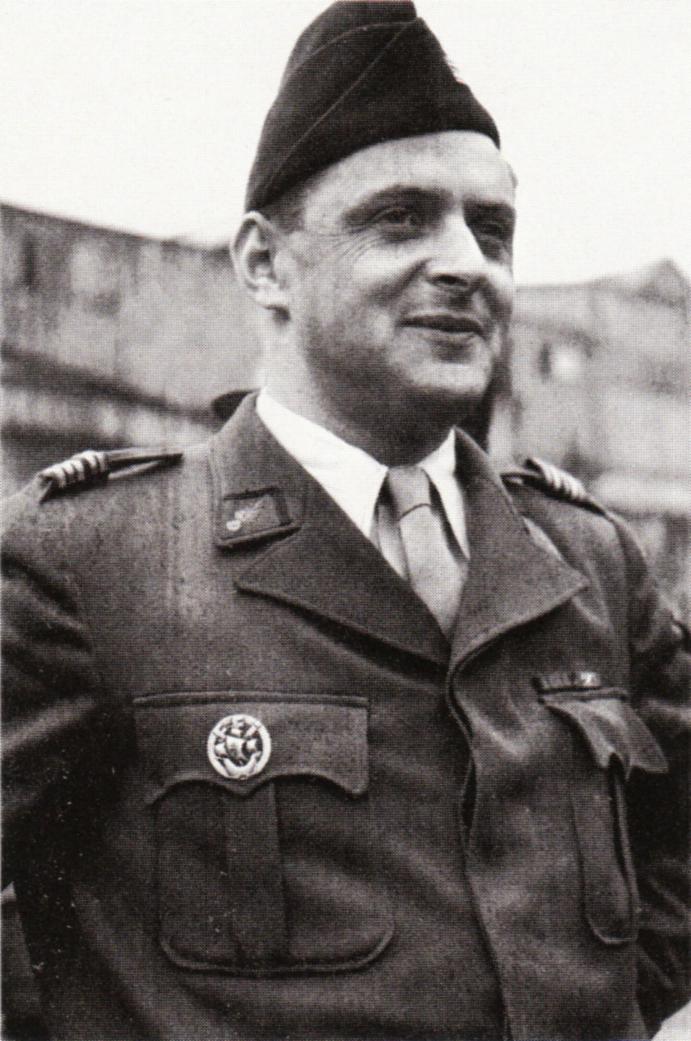 Henri Tanguy -
leader of
the Communist Partisans
Henri Tanguy -
leader of
the Communist Partisans
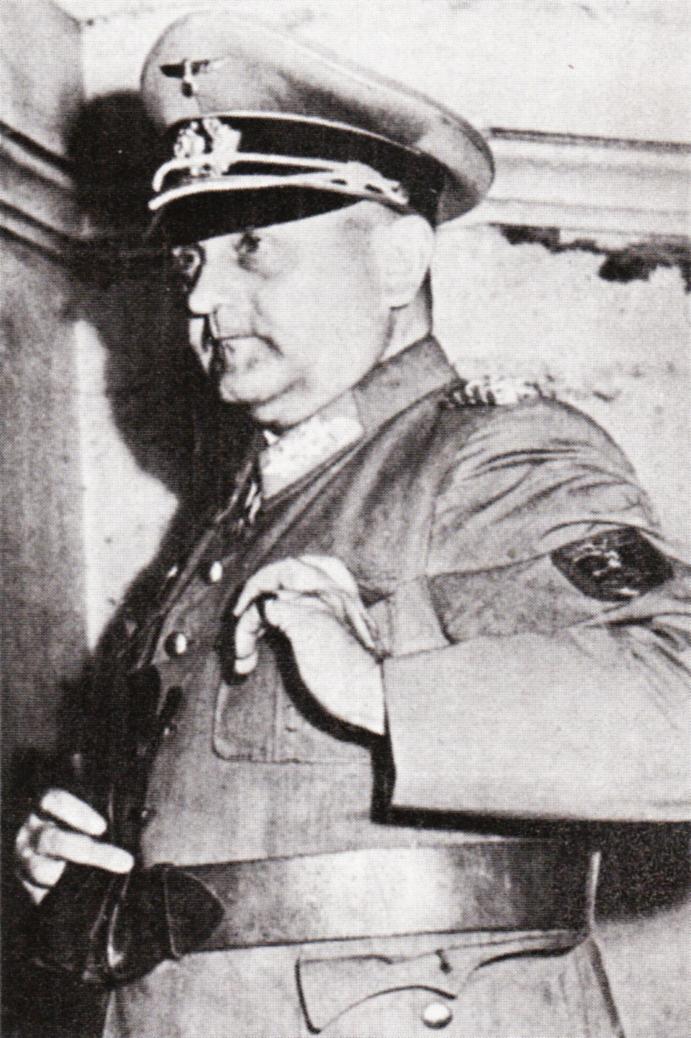
Major General
Dietrich von
Choltitz, German Commander in Paris
National
Archives
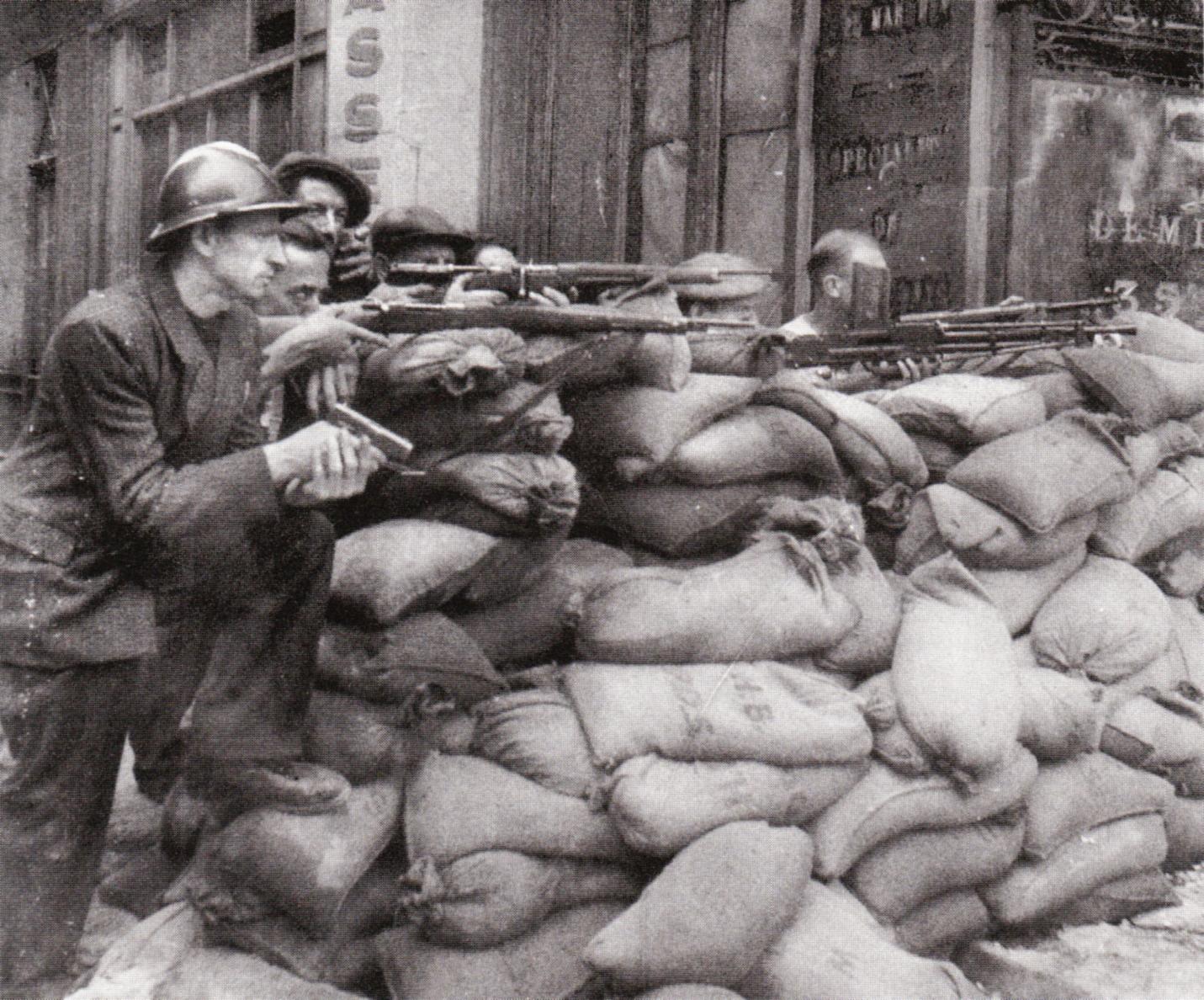 Free French Partisans
taking
a stand at one of the "barricades" in Paris
Free French Partisans
taking
a stand at one of the "barricades" in Paris
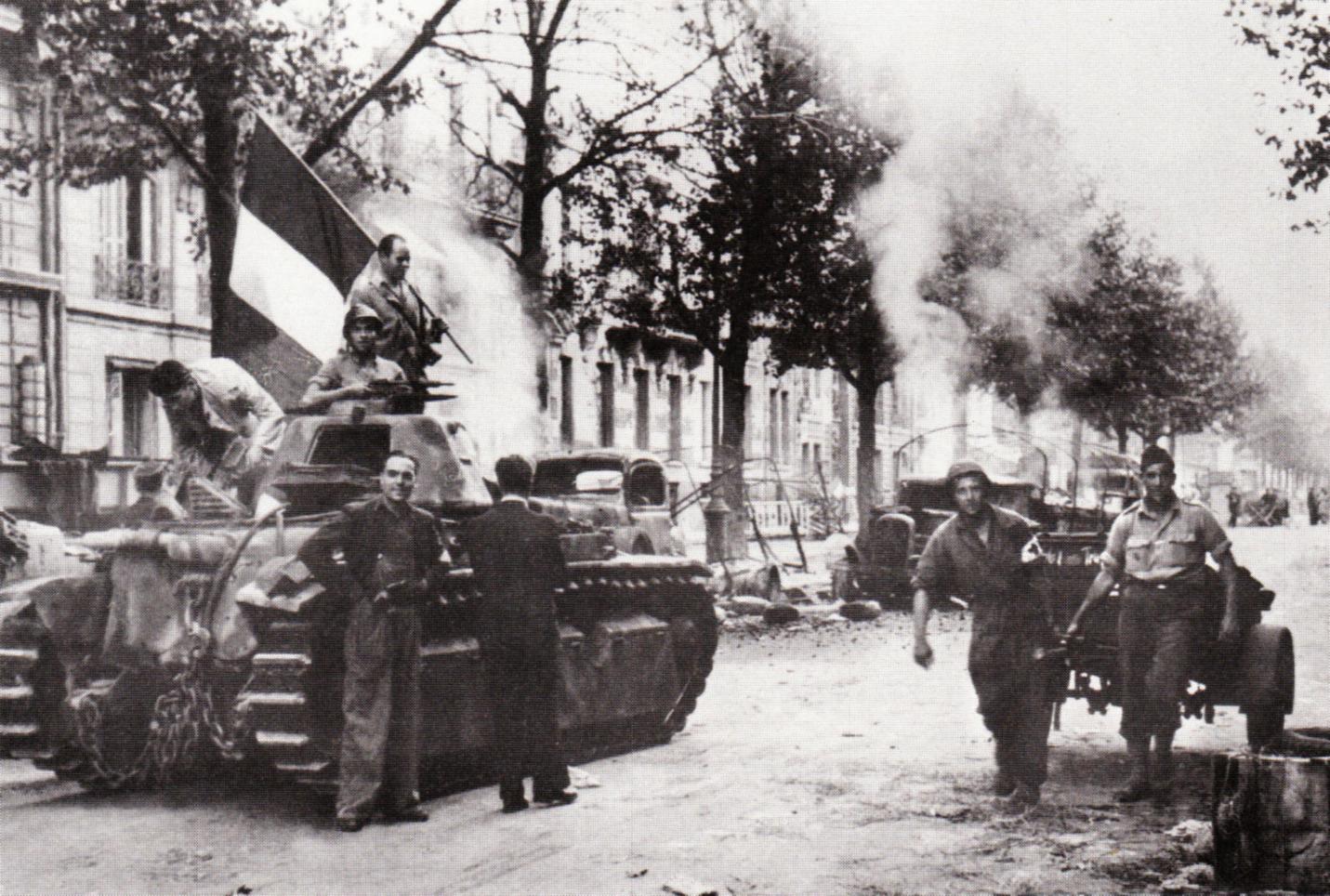
Waving the
French tri-colored
flag in victory atop a captured German tank
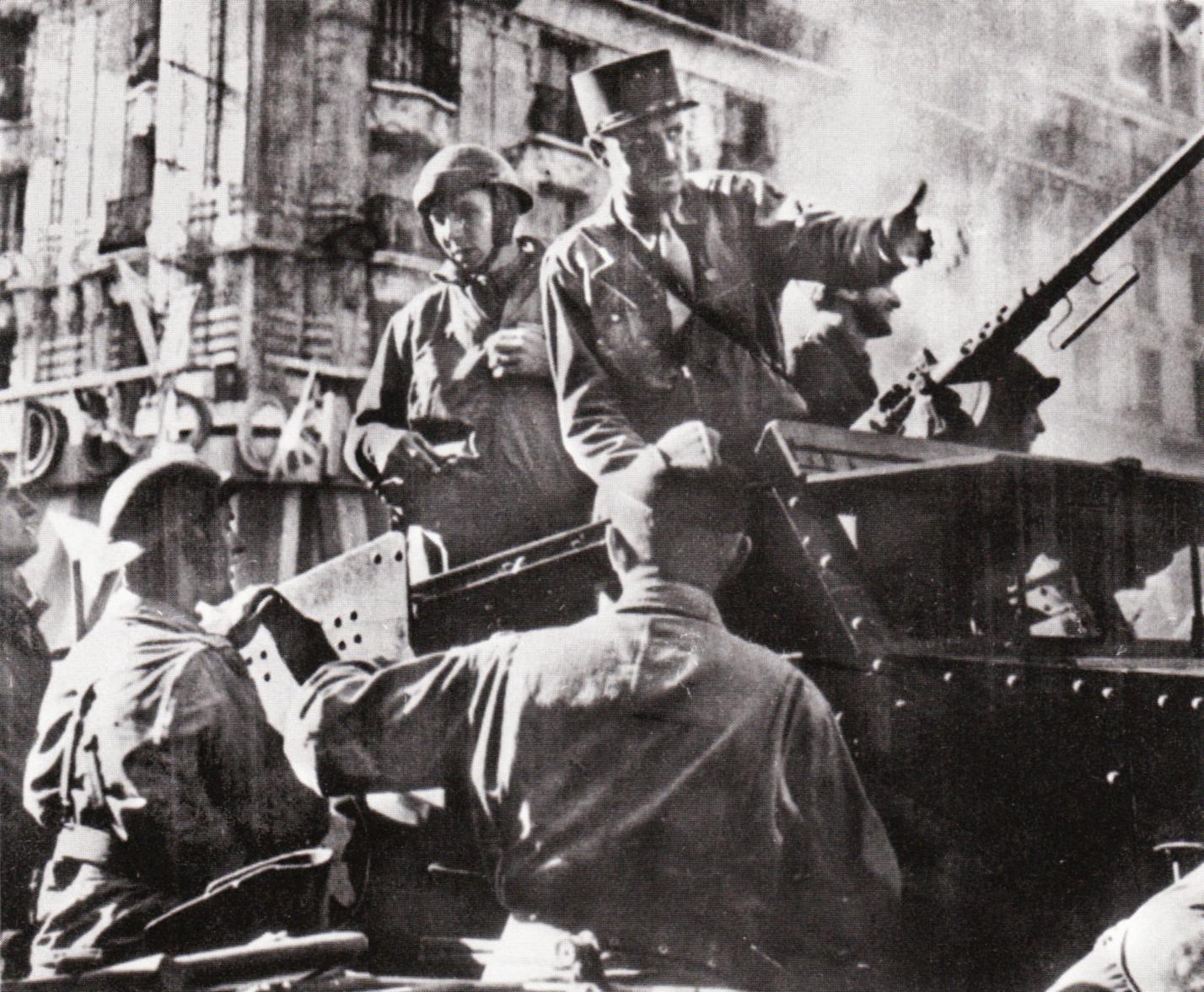
General Jacques
Phillippe
Leclerc directing French action in Paris from his half-track.
National
Archives
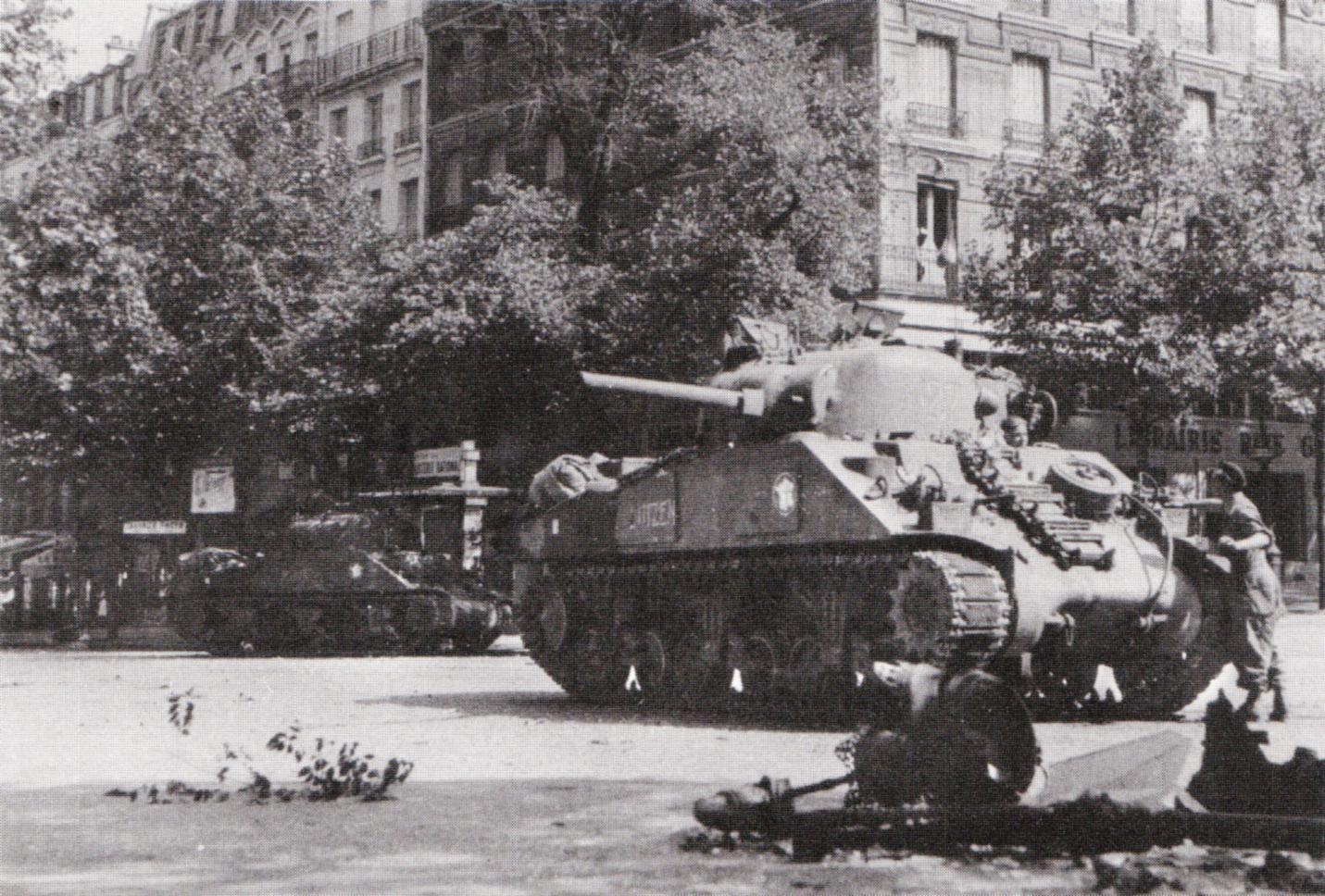
Tanks of Gen.
Leclerc's 2nd
Armored Division moving down the Boulevard St. Michel (August
25)
National
Archives
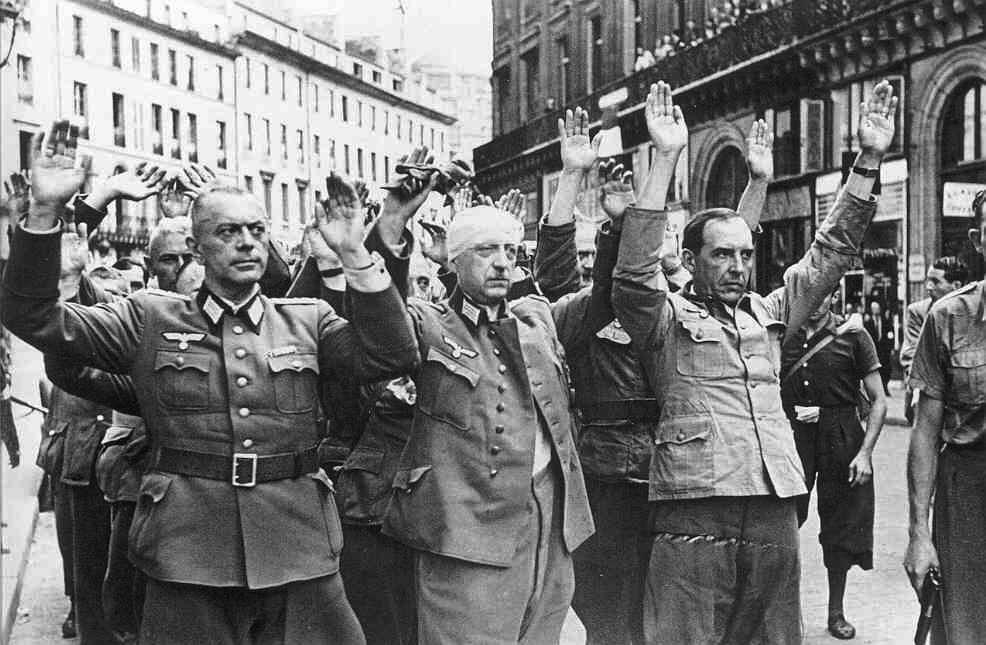
Germans
surrender in Paris – August 25, 1944
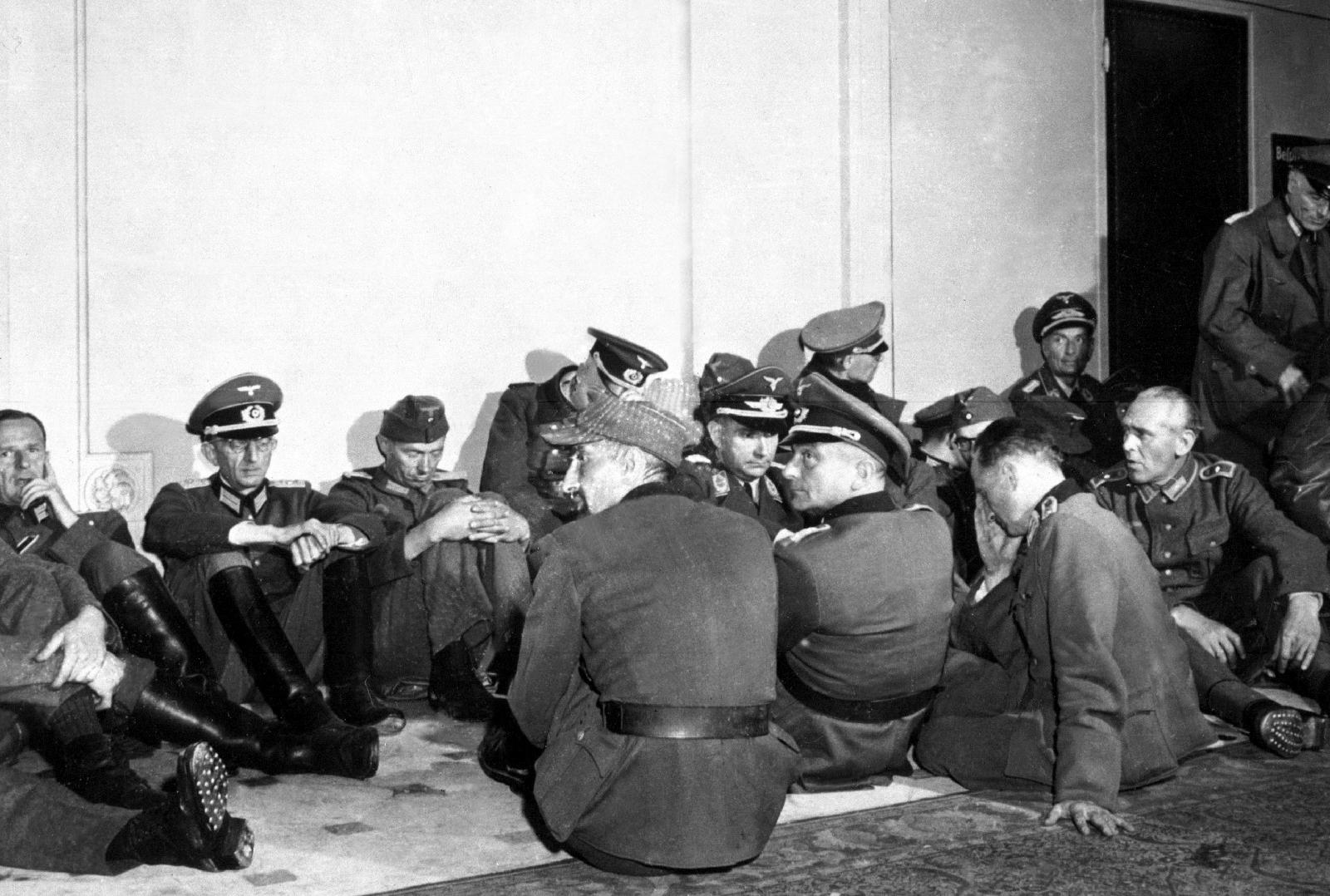
High ranking
German officers
seized by Free French troops which liberated their country's capital are
lodged in the H tel Majestic, headquarters for the
Wehrmacht
in the days of the Nazi occupation, Paris, France.
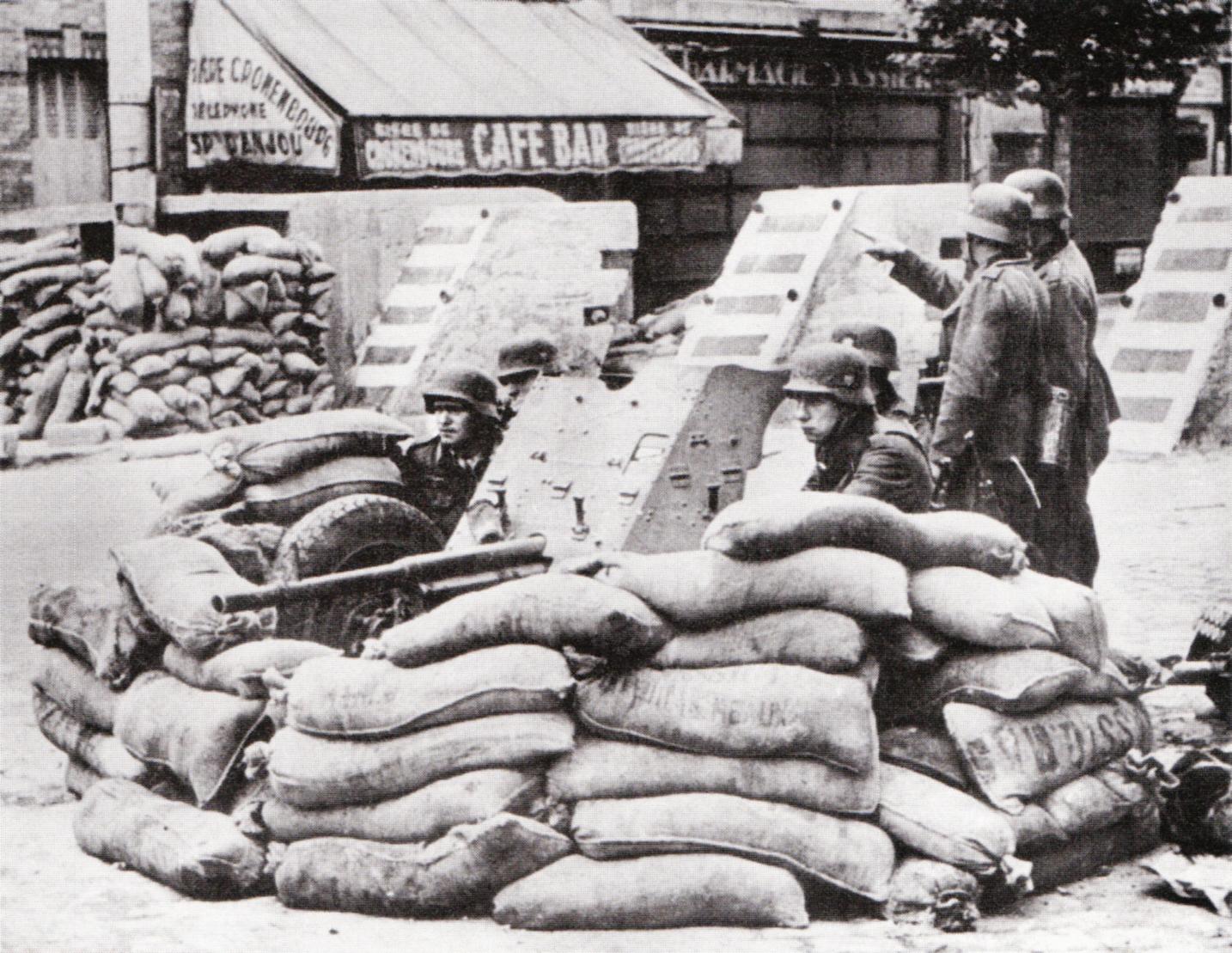
Small pockets of
German resistance
would hold out here and there in the Paris suburbs for the next
week
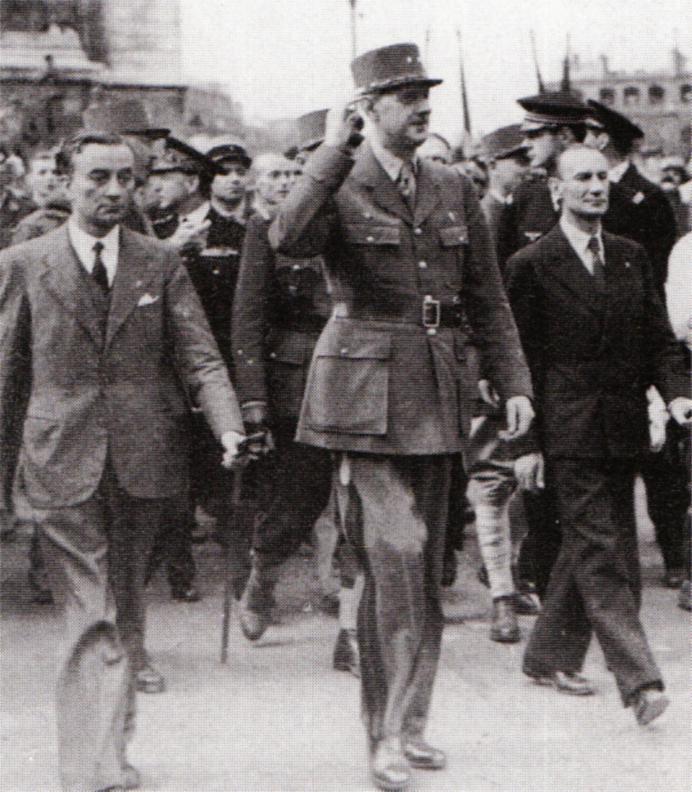
De Gaulle
leading the victory
march down the Champs Elys es – March 26
National
Archives
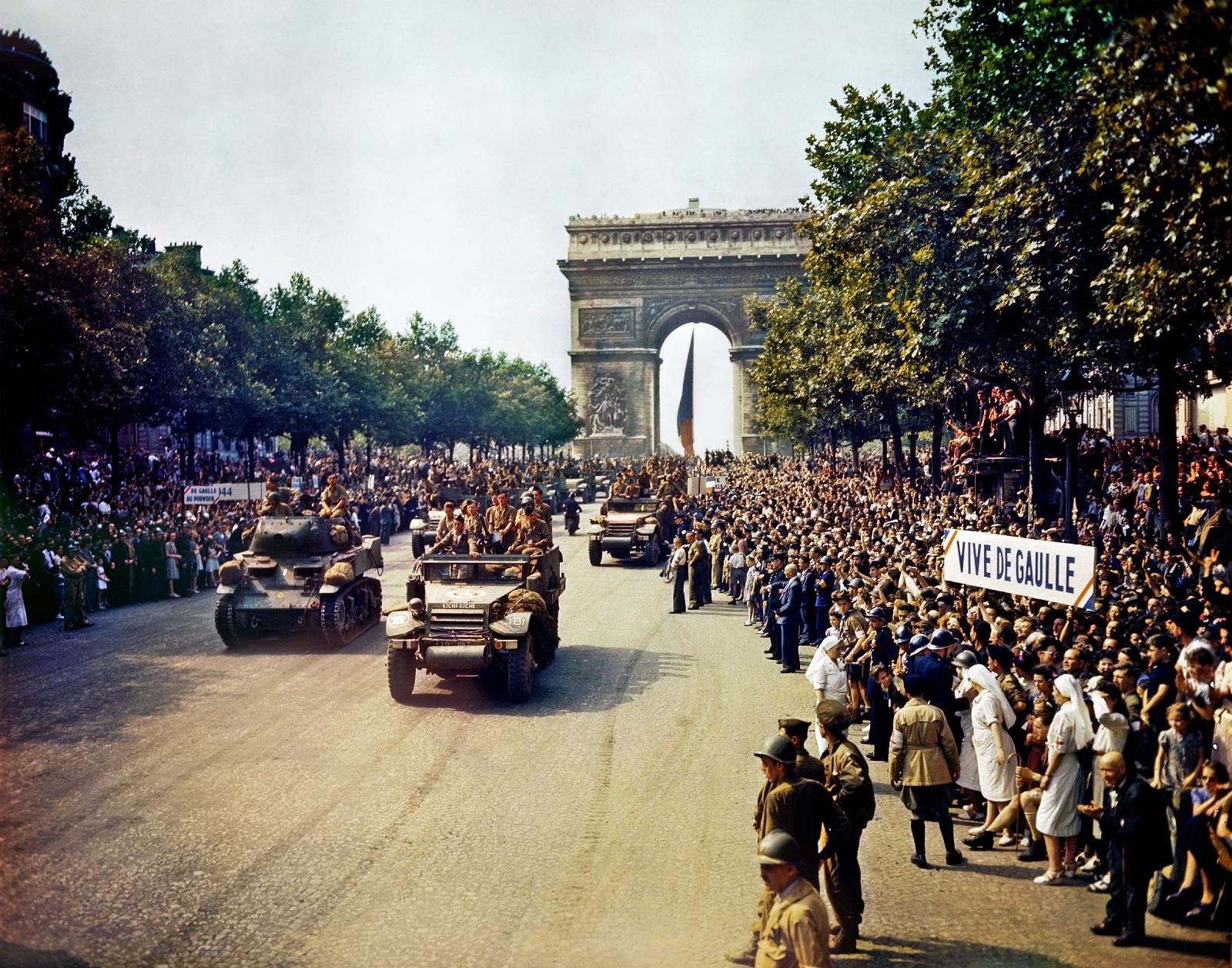
Free French
tanks and half-tracks
of General Leclerc's 2nd Armored Division pass through the Arc de
Triomphe, down the Champs Elys es,
after Paris was liberated. August 26, 1944
Library of
Congress

American troops in tank passing the
Arc de Triomphe after the liberation of Paris, August 1944.
National Archives
208-YE-68
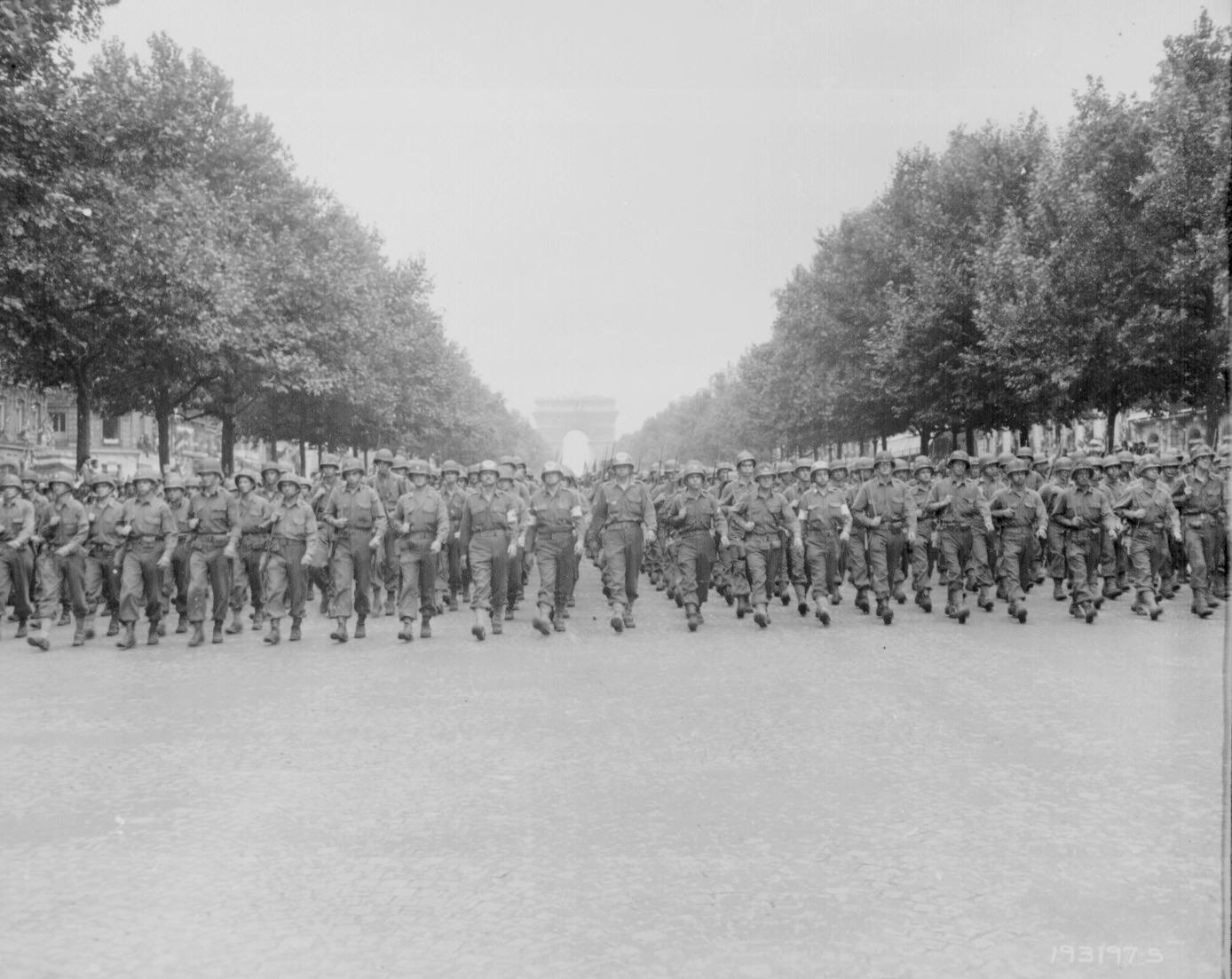
"American
troops of the 28th
Infantry Division march down the Champs Elysees, Paris,in the 'Victory' Parade."
Poinsett, August 29, 1944.
National Archives
111-SC-193197
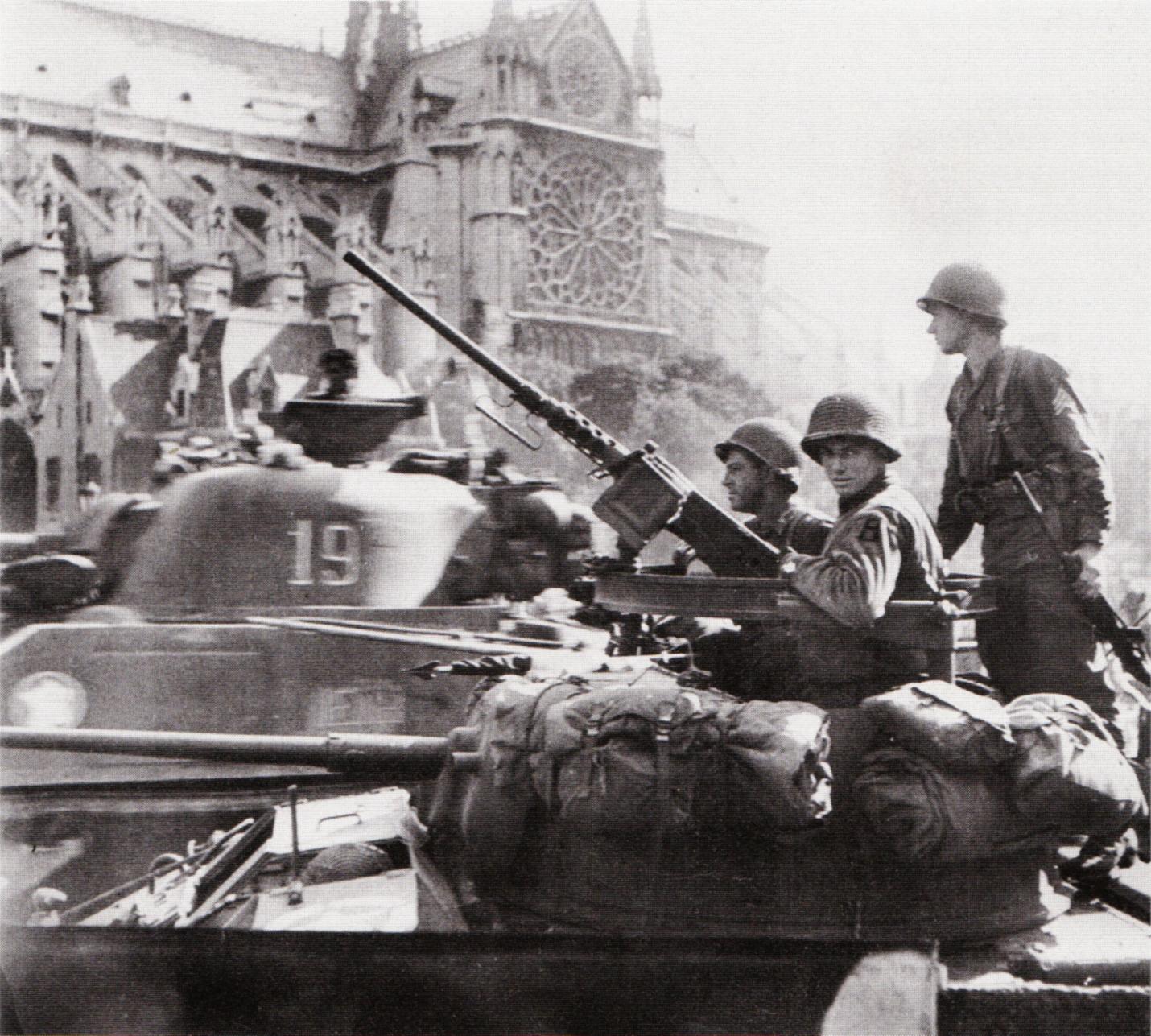
An American
tank crew in
front of the Notre Dame Cathedral
standing ready to defend Paris from German
holdouts
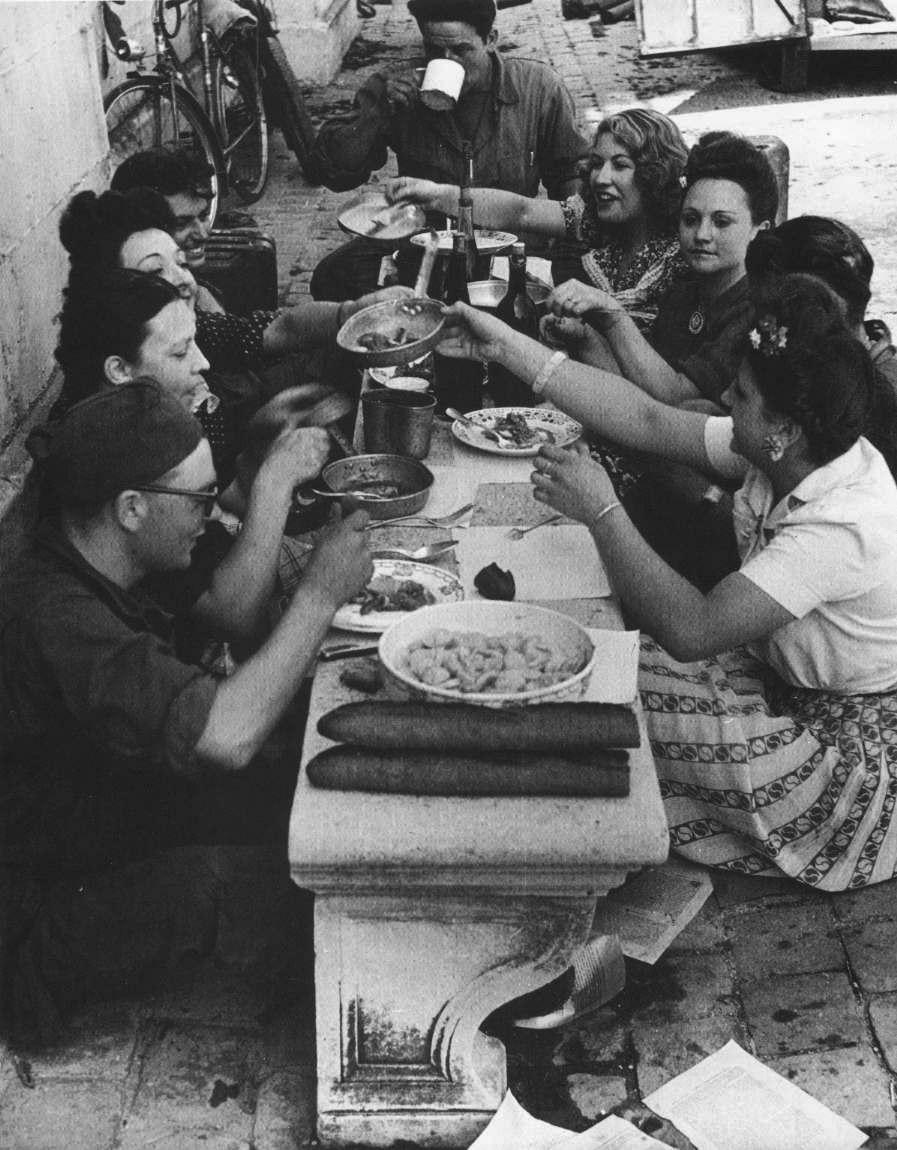
GIs sharing a
streetcorner
feast with the French in Paris

"Bing Crosby, stage, screen and radio
star, sings to Allied troops at the opening of the London stage door canteen in Piccadilly, London,
England." Pearson, August 31, 1944.
National Archives
111-SC-193249
THE SOVIET SUMMER OFFENSIVE ... AND THE DESTRUCTION OF WARSAW |
|
The Soviet summer offensive of 1944
By mid-1944 the Russians
were ready
for a major offensive against the Germans, one designed to drive them
from
the borders of the Soviet Union and the eastern part of Poland that the
Russians had once held under the Molotov-Ribbentrop Treaty with
Germany.
The Russians had been making constant progress against the Germans in
eastern and central Ukraine … and the Russian troops were in high
spirits.
In mid-July the offensive began on three separate fronts and quickly
achieved
its objectives. Indeed, by the end of August the Germans had lost
approximately everything they had gained since June of 1941 when they
had
undertaken the surprise invasion (Operation Barbarossa) of Soviet-held
territory in Poland and even the Soviet Union itself. By the end
of August the Russians had rolled all the way up to the Vistula River
in
central Poland. The Germans were in retreat everywhere in the East.
|
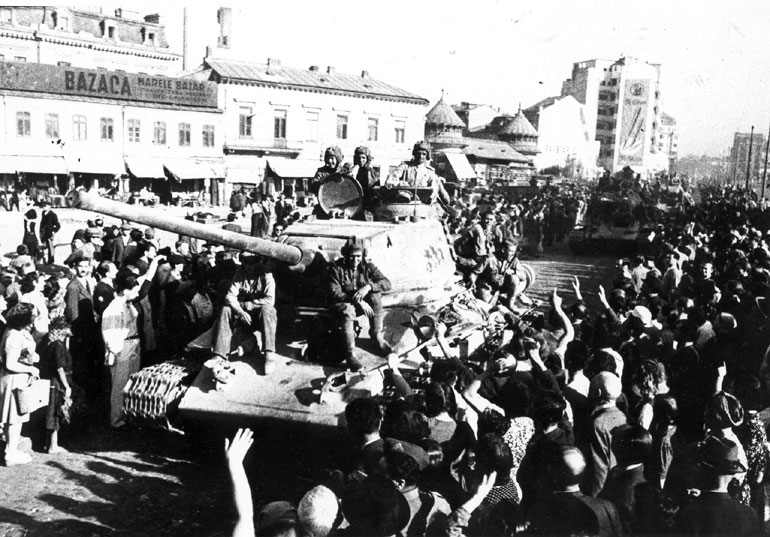
Russian troops being welcomed in the Romanian capital of Bucharest – August 1944
|
Stalin
did not send his troops through Poland to
liberate it
... but to enslave it!
The Warsaw Uprising (August-September 1944). Then
the Russians abruptly stopped their advance. This was because the Polish
Government-in-exile in London had just given the orders for the Polish
Resistance to rise up against its German occupiers – in an obvious
effort to find the Poles in control of the capital before the
distrusted Russians could make their entry into the city.
But Stalin
was going to have none of this. He had already created his own Polish
government-in-exile, a Communist group that he intended to place in power
over Poland – and to control fully. So he ordered his Russian troops to
halt and let the Germans do what he knew they by instinct would do to
the rebels: destroy them all ... and possibly even their beautiful and
ancient capital city of Warsaw.
Mass destruction. Stalin proved right in his estimation of
the Germans. The Germans were brutal. Some 150,000 to 200,000 Poles
were killed by the Germans. And Warsaw was nearly completely destroyed
– by careful design of the Germans themselves, who torched the
buildings that their bombs had not destroyed.
With the surrender of the Polish
resistance (October 2, 1944), the surviving civilian population was
removed from the city by the Germans and sent to a transit camp for
scrutiny, with nearly 100,000 sent to labor camps and some 60,000 sent
to concentration (or "death") camps.3
During
this time, Russian action in the region had halted completely ... and
was resumed
under Stalin's orders only when the Polish resistance movement was
crushed by the Germans ... and Warsaw destroyed. Then and only then
was
Stalin willing to have the Russians resume their
offensive against the Germans … "liberating" (taking control of) a
broken
city which the Russians then intended to govern.
3After the war Stalin had these same returning Polish prisoners arrested (sent off to Soviet
concentration camps in Siberia or even executed directly) on various
charges (including even Fascism!), fearing such former Polish activists
would become potential rebels against his own rule in Poland (through
compliant Polish Communists).
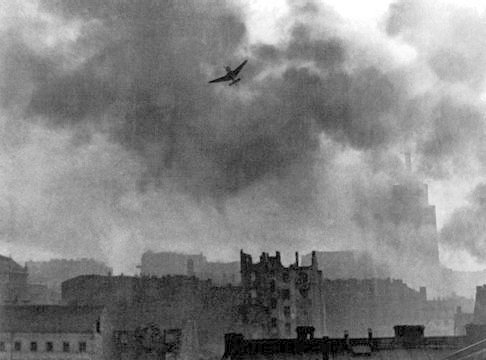
A German Stuka Ju-87 bombing Warsaw's Old Town – August 1944
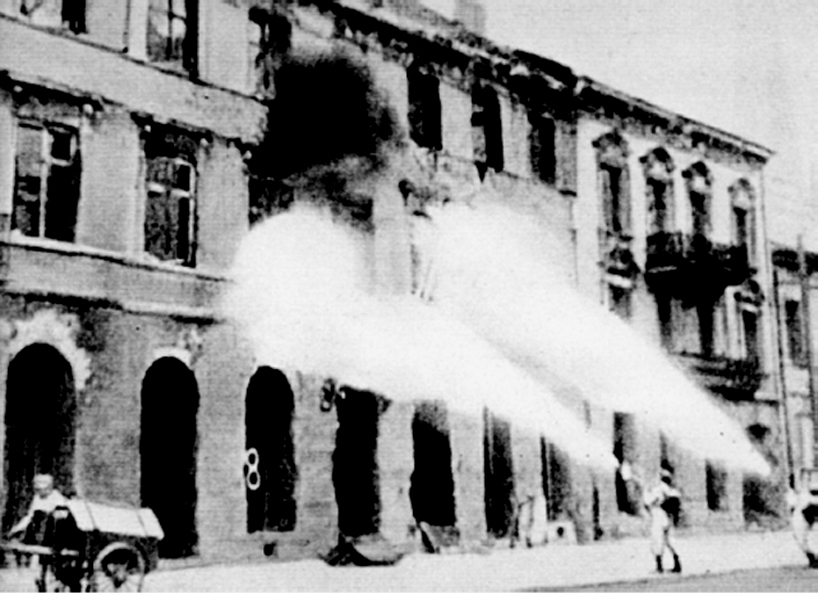 German soldiers of the
Brennkommando torching Warsaw buildings
German soldiers of the
Brennkommando torching Warsaw buildings
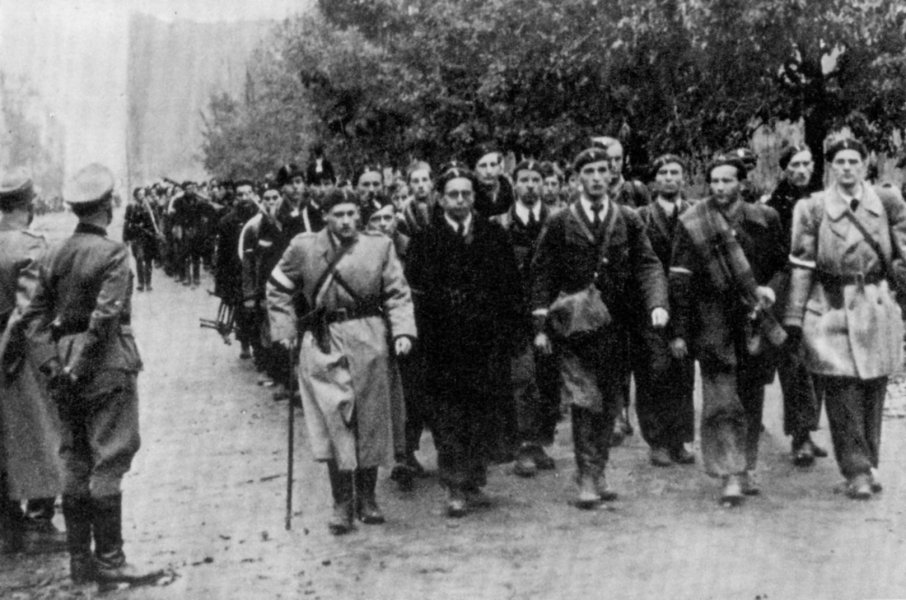
The Polish Uprising ceases with the surrender of the Polish resistance – October 2, 1944.
Then – and only then – Stalin ordered his troops to resume their attacks on the Germans!
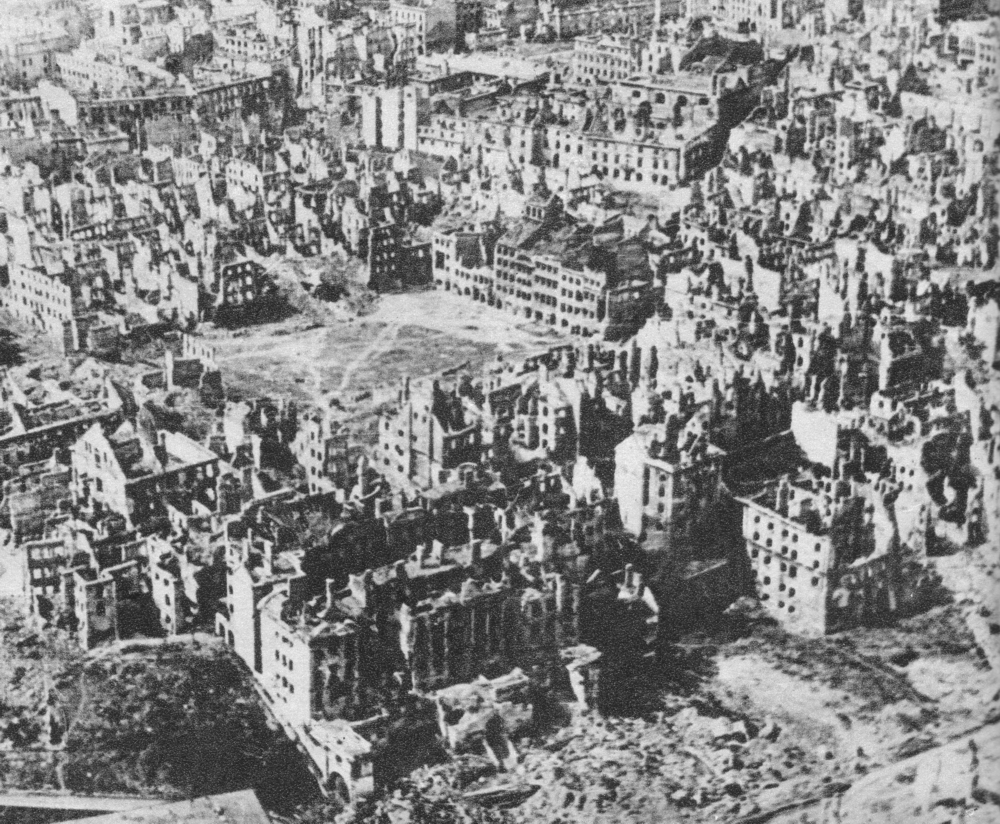
A greatly devastated Warsaw
THE GERMANS HOLD THE LINE IN THE NETHERLANDS .... AND UNDERTAKE A COUNTERATTACK IN BELGIUM |
 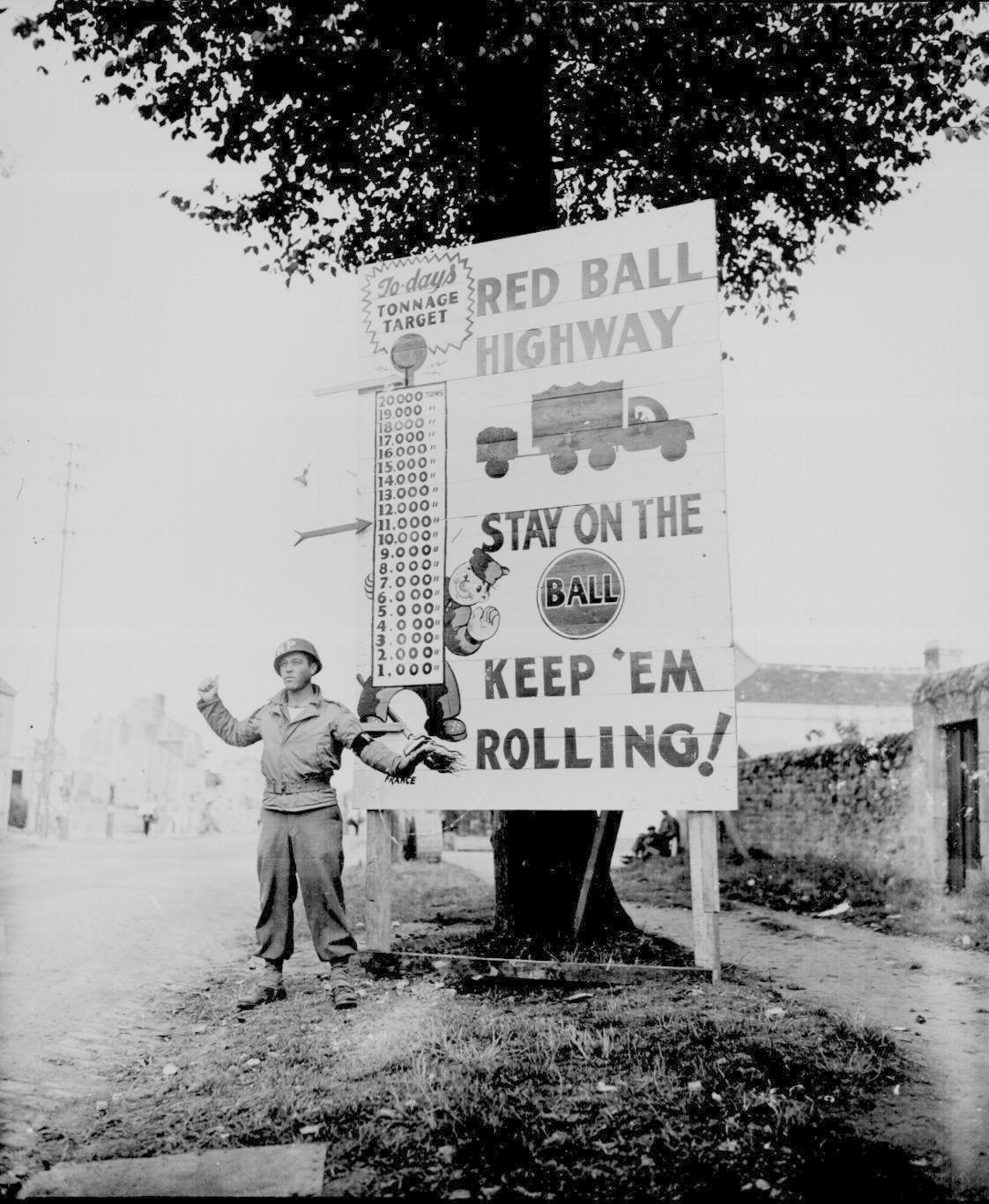 "Corporal Charles H. Johnson of the
783rd Military Police Battalion, waves on a 'Red Ball Express' motor convoy rushing priority
materiel to the forward areas, near Alen on France." Bowen, September 5, 1944.
"Corporal Charles H. Johnson of the
783rd Military Police Battalion, waves on a 'Red Ball Express' motor convoy rushing priority
materiel to the forward areas, near Alen on France." Bowen, September 5, 1944.
National Archives
111-SC-195512
|
The failed Operation Market Garden in the Netherlands (September-November 1944)
British General Montgomery, who commanded the northern flank of the Allied Army in the West, was given the lead4
in implementing a concentrated assault on the German defenses in the
north of Holland – the purpose being to gain a crossing of the Rhine
River in the more lightly defended Netherlands. Montgomery's claim was
that this would allow the Allies to swing around from the North,
encircle the heart of industrial Germany and gain quick access to
Berlin, possibly bringing the war to an end before Christmas.
Although numerous paratroopers were
dropped behind German lines to take control (protection) of the vitally
needed bridges, bringing up ground troops to help secure this northern
passage proved to be far more difficult than Montgomery had
anticipated. Troop movement had to take place along narrow roads
elevated above the often-swampy surrounding land and through Dutch
towns, where the population poured out onto the streets to celebrate
their freedom with their Allied liberators, often bringing troop
movement to a near halt. Thus the element of surprise was completely
lost. The Germans were quick to understand the Allied program and move
their troops not only into strong defensive positions, but capture most
of the paratroopers at these vital bridges. The whole thing turned into
a monumental disaster
4This would infuriate American general Patton, whose tank corps was making
good headway against the Germans as it advanced toward Germany itself.
For this meant not only diverting important supplies (especially fuel
for his tanks) to his nemesis Montgomery but also the loss to Patton of
the glory that both men sought on the battlefield!
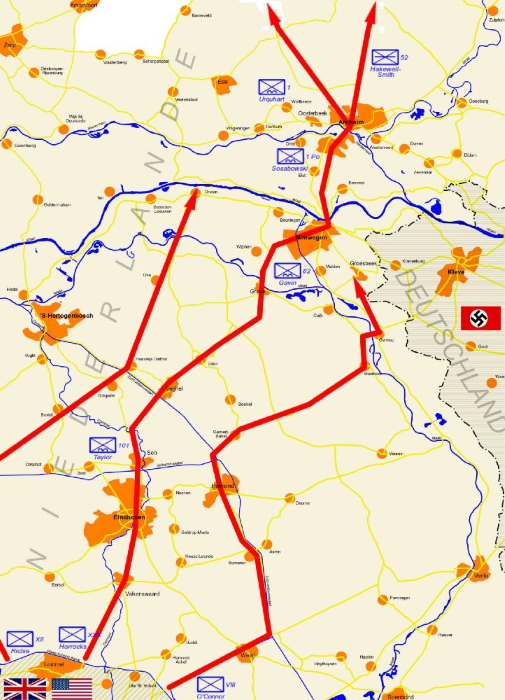
The original plan
for Operation
Market Garden – September 17-25 1944
Wikipedia -
"Operation
Market Garden"
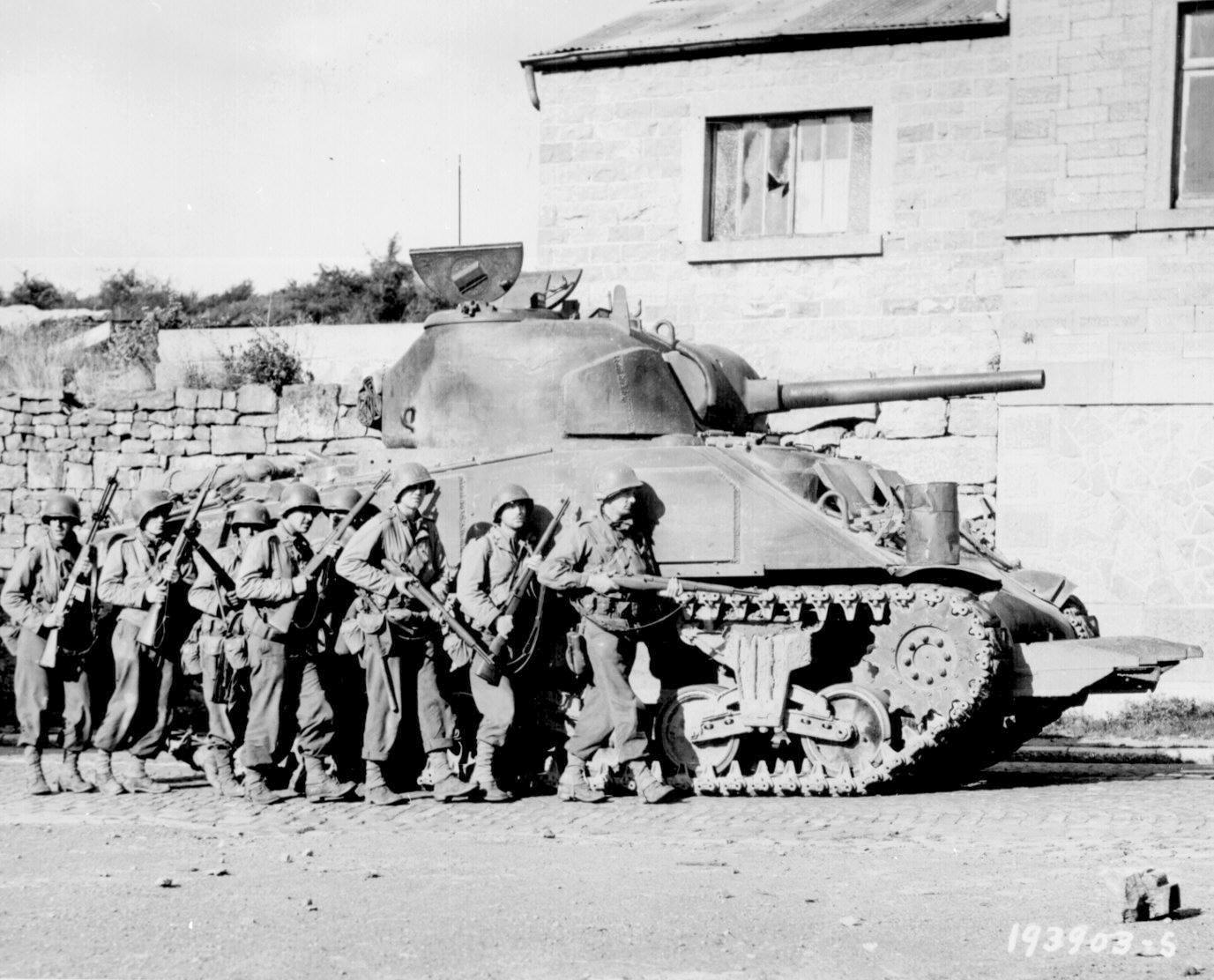
Yanks of 60th
Infantry Regiment
advance into a Belgian town under the protection of a heavy
tank. September 9,
1944.
National Archives
111-SC-193903
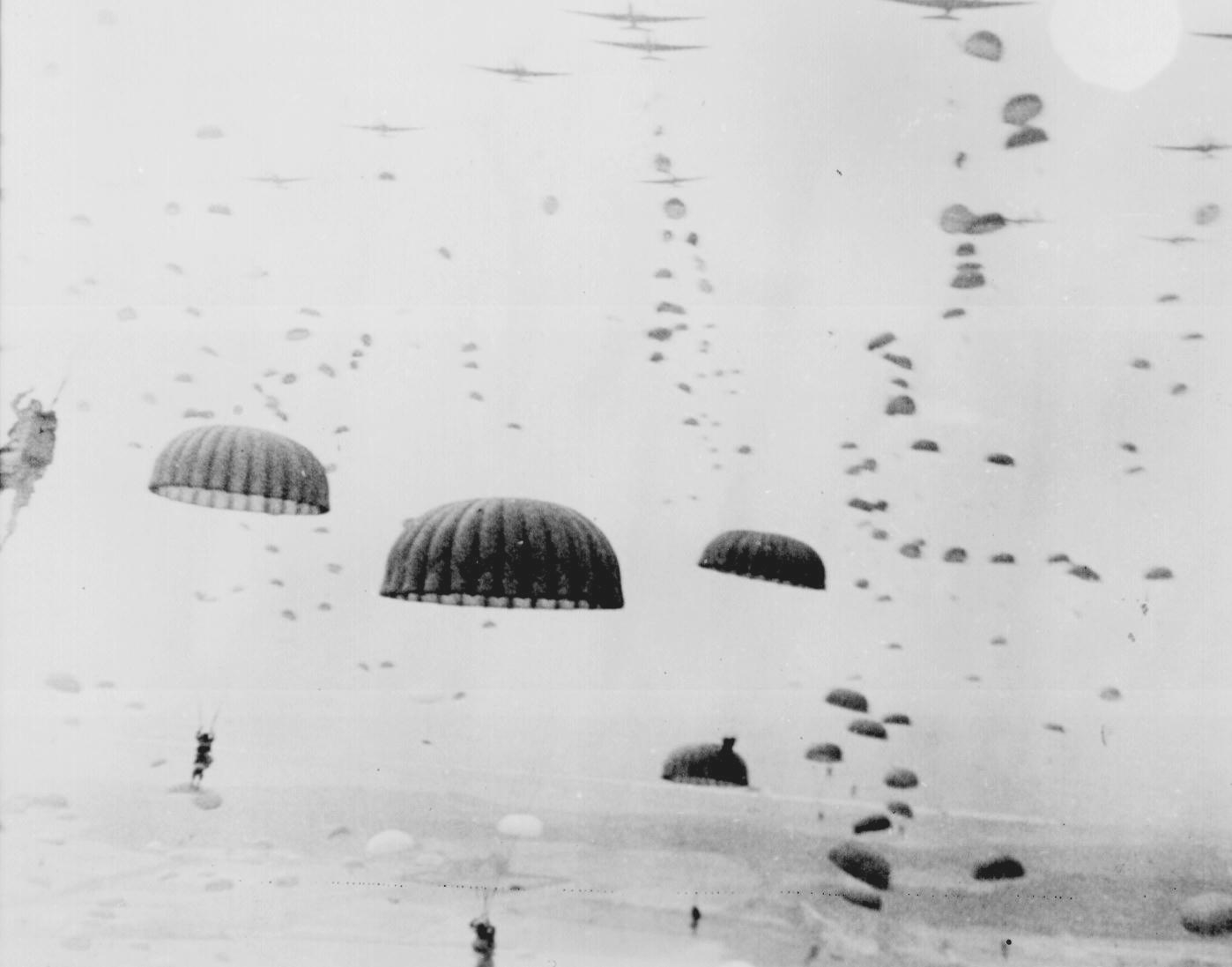
Parachutes open
overhead
as waves of paratroops land in Holland during operations by the 1st Allied Airborne
Army. September 1944.
National Archives
111-SC-354702
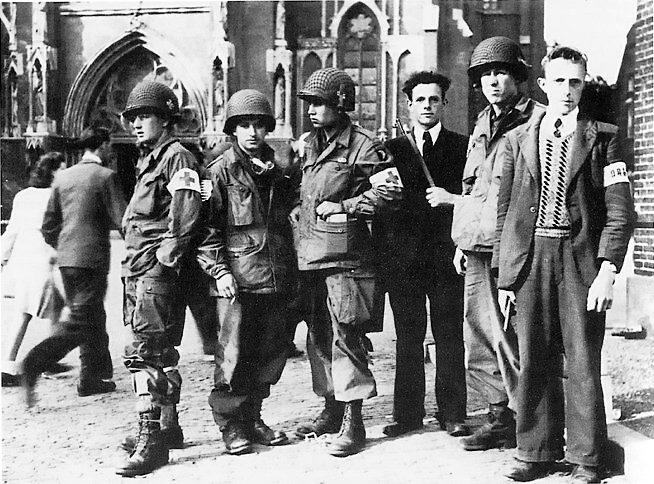 The 101st
Airborne with members
of the Dutch Resistance in front of the Eindhoven
cathedral.
The 101st
Airborne with members
of the Dutch Resistance in front of the Eindhoven
cathedral.
CIA
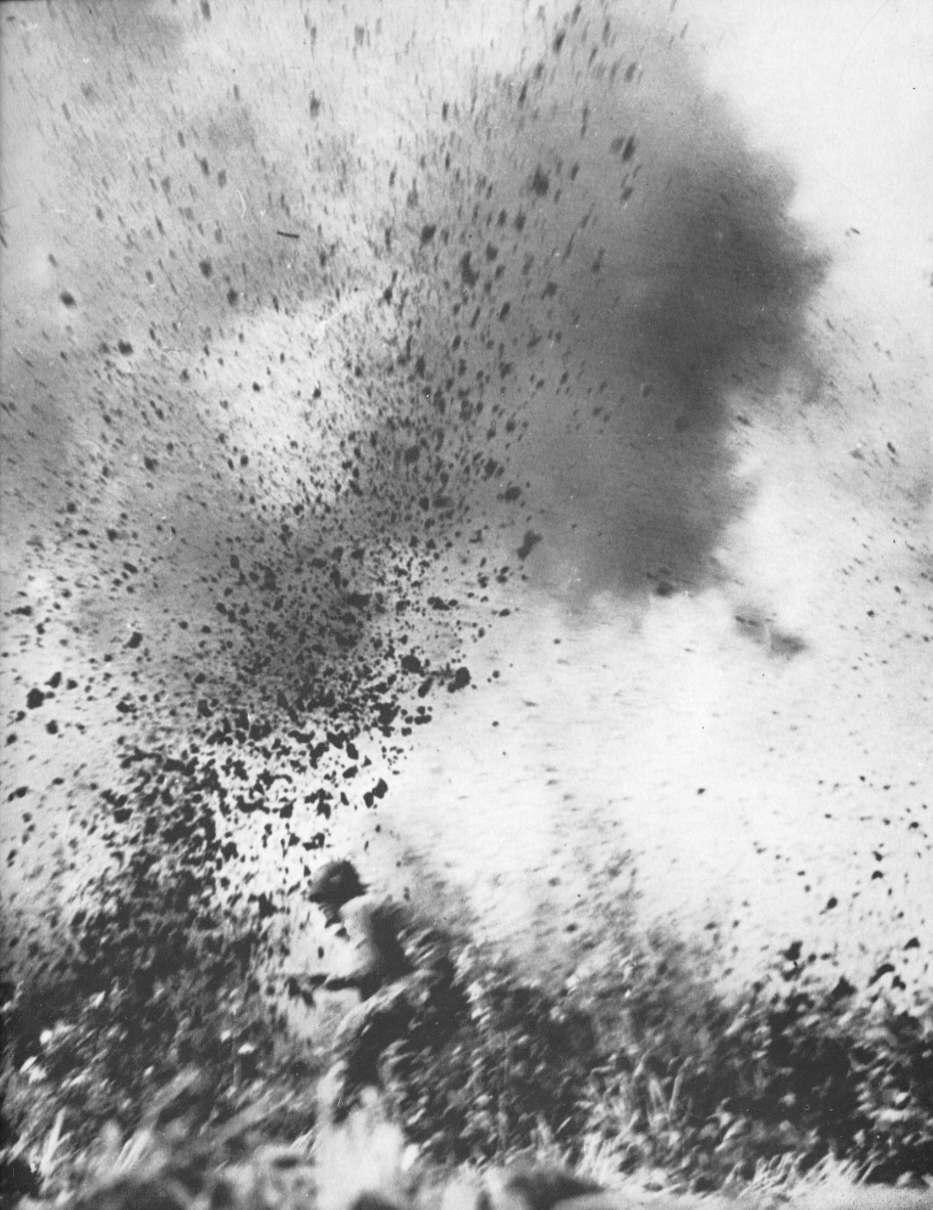 A paratrooper in Holland
under fire
A paratrooper in Holland
under fire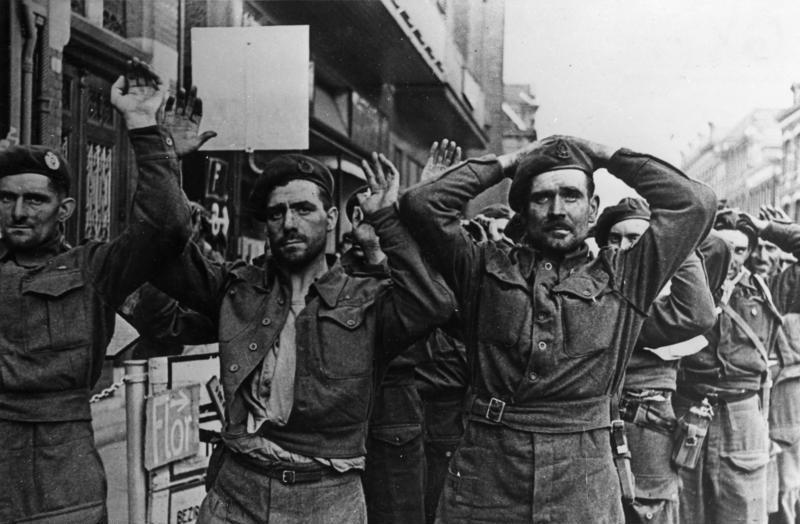 British prisoners
taken at
Arnhem by the Germans
British prisoners
taken at
Arnhem by the Germans
Deutsches Bundesarchiv

"A U.S. Infantry
anti-tank
crew fires on Nazis who machine- gunned their vehicle, somewhere in Holland." W.
F. Stickle, November 4, 1944.
National Archives
111-SC-197367Meanwhile, elsewhere the
advance against the Germans continues
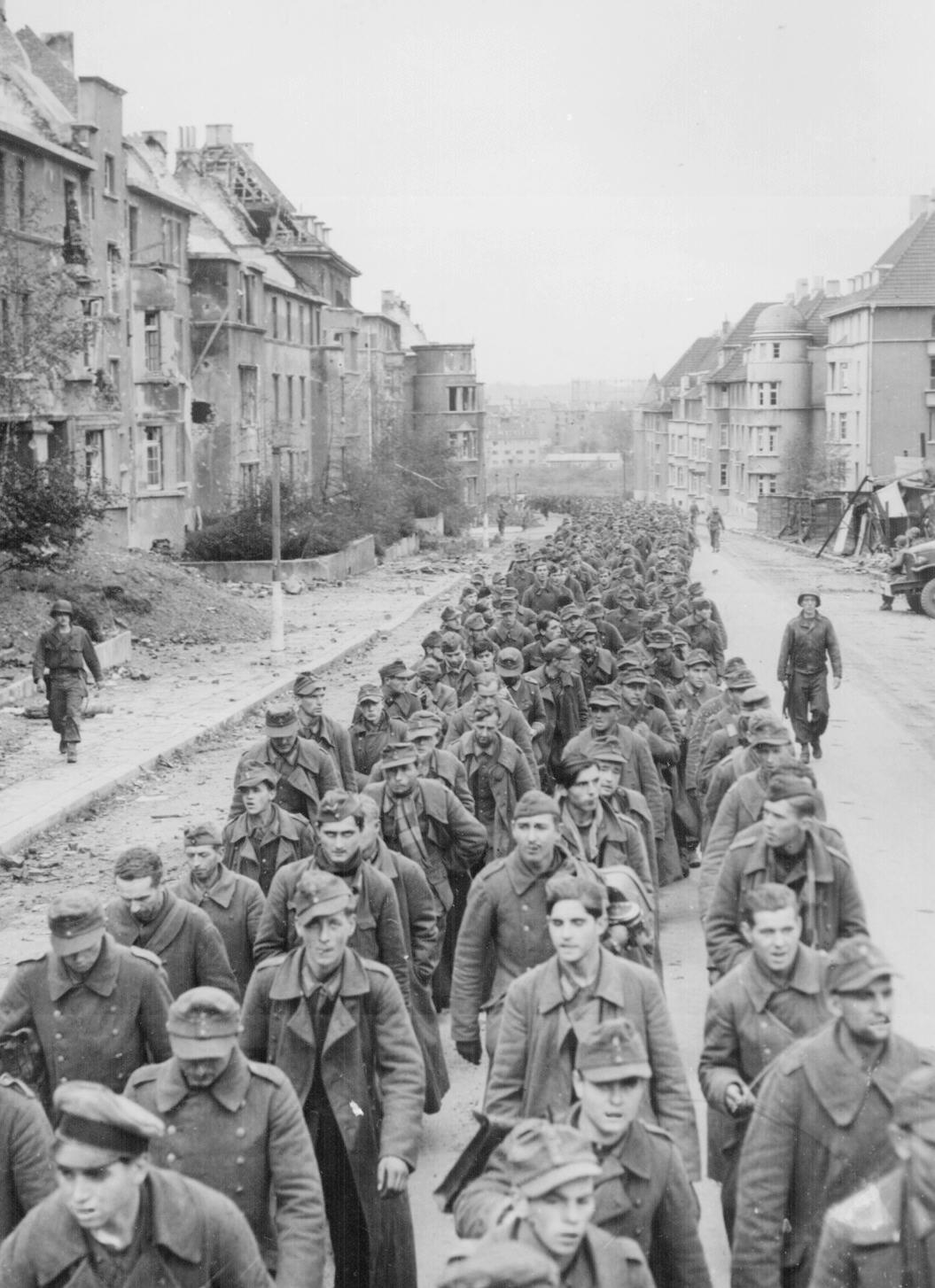
"The endless
procession of German prisoners captured with the fall of Aachen marching through the ruined city streets
to captivity." Germany, October 1944.
National Archives
260-MGG-1061-1 Meanwhile ... back in the States, Roosevelt
is elected to a fourth term of office as US President
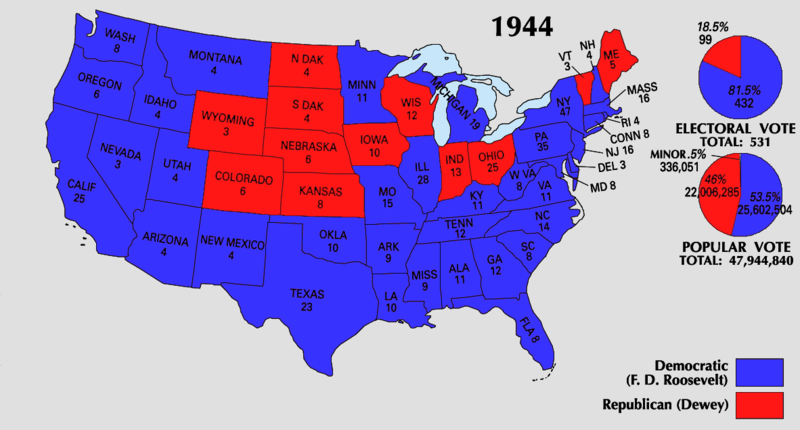 The presidential
election
of November 1944
The presidential
election
of November 1944
Department of the
Interior
|
The Battle of the Bulge (December 1944)
In the middle of December 1944, the Germans
totally surprised the Allies with a well-prepared attack on the densely
wooded section of the Ardennes Forest in Belgium, catching the Allies
off guard and thus thrusting deep into Allied lines, thus creating a
deep bulge in the Allied line of advance. The "Battle of the Bulge" was
thus underway. The German goal was to reach the key port of Antwerp,
shut down the Allies' vital operations there, and seize Allied supply
bases (supplies greatly needed by an impoverished German army) along
the way.
Hitler's generals tried to reason with
Hitler concerning all of the dangers involved in such a move. But
Hitler's mental state at this point was such that he thought himself
totally brilliant as a military strategist and ignored the warnings.
In the end, his advisors proved right. It
turned out to be a grand disaster for the Germans. Americans refused to
give up the key crossroads town of Bastogne, and when the clouds lifted
on Christmas Eve, Allied planes were able to conduct ruinous attacks on
the German positions. The Germans were thus forced to retreat back into
Germany, now as broken in the West as they were in the East.
|
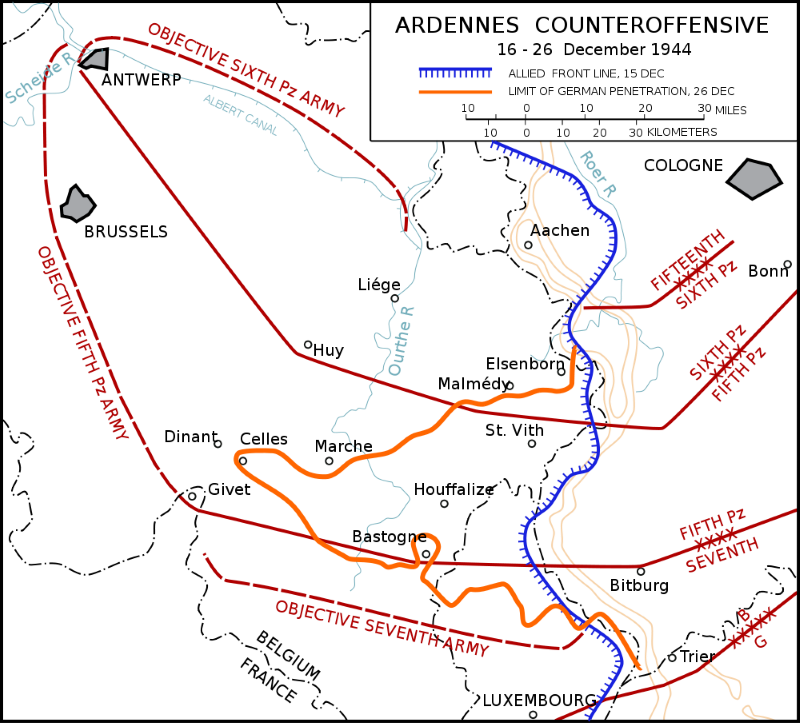
|
The German offensive, 16-26
December 1944
The U.S. Army in World
War II – The Ardennes: The Battle of the Bulge.
American soldiers were caught
completely by surprise
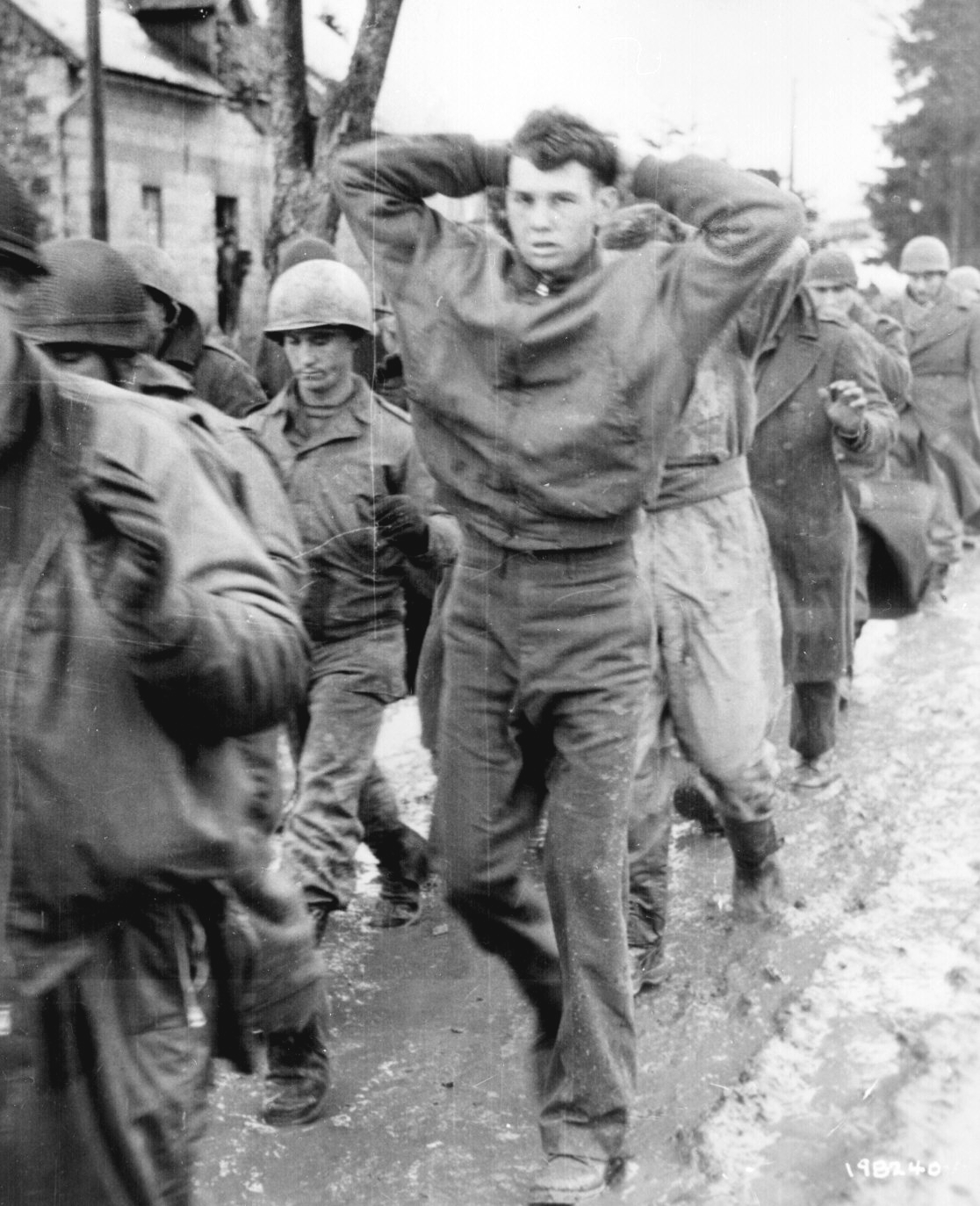
"A lanky GI, with hands clasped behind
his head, leads a file of American prisoners marching along a road somewhere on the western
front. Germans captured these American soldiers during the surprise enemy drive into
Allied positions." Captured German photograph, December 1944.
National Archives
111-SC-198240
Some of the Germans were
now playing by new rules of war
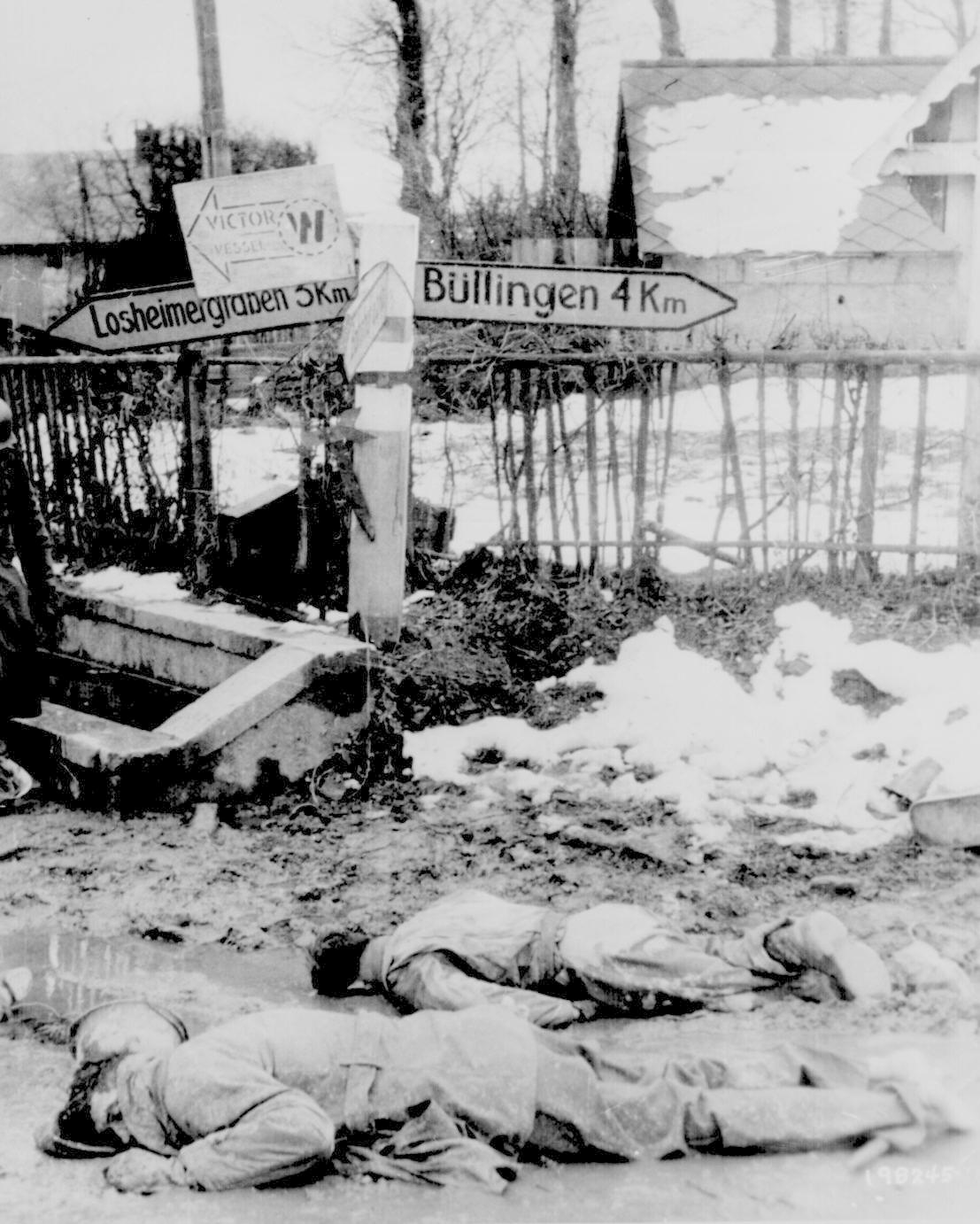
"American soldiers, stripped of all
equipment, lie dead, face down in the slush of a crossroads somewhere on the western front." Captured
German photograph. Belgium, ca. December 1944.
National Archives
111-SC-198245
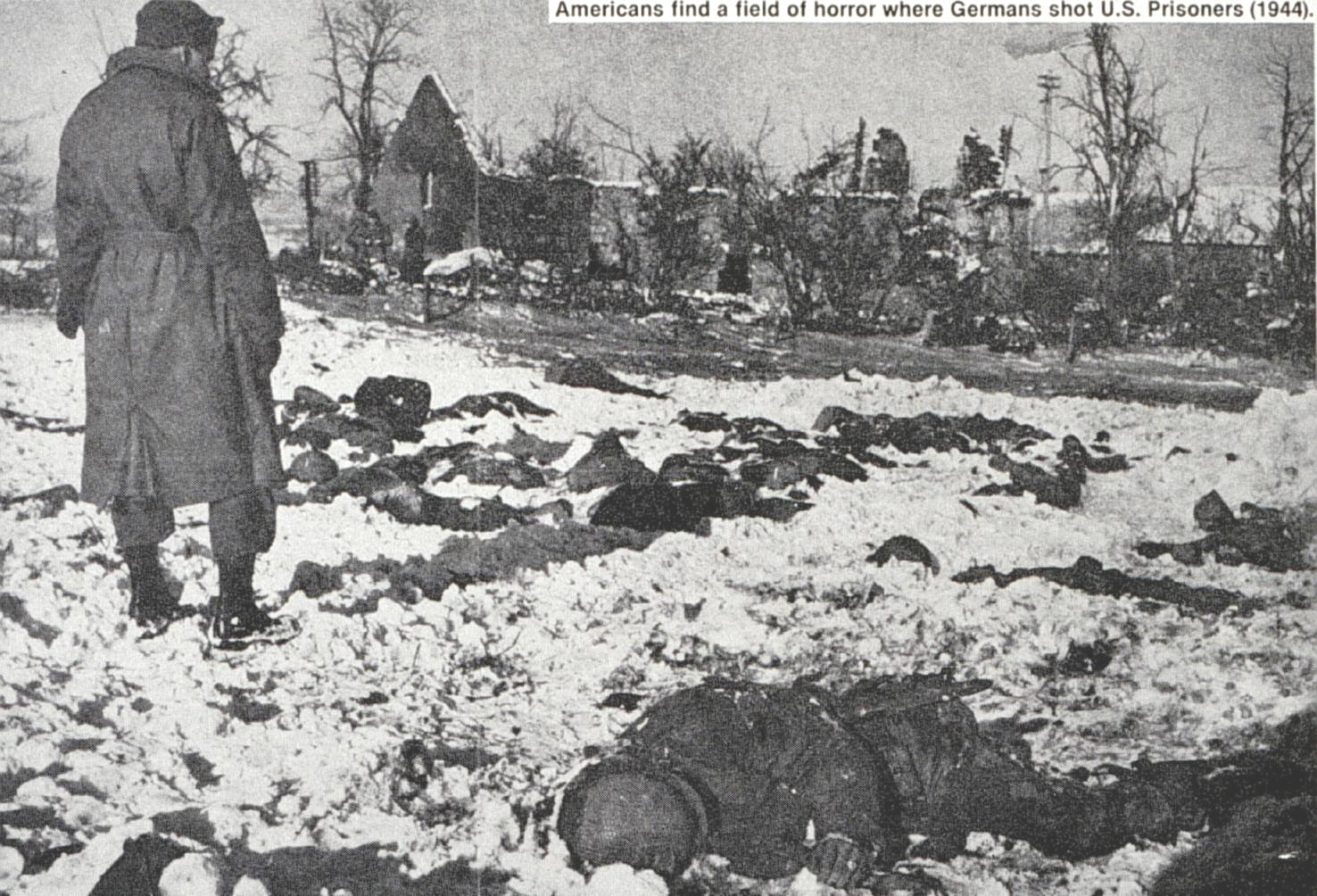
Malmedy
massacre – 84 American
soldiers were killed after their capture by SS troops.
NOAA's Historic Coast &
Geodetic Survey (C&GS) Collection
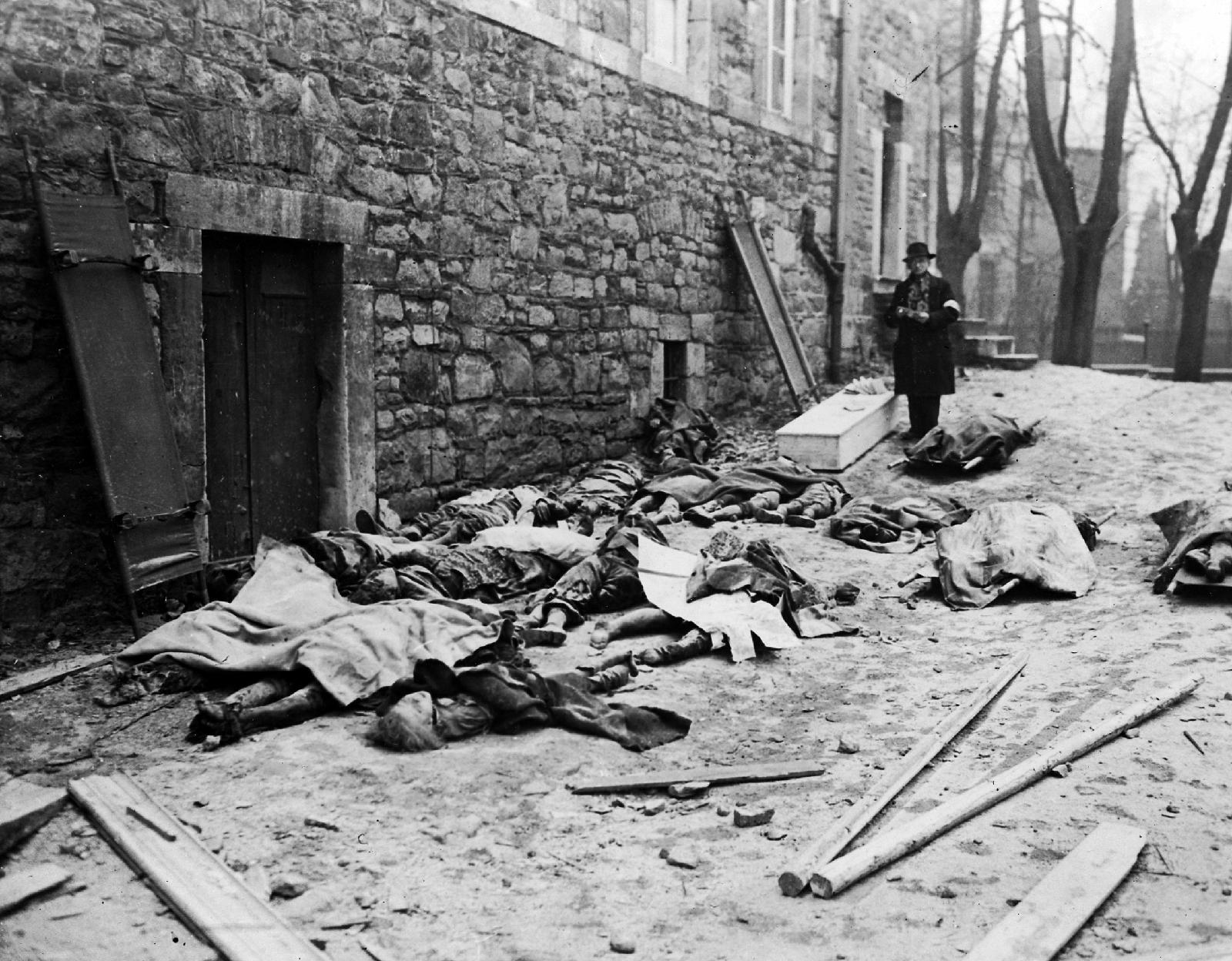
The bodies of
Belgian men, women, and children, killed by the German military during their counter-offensive
into Luxembourg and Belgium, await identification before burial.
National
Archives
But the American line holds
- notably at the town of Bastogne
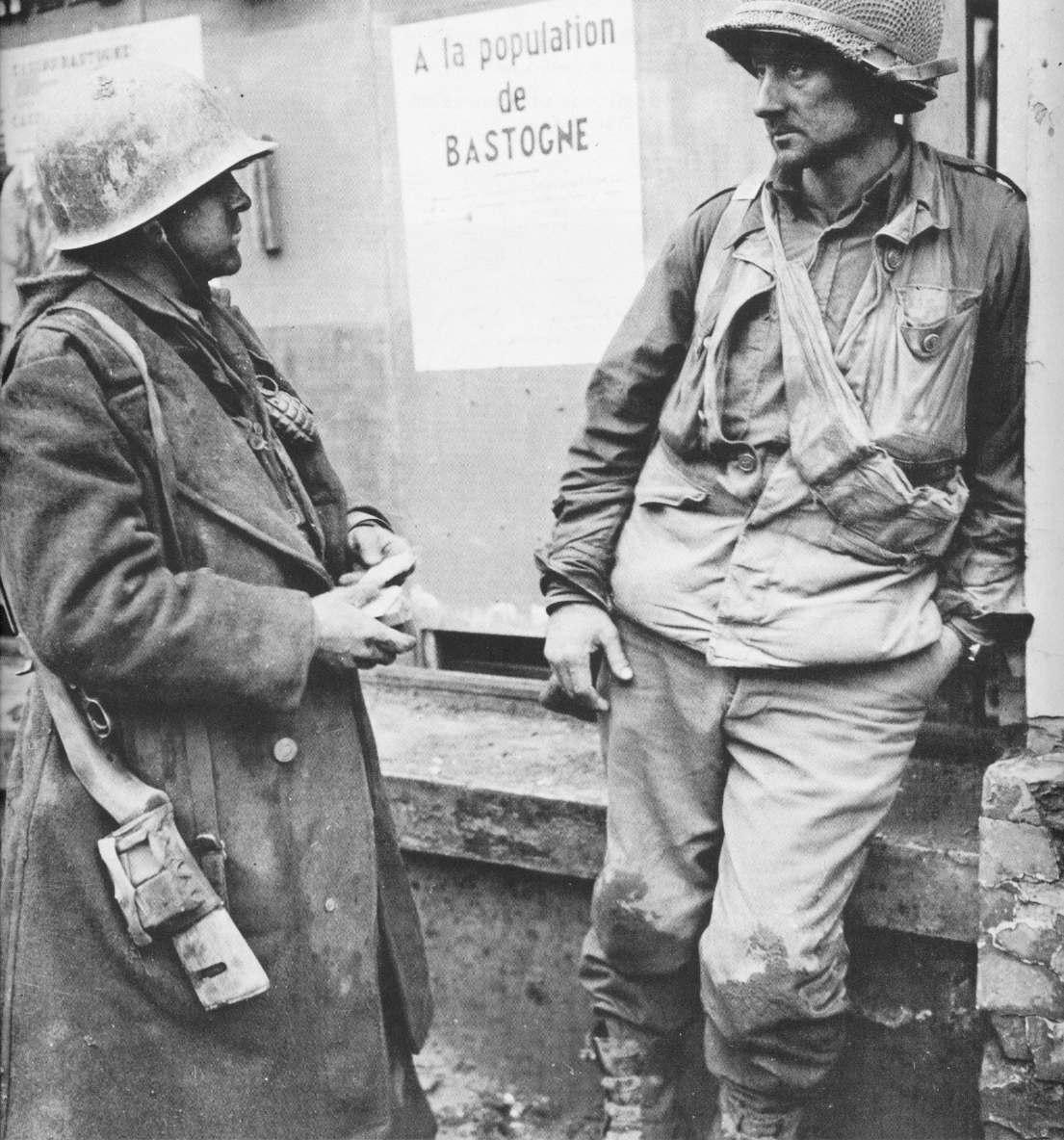
Wearied GIs
trapped inside
the Belgian town of Bastogne during the Battle of the Bulge
United States
Army
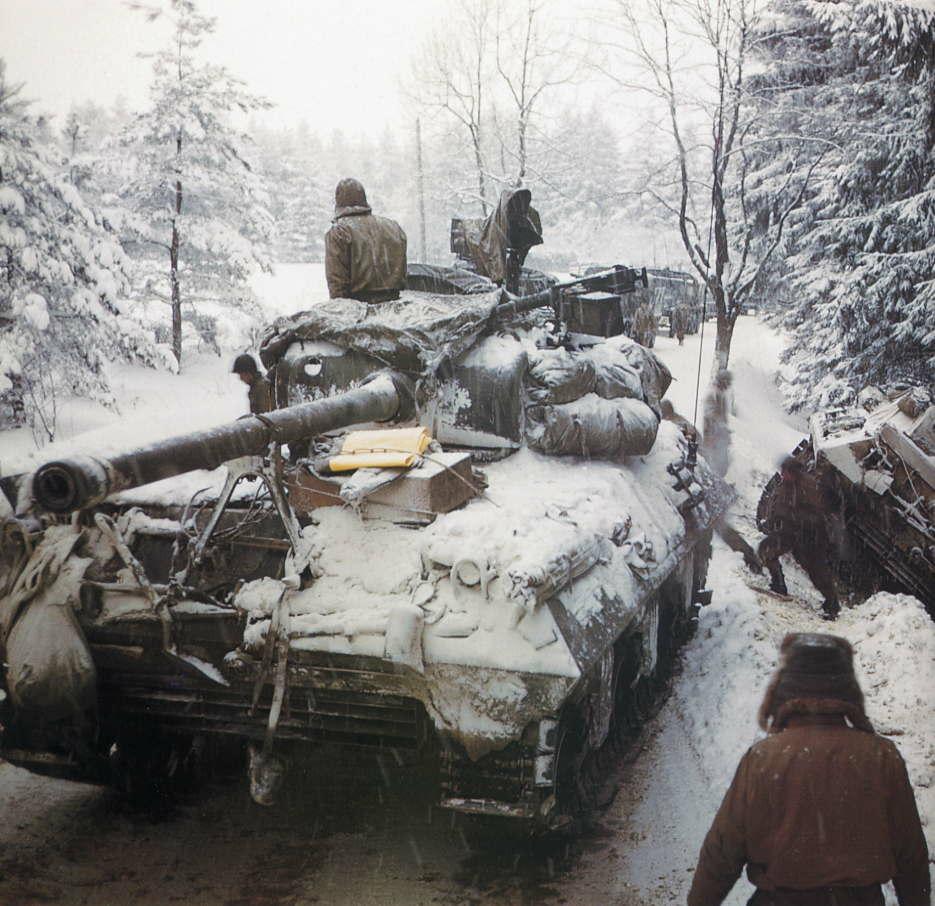
U.S.
tanks moving cautiously
through the Ardennes – December 1944
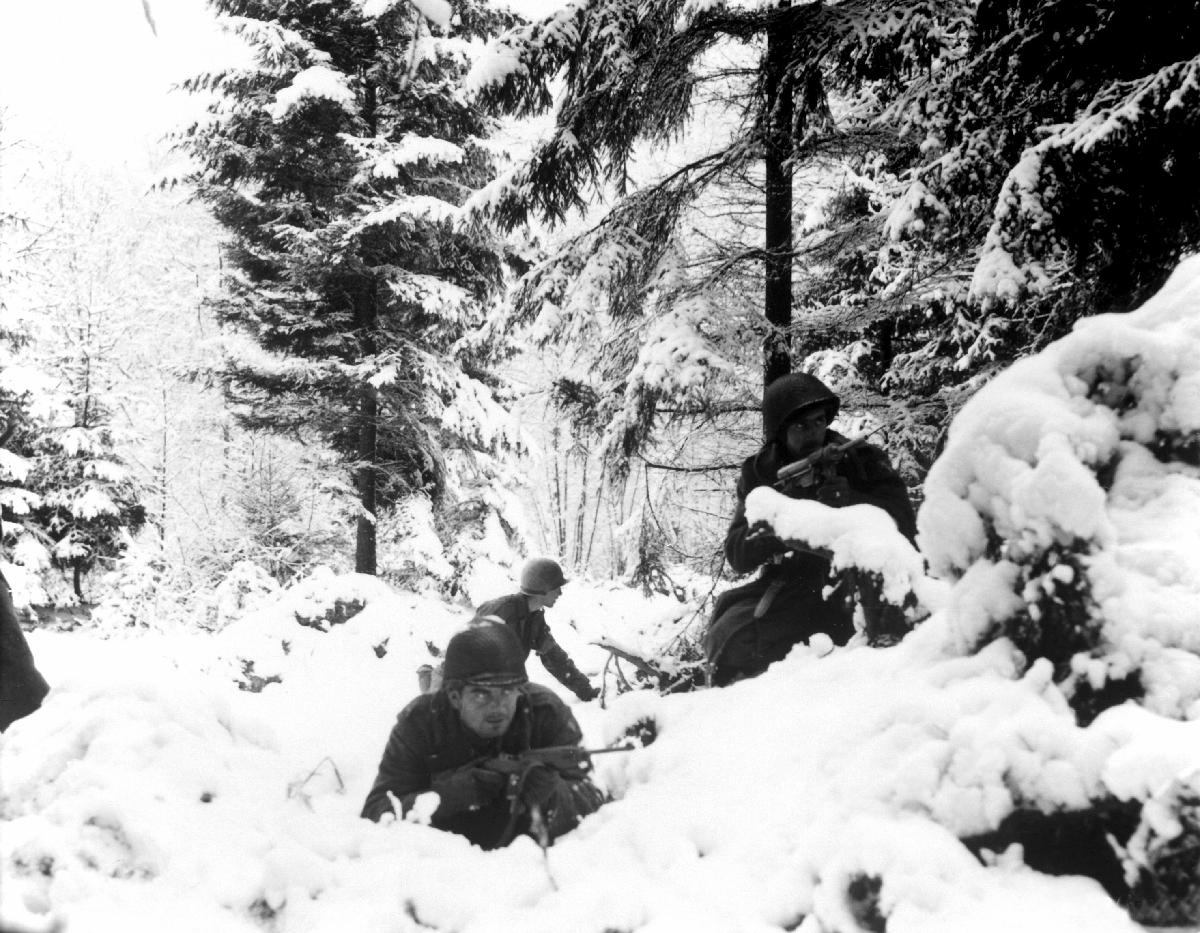
American
soldiers taking
up defensive positions in the Ardennes during the Battle of the
Bulge
National Archives
 U.S.
troops pinned
down in the Ardennes by German troops - December
1944
U.S.
troops pinned
down in the Ardennes by German troops - December
1944
U.S. Army

U.S. 82nd
Airborne
helping to relieve US troops caught in the Battle of the Bulge – December
1944
U.S.
Army
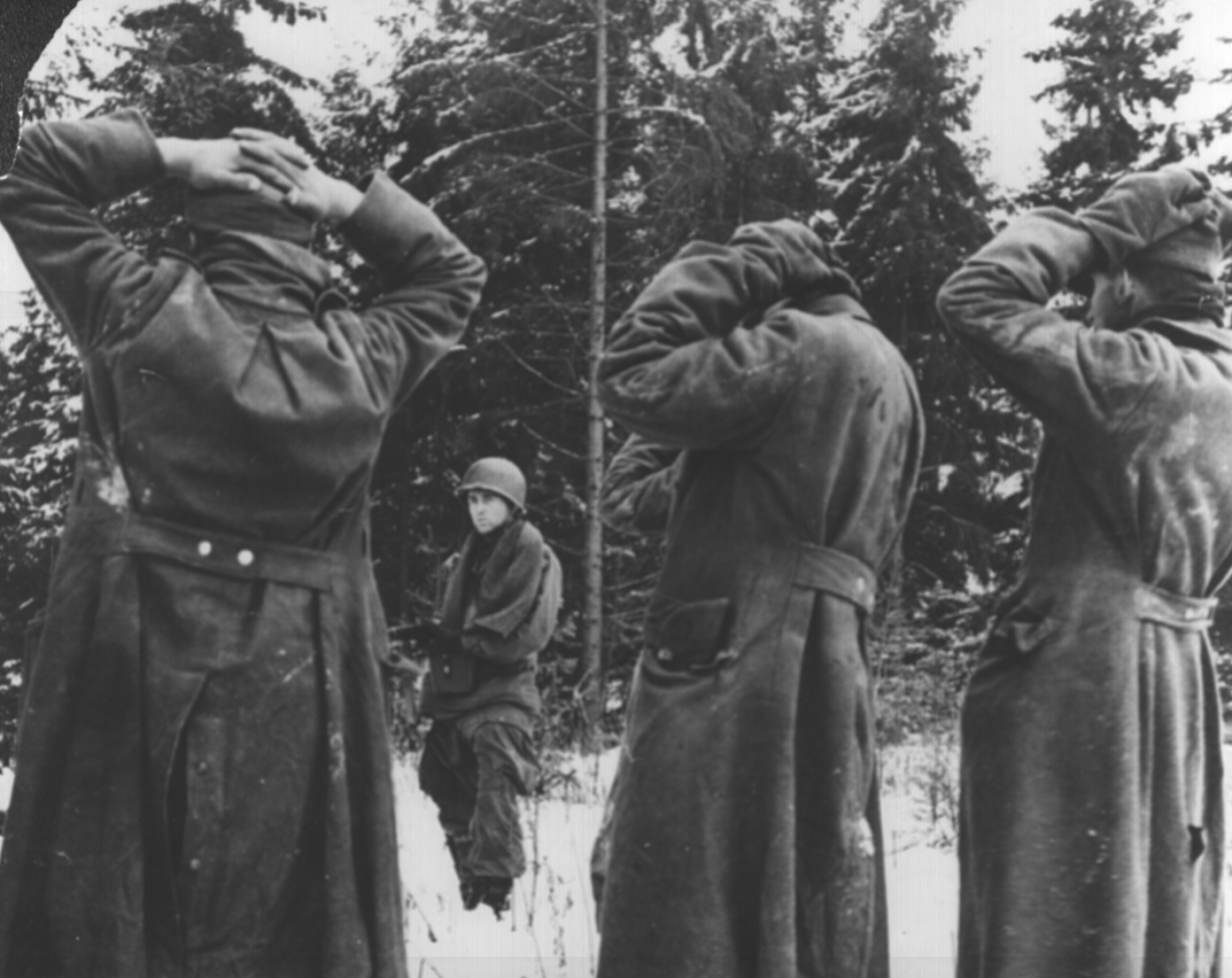
"We were getting our second wind now
and started flattening out that bulge. We took 50,000 prisoners in December
alone." American soldier with captured Germans. ca. 1944.
National Archives
208-YE-105
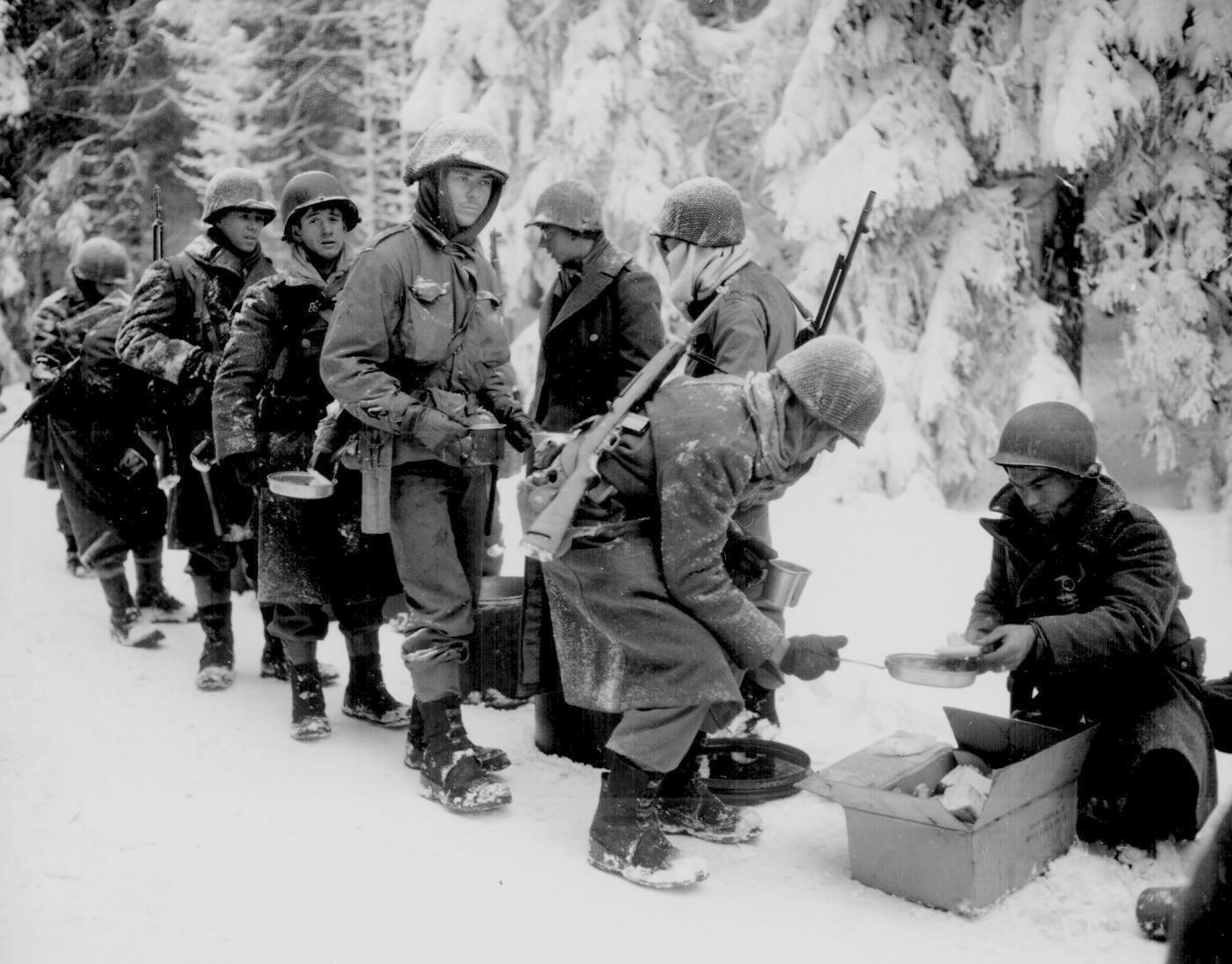
"Chow is
served to American Infantrymen
on their way to La Roche, Belgium. 347th Infantry Regiment." Newhouse,
January 13, 1945.
National Archives
111-SC-
THE WESTERN ALLIES PUSH INTO A FAST-COLLAPSING
GERMANY |
In March of 1945 the
Western Allies
(Americans, British, French, etc.) finally crossed the Rhine River and
were heading rapidly eastward across Germany. In the same month the
Russians captured Vienna (Austria). The end was nearing for Hitler’s
Third Reich.
|
At this point the
Allies Are Streaming
into Germany

"Then came the big day when we marched
into Germany – right through the Siegfried Line." 1945.
National Archives
208-YE-193.
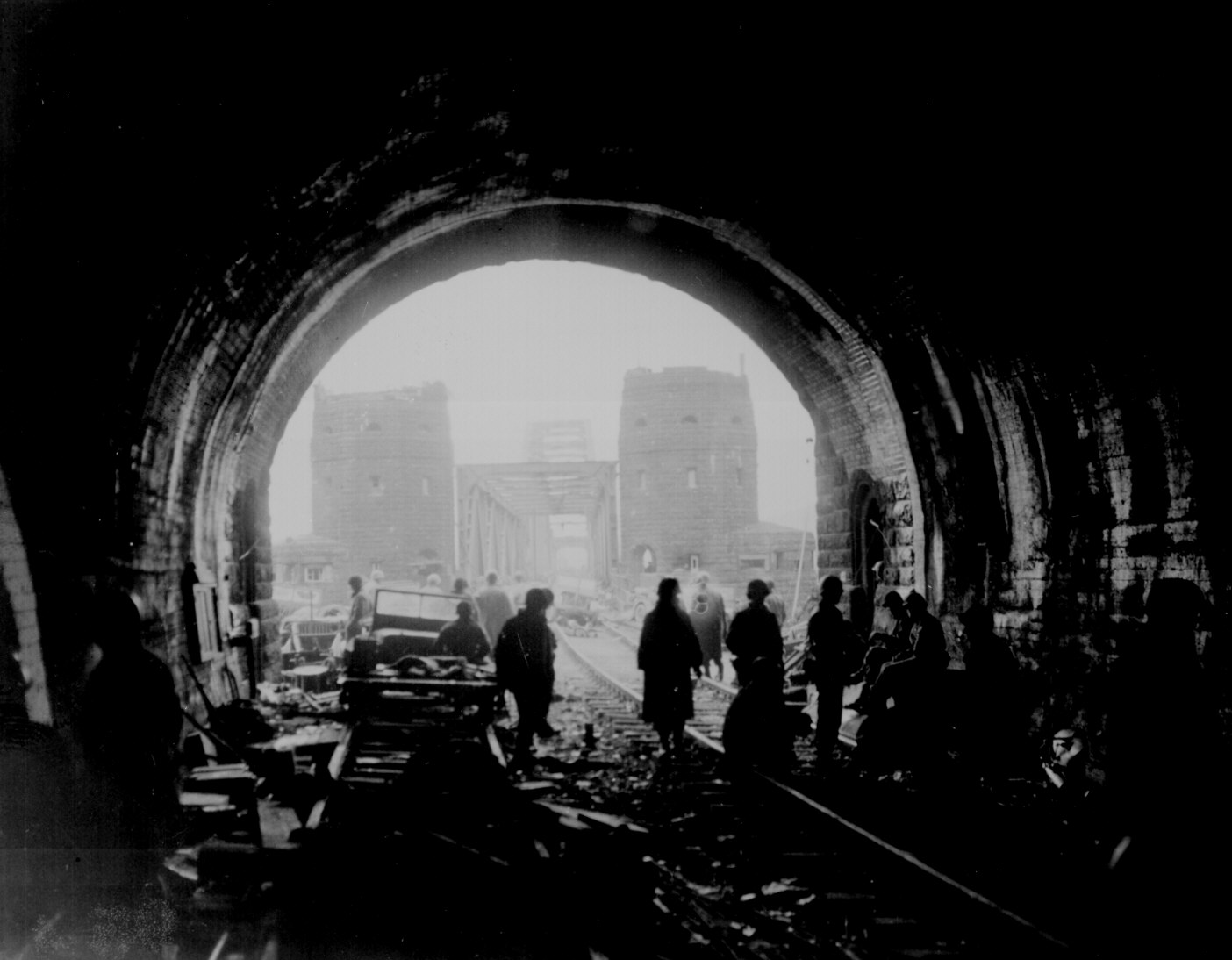
"First U.S. Army men and equipment pour
across the Remagen Bridge; two knocked out jeeps in foreground."
Sgt. William Spangle, Germany, March 11, 1945.
National Archives
111-SC-201973
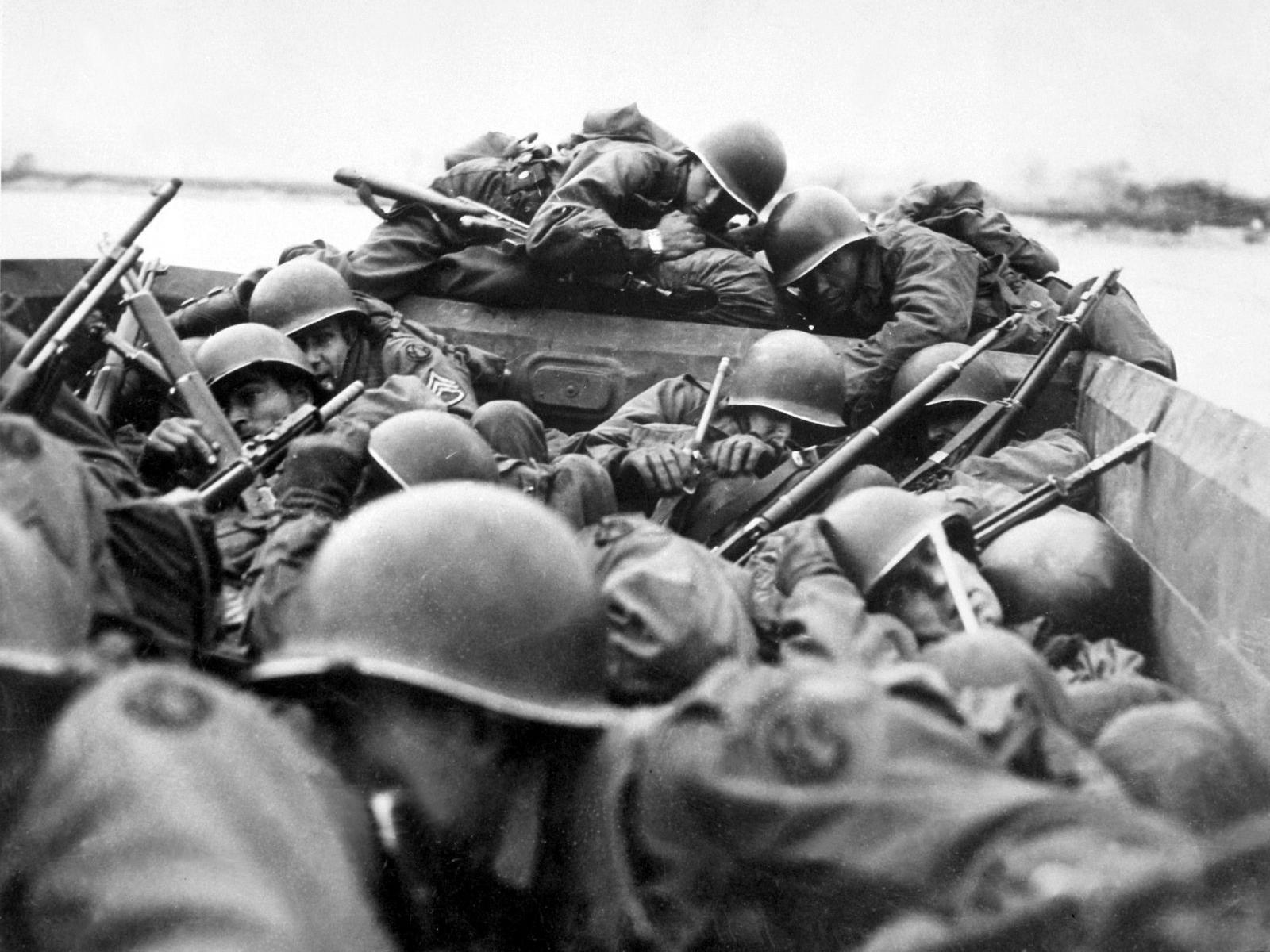
Crossing the Rhine under enemy fire
at St. Goar. March 1945. "I drew an assault boat to cross
in – just my luck. We all tried to crawl under each other
because the lead was flying around like hail."
National Archives
208-YE-132
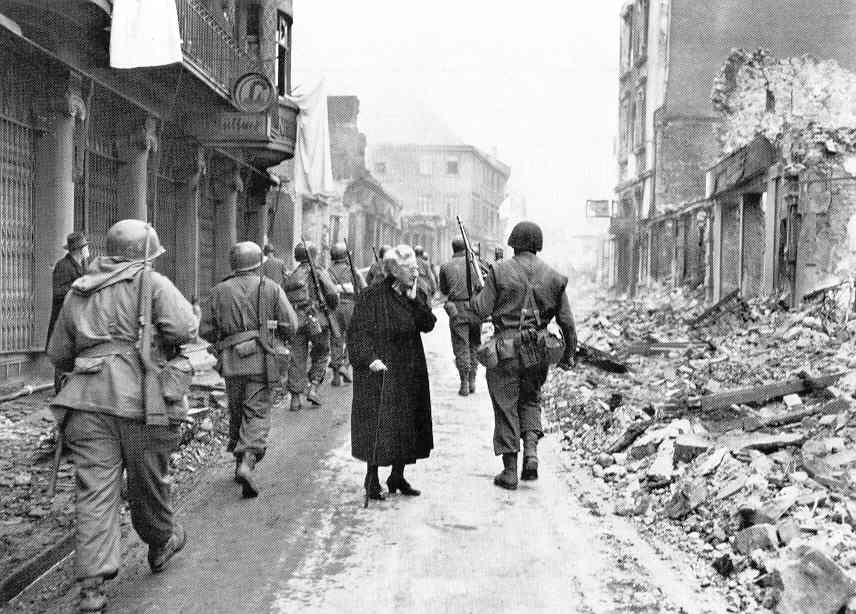
American
infantry moving
through Bensheim, Germany as a woman contemplates the destruction – March
1945
National Archives
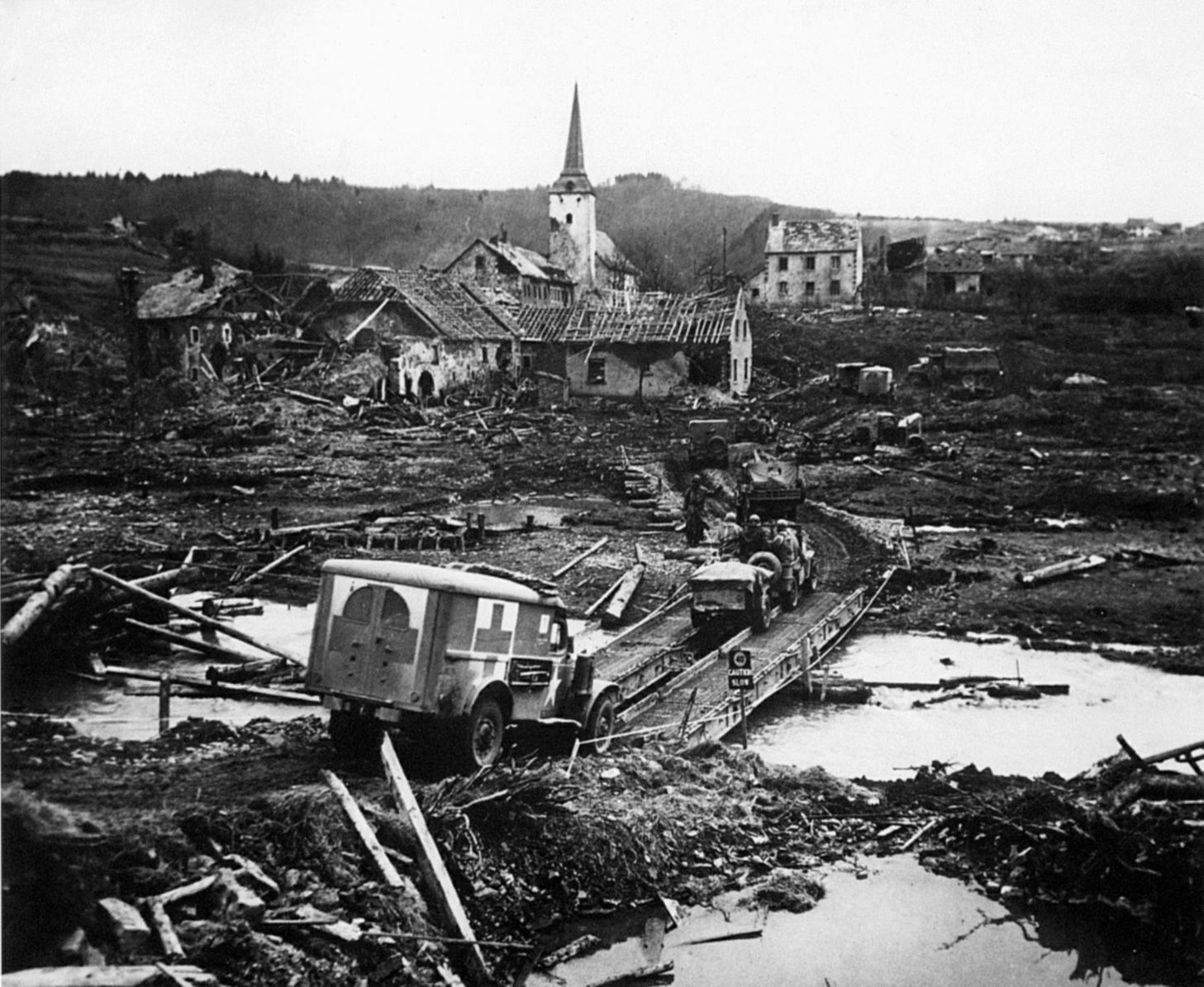
"All this
inanimate wreckage
around us was little enough compensation for the human wreckage we
hauled back and forth, back and forth. Lunebach, Germany" – ca
March 1945 – Army
National
Archives
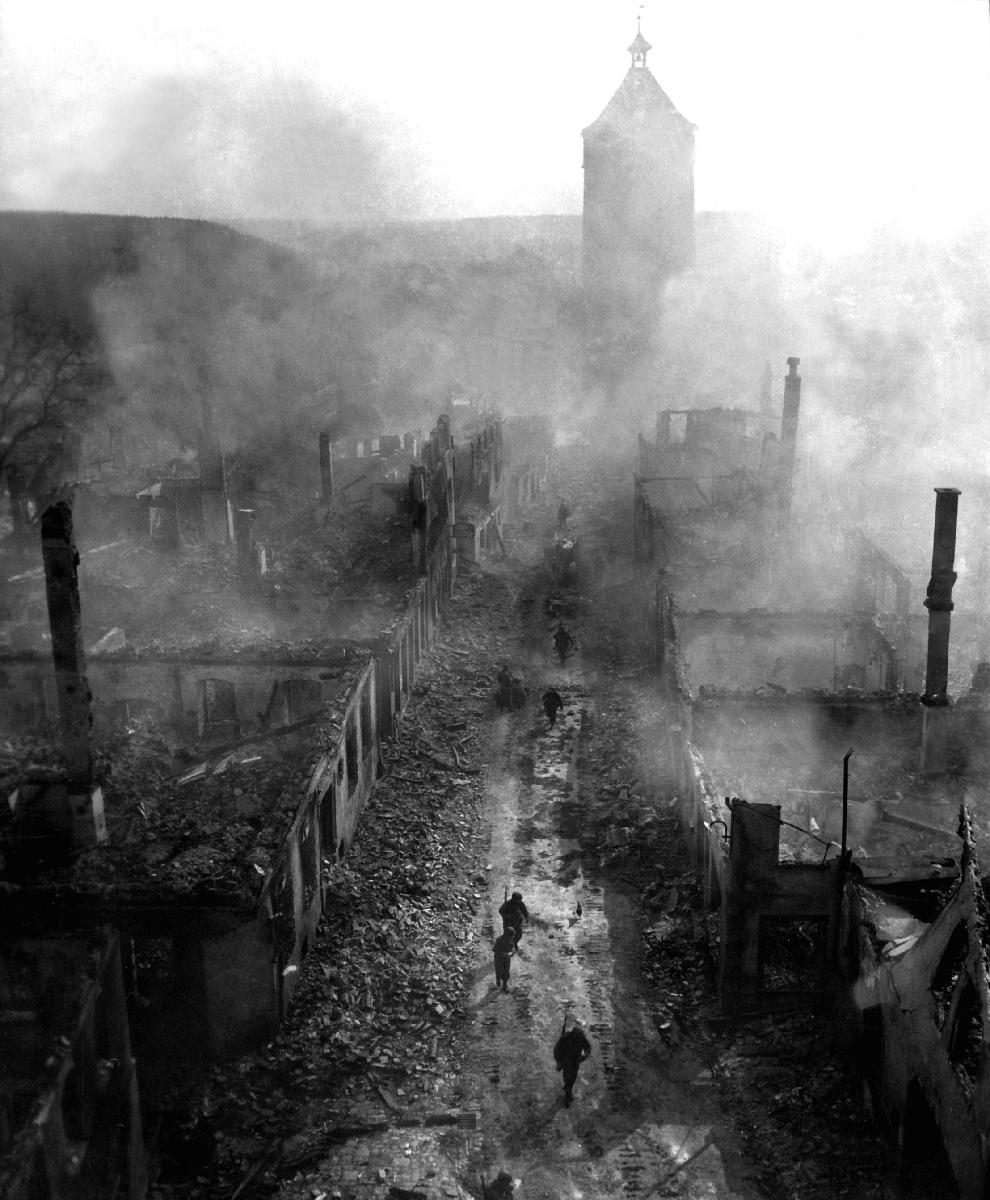
"Infantrymen of the 255th Infantry Regiment move down a street in Waldenburg to hunt the Hun after a recent raid
by 63rd Division." 2d Lt. Jacob Harris, April 16, 1945.
National Archives
111-SC-205778
But the Germans continue to give full account of
themselves in Italy

"Moving up through Prato, Italy,
men of the 370th Infantry Regiment, have yet to climb the mountain which lies
ahead." Bull, April 9, 1945.
National Archives
111-SC-205289
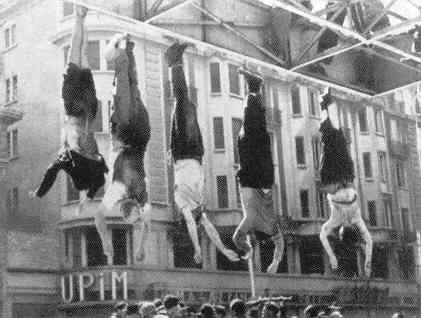 The corpses of
Mussolini,
his mistress Clara Petacci and other Fascists strung up in Milan – May
1945
The corpses of
Mussolini,
his mistress Clara Petacci and other Fascists strung up in Milan – May
1945
U.S. Army Air
Forces
| | | |


 Opening up the Western Front against
Opening up the Western Front against Stopping the Germans on the Eastern
Stopping the Germans on the Eastern The slow Allied advance in Italy
The slow Allied advance in Italy
 The Soviet summer offensive ... and the
The Soviet summer offensive ... and the The Germans hold the line in the
The Germans hold the line in the The Western Allies push into a fast-
The Western Allies push into a fast-



















































































































